|
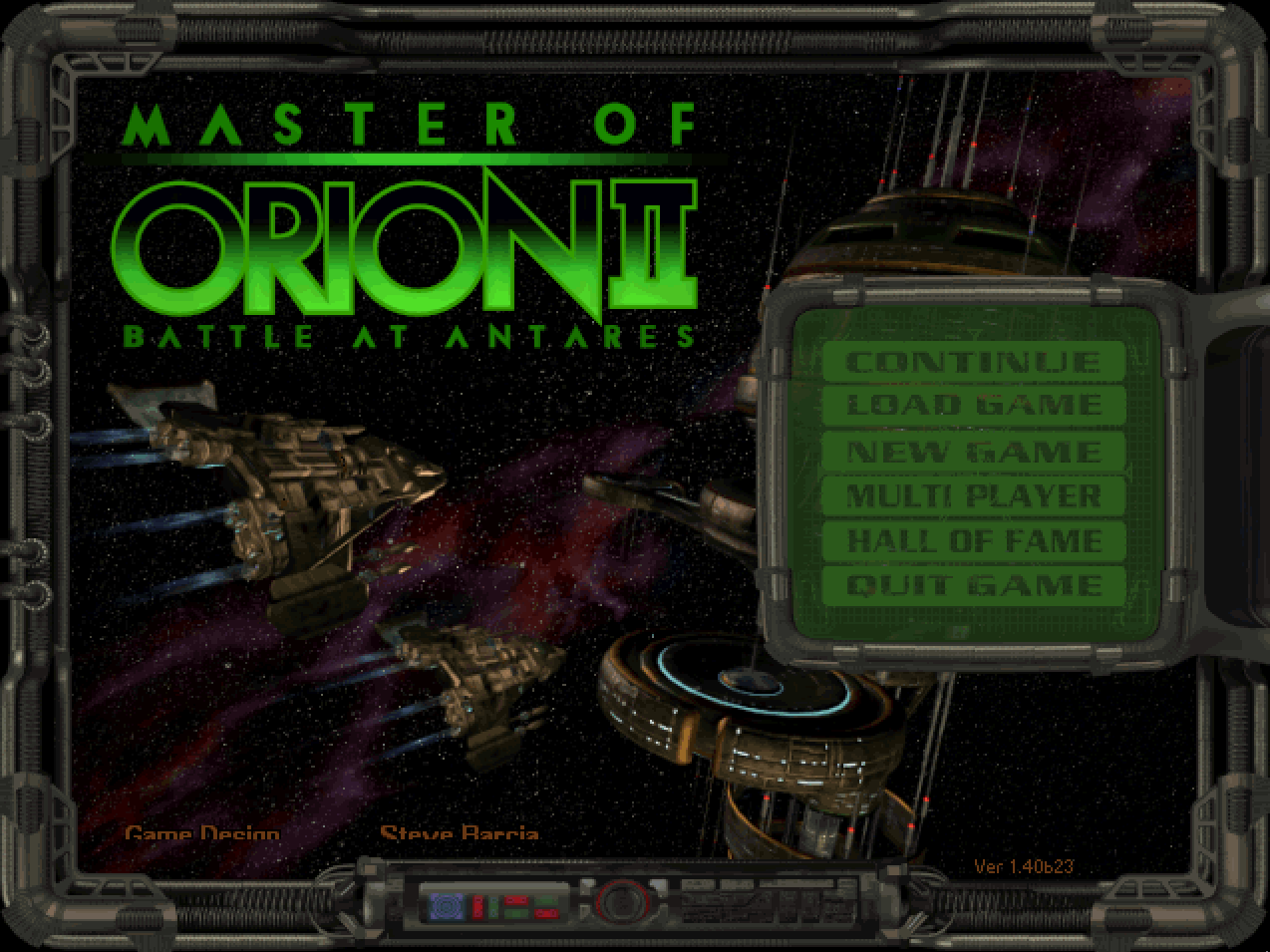 Master of Orion 2 is an old classic of the 4X genre, which I have previously visited in a prior Let's Play: http://lparchive.org/Master-of-Orion-2-(by-nweismuller)/ If you want detailed discussion of basic mechanics of Master of Orion 2, my earlier LP is probably a better introduction to the game. This run through will be focusing on one of the things you can do with the custom race design system. The Narestan people have a long history of relative peace and prosperity, and as their technology advances, they believe that the future shall only be brighter... Spoiler Policy Knock yourselves out- I'm not keeping any secrets this time around. That said, don't necessarily assume you can guess my interpretation of future events. Voting Policy Please bold any votes. Bear in mind also that the Narestans are individualistic to a literally inhuman degree- insofar as they have 'politics' they'd tend to view almost the entire spectrum of Human politics as unnaturally authoritarian and socialistic, and most votes cast will explicitly be glossed as private investment decisions that have nothing to do with their apparatus of law, and should be formulated as such if presented in an IC format. Narrative Conventions Population units, as before, are treated as billions rather than millions, and the starting year will be presented as 400 YE (Year of the Era of Exploration; the beginning of which was marked by the discovery of a major new continent on the planet of Nares). Updates 400 YE-That Blue Jewel, Nares 400-420 YE-New Industries, New Innovation 420-440 YE-Beyond the Luminal Constant 440-460 YE-Horrors in the Void 460-480 YE-Trade and Traffic 480-500 YE-Trade on Alien Shores 500-520 YE-Life in the Machine 520-540 YE-The Years of Isolation 540-560 YE-The Birds and the Bears 560-580 YE-The Changing of Worlds 580-600 YE-The Guardian of Orion 600 YE and beyond-The Beginning of the Long Peace Supplemental Material The Narestan Species and Culture Heavy Lift Vehicles, Orbital Lighters, Freighters, and Communications Probes- Communications and Trade in Early FTL Societies Shipkillers, Laser Cannon, and Attack Boats- The Basic Theory of Void Combat Sedesen Fine Imports Historical Files- The Great Wars on Nares Currency Markets, Insurance, Security, and Adjudication in Narestan Civilisation Assorted Lore Compilation Thanksgiving The Feast: a sequel to Thanksgiving Economic Technologies, Institutions, and Methodologies of the Known Galactic Region, YE 600 nweismuller fucked around with this message at 04:19 on Mar 28, 2017 |
|
|
|

|
| # ¿ May 19, 2024 17:28 |
|
That Blue Jewel, Nares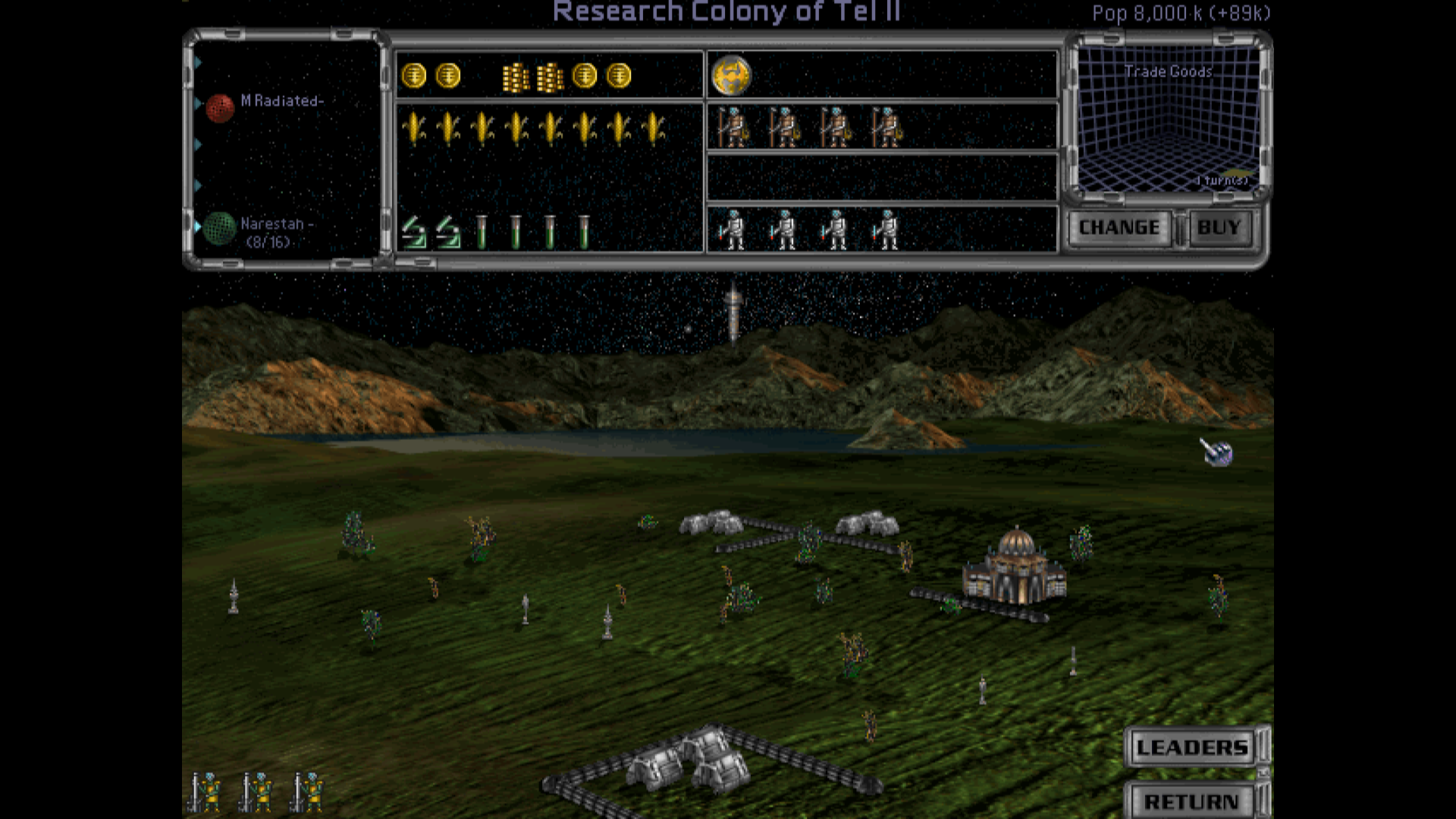 It is 400 YE, and the world of Nares is at peace- as, indeed, it has been for the majority of its existence. The last major conflict of its history was the anti-piracy campaigns of the late second century YE, rooting out threats to shipping in the darker corners of the world. It is difficult to call the patchwork of legal arrangements, security firms, arbitrators, and property holdings that prevails over the surface of Nares a 'united planetary government', but nonetheless a common culture and a common economy prevails. Eight billion Narestans live spread across the surface, with 200 million employed in agriculture and 200 million in research and development, either taking entrepreneurial risks in technological development or working for established R&D firms and departments. Heavy industry on the surface has minimal employment, with most industrial employment being in light consumer industries. Enough investment in industrial machinery to maintain the current industrial and technological base in maintained, but nonetheless at this point investment in current industrial technology is mature. In anticipation of future space exploration, a major shipyard complex has recently been completed in orbit over Nares, even if this may be somewhat premature. There exists no unitary military command for various security forces, militias, and private armed individuals on the planet, although the total number of persons under arms is sometimes estimated as high as 40 million. I immediately sold the starting marine barracks on Nares- don't need it, don't want the upkeep, can use the extra 30 BC. 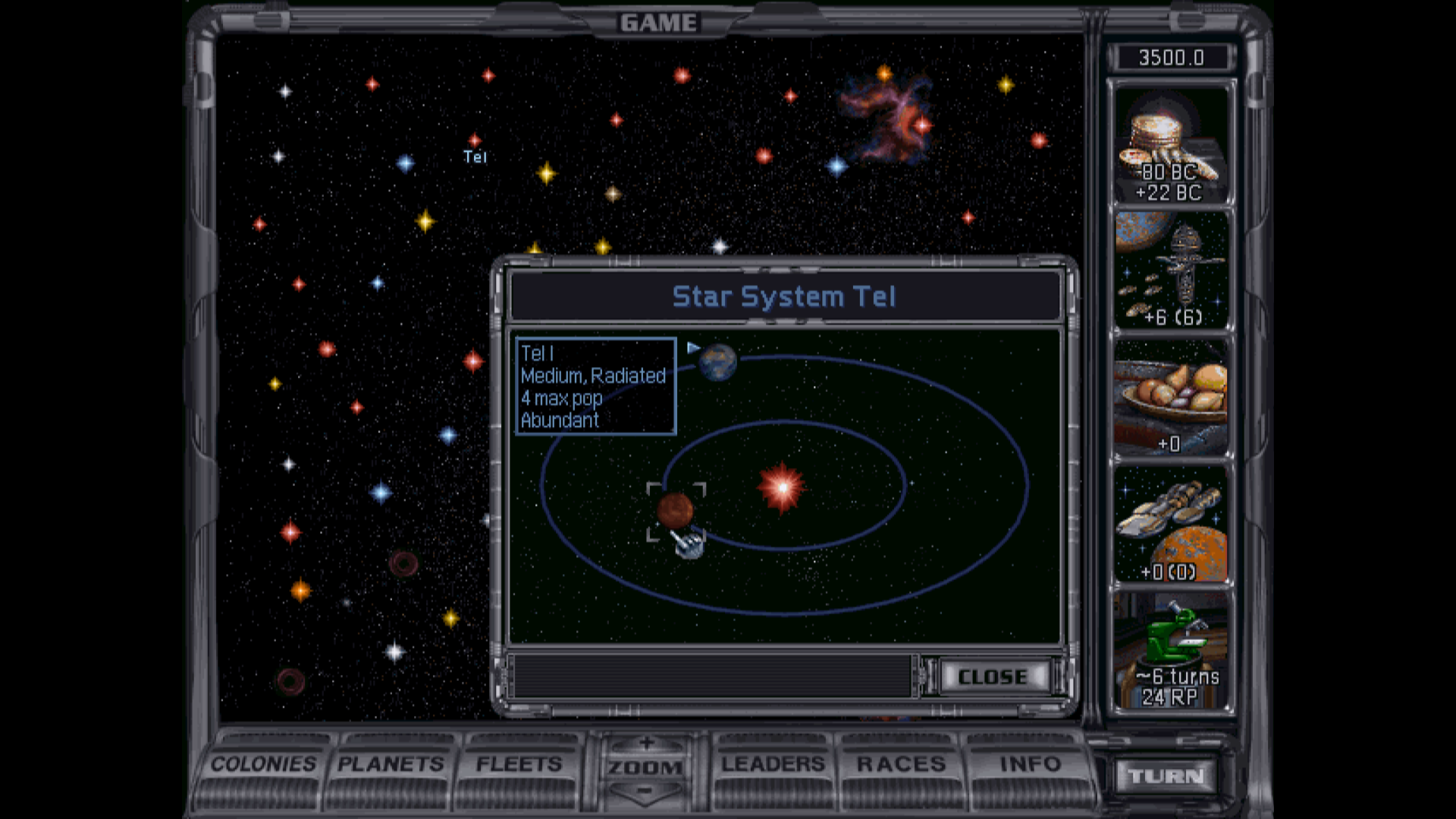 Tel, Nares' cool red star, has a relatively sparse inner system, dominated by Nares, a few scattered asteroids, and the irradiated world of Sedal. Sedal has a hostile, harsh environment, and is smaller than Nares- although some people have imagined exploiting Sedal industrially, the fact is that Nares will be a better home to the Narestans for the immediate future. 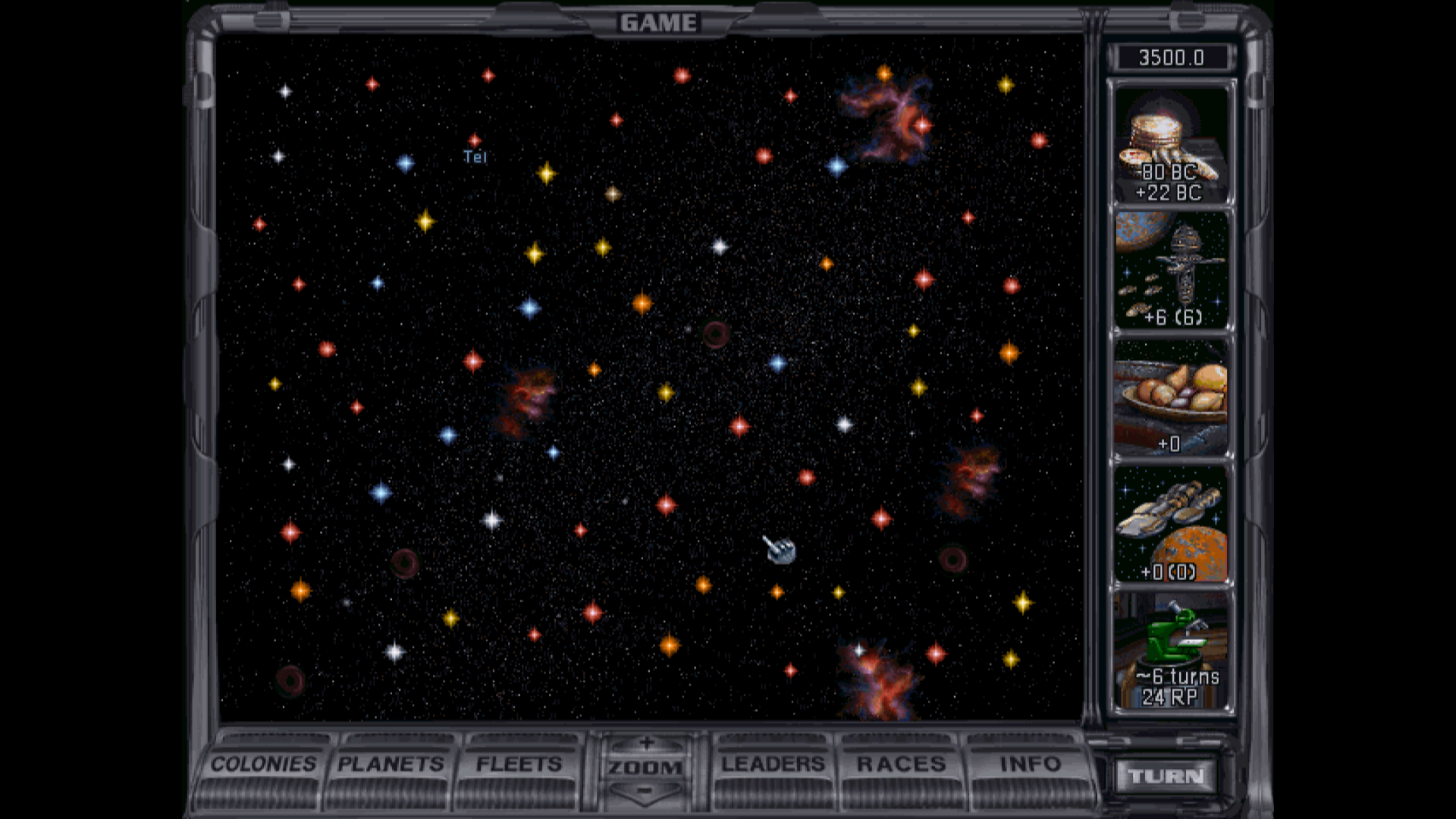 There has been some speculation that the warm yellow stars near Tel may prove to host planets with environments friendly to life, which could be an immense boon to the Narestans if this proves true. Even if nothing of value at all is found, the simple satisfaction of curiosity may well be worth the investment in some investors' eyes. 80 trillion credits free investment capital is available on various exchanges on Nares, with 22 trillion further being accumulated every year. Investment Proposals Engineering Firm Research The primary focus of R&D investment on Nares at the moment is new advanced industrial machinery, expected to bolster the productivity of the small heavy industrial sector and kickstart future development. This is not the only focus of investment, however- various space engineering firms based in the shipyard over the planet have been experimenting with new technologies. High-performance small craft, expected to be marketed as patrol vessels and pleasure craft, experimentation with light space-based weaponry, or redundant hull and safety systems have all been experimented with by certain firms. Our first primary research target is Automated Factories, but we need to pick up a technology on the way. Please vote between Fighter Bays, Anti-Missile Rockets, and Reinforced Hulls. Other Research While much of the current focus in R&D investment is focused on manufacturing technologies, both the agricultural and computing sectors have likewise been seeing significant funding. Viable optical computing is considered a high-value priority for the business and research communities, with various consumer spinoffs anticipated, while the agricultural sector hopes to see advances in automation and hydroponics allowing for substitution of heavier capital investment for current labor needs. Please vote between Research Labs and Hydroponic Farms as our next major research target. Continued Space Research Development of improved spaceframes, power systems, and the development of prototype drives to test the theories of physicists that anticipate the possibility of FTL travel is underway, but progress is slow at the moment, as most focus remains on domestic infrastructural technologies. New technological breakthroughs are on the horizon that promise a massive increase in productivity and wealth on Nares, leaving future generations richer than the Narestans of today, and the investment in new equipment parallels new research such that these new breakthroughs are likely to be implemented almost seamlessly. The future, as it ever has been, seems bright. nweismuller fucked around with this message at 01:54 on Mar 27, 2017 |
|
|
|
The Narestan Species and Culture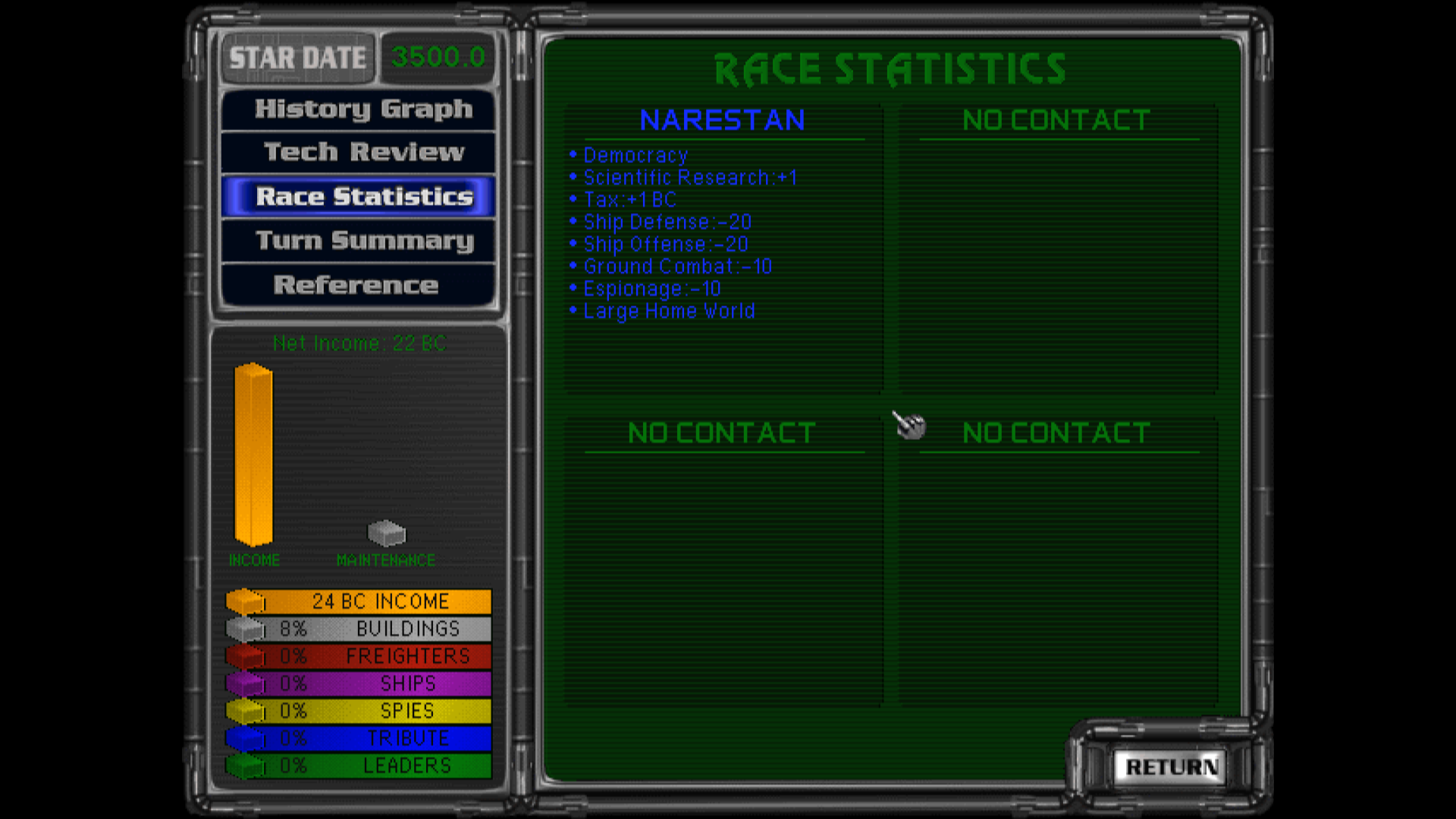 The Narestans are gracile, gray-or black-skinned mammalians with nearly hairless bodies- most of their hair (which is black) is found on top of their heads, somewhat similar to Humans. On average, they are very slightly shorter and rather thinner than Human averages, but have a relatively larger cranial cavity. Psychologically, Narestans are calm, rational, calculating, and deeply, deeply individualistic- by Human standards they would often be considered 'cold' and 'selfish', although likewise fair-minded and essentially entirely free of defects of cruelty, envy, or sadism. They are highly intelligent, channeling this intelligence both into abstract intellectual pursuits and, especially, economic and commercial ventures- the Narestan economy is extremely entrepreneurial, highly innovative, and exceptionally fluidly responsive to consumer demand and variations in real market conditions, enabling a lifestyle of almost startling wealth for the vast majority of Narestans. Narestan risk-aversion and lack of any real spirit of 'patriotism' or 'self-sacrifice' cripples them in military and espionage endeavors- Narestan security professionals in high-risk fields demand immense sums, forcing reliance on inefficiently high levels of automation in those fields. For only one example, reliance on swarms of drones with only minimal manned backup despite the relative vulnerability of drones is typical of Narestan ground tactics. 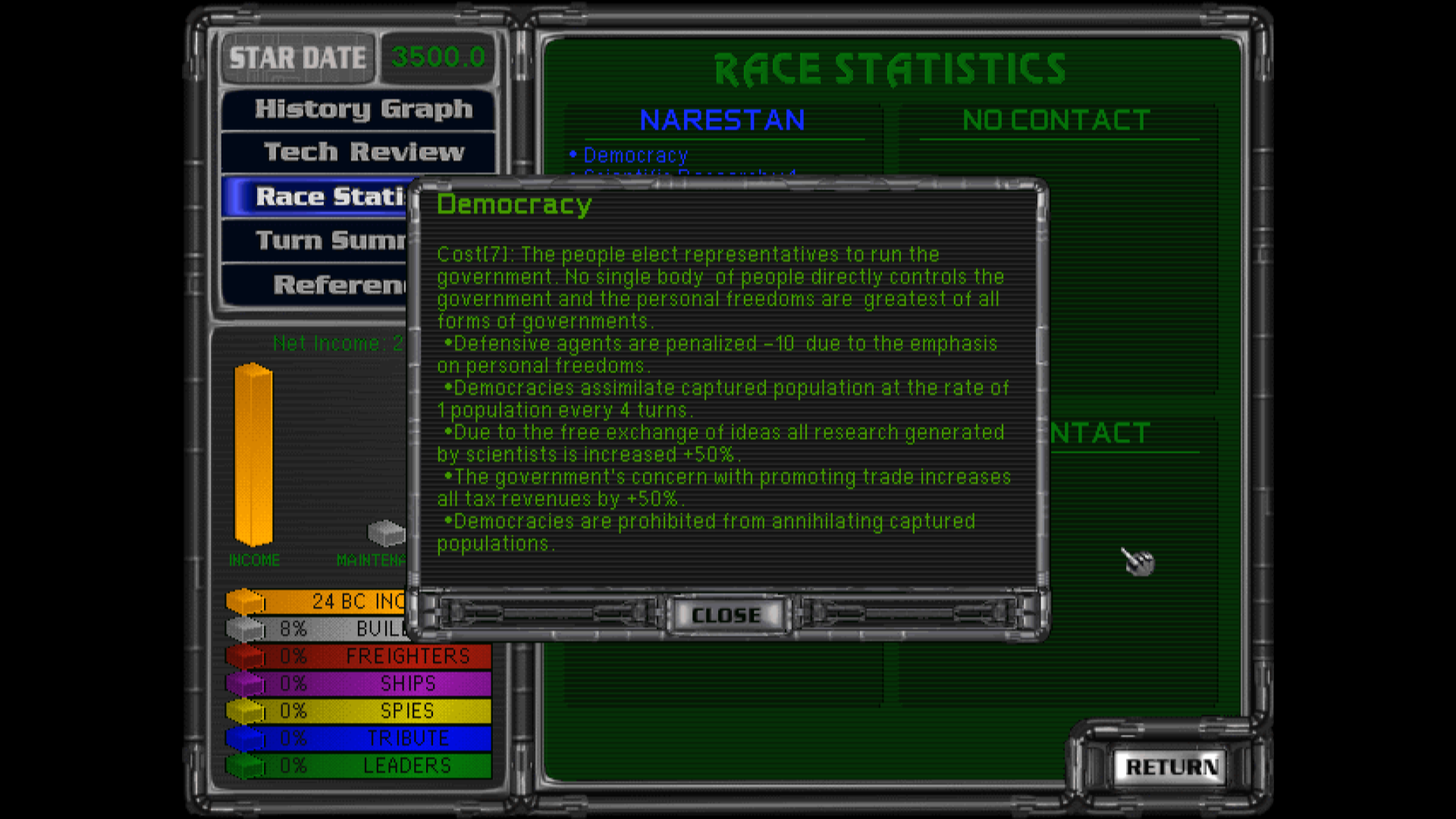 The Narestan 'government' is not, strictly speaking, a 'democracy', largely because it is not, strictly speaking, a 'government'. Widely interlocking series of arbitration agreements and customary law serve as the governing authority over Narestan society, locally enforced by security firms competing on an open market on price and service for the business of other individuals and firms. In the case of disagreement between different security firms, resort to neutral arbitration is typical. Personal and economic liberty in Narestan society is extremely high, while internal security on a society-wide level is largely non-existent. The Narestans are, thematically, the anti-Klackons. Where the Klackons exemplify collectivism, and leverage the percentage bonuses granted by Unification through inherent bonuses to agriculture and industry, the Narestans exemplify individualism, and leverage the percentage bonuses of Democracy through inherent bonuses to science and money. As of the start of the game, with all bonuses accounted for, each Narestan population unit generates 3 BC and each Narestan population unit on research generates 6 RP, tripling and doubling base output respectively. nweismuller fucked around with this message at 01:55 on Mar 27, 2017 |
|
|
|
This LP is running concurrently with a Master of Orion: Conquer the Stars (nuMoO, as I call it) LP at: http://forums.somethingawful.com/showthread.php?threadid=3792079
|
|
|
|
I'll agree that an espionage penalty with Democracy is interesting, but we'll see how it turns out, yes? As far as Fantastic Traders versus the Research bonus- boosting both halves of the Democracy equation was a thematic goal for this, and getting both a research boost and the cash bonus is necessary for precisely the Stupid Tricks I'm about to be demonstrating in the next update. Likewise, I'd rather struggle with a subpar military and security setup than a 25% penalty to output on most worlds in the early game, which will slow me down, and for Hydroponic Farms... let's just look at Nares itself to begin with. Biospheres do nothing for us until that 16 population cap begins to fill, and will allow us to get one extra farmer and one extra worker or scientist, for an eventual total of 9 boring agricultural population units and 9 units of population actually meaningfully contributing. Hydroponic farms let us immediately transfer one population from agriculture to other fields, and can eventually allow a Nares with 7 agricultural population units and 9 other population units. As things spread to an interplanetary society, hydroponic farms help cut down on food transport costs and allow a smaller set of garden words to support population, letting us keep our densely-populated homeworld as a valuable research and industrial center for longer. Yes, it makes for slightly lower long-term revenues once planets fill up, but a lot of what I'm doing is trying to squeeze as much per-capita productivity out as possible, and hydroponic farms get us started faster and keep us running leaner. E: On a totally unrelated and basically irrelevant note: it's bothered me how 'malus' has recently been adopted commonly in English, when there's a perfectly good English word in common use from before that, 'penalty'. Not that it matters and it's basically just me being a crotchety sourpuss. nweismuller fucked around with this message at 03:25 on Sep 30, 2016 |
|
|
|
Ah, something I neglected to mention in my prior analysis of Fantastic Traders versus a research bonus. Fantastic Traders actually isn't helped by either our money bonus or democracy- its 25% bonus to trade treaties is independent of the 50% bonus from Democracy, and the base output from trade treaties before being affected by Fantastic Traders or Democracy in MoO2 is entirely controlled by the total population of the less populous side of the treaty (so isn't increased by the money bonus). On the other hand, the research bonus actually gets multiplied by Democracy, so we're getting more for our effort there.
|
|
|
|
Thanks, Fred. Fixed.
|
|
|
|
My dad, I understand your doubts about my setup, but I ask that you simply wait and see. This is a setup that has worked extremely well for me, and I'd like you extend some trust that I know what I'm doing with it.
|
|
|
|
my dad posted:I just said that one of my proposed changes wouldn't work with the rest of your setup. Fair enough. Sorry if I was snappy; I woke up much earlier than intended this morning and might not be at my very best at the moment. nweismuller fucked around with this message at 16:33 on Sep 30, 2016 |
|
|
|
At 6 to 5, Fighter Bays take it. It's not even a contest between Research Labs and Hydroponic Farms. OK, I'm playing through the update.
|
|
|
|
New Industries, New Innovation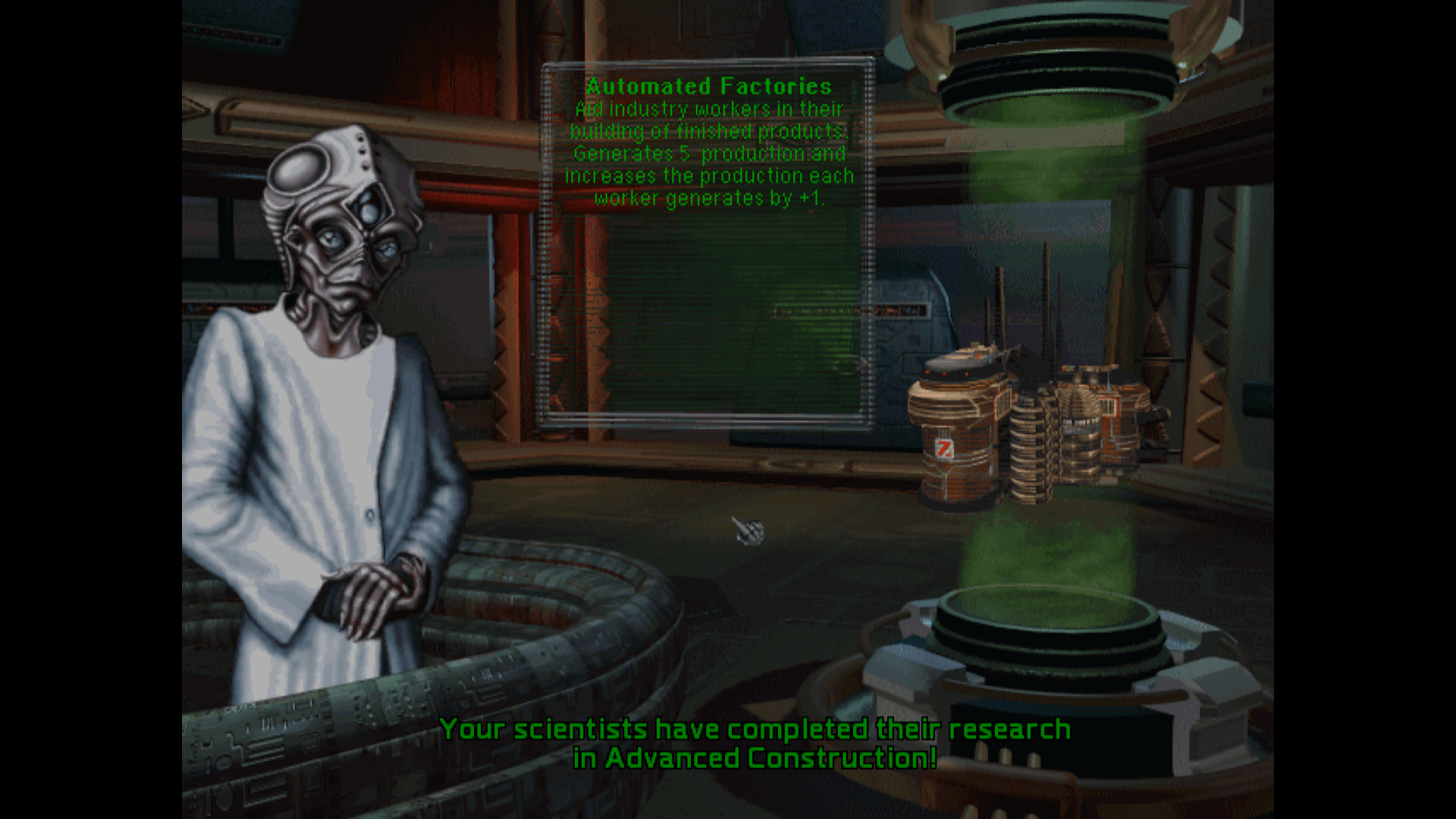 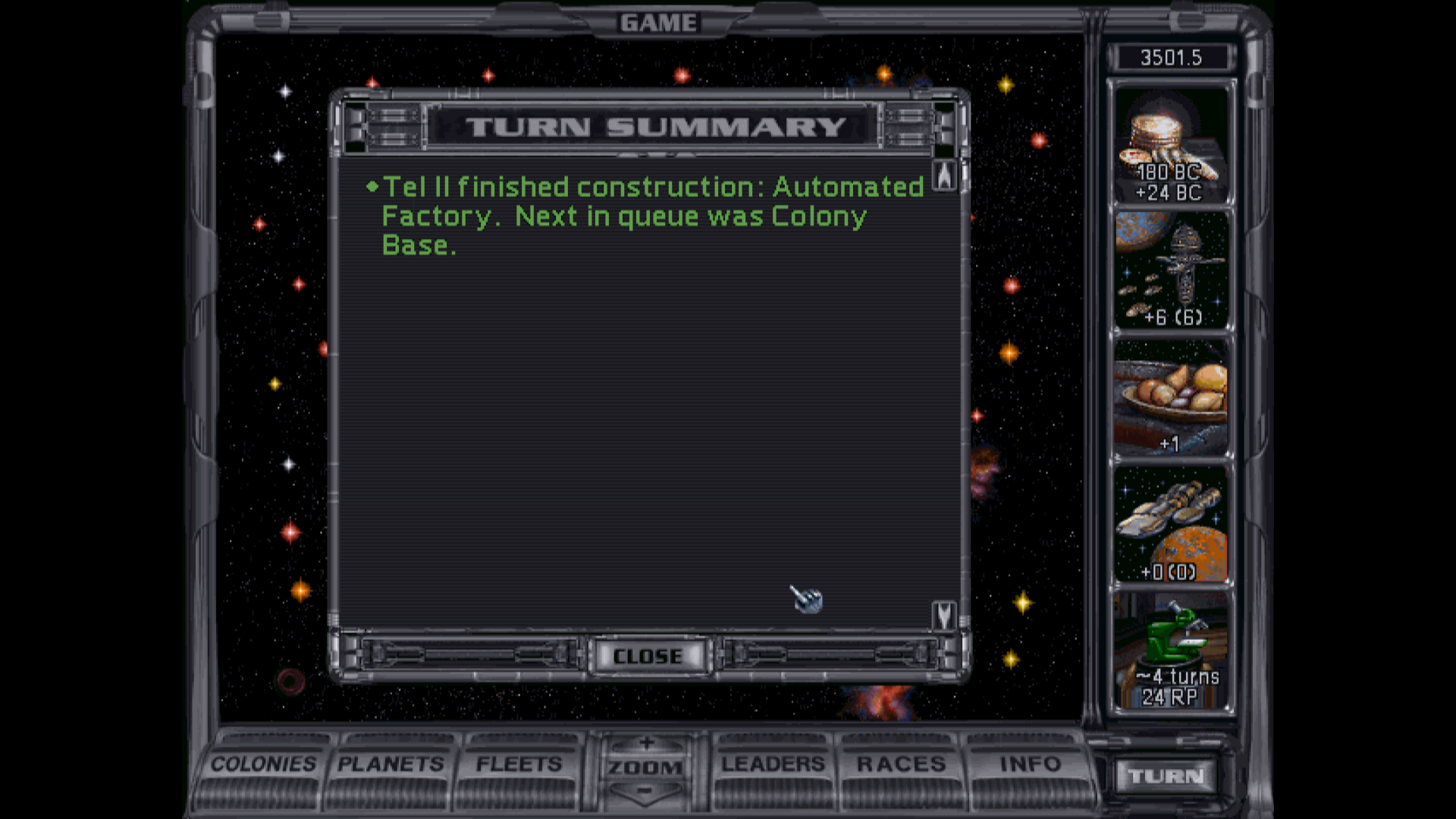 Over the first two decades of the 400s, investment and development of new equipment and methods for industry on Nares proceeded relentlessly, with the industrial base of the planet significantly modernised by approximately 415. Sophisticated robotics far extended the output of the relatively tiny heavy industrial workforce, helping increase the output of durable goods and bolstering the real income of the planet. The dropping prices for hardware led to a steady wave of investment of modernisation in information systems across the planet, tracking the new innovations in electronics that seemed to be coming increasingly quickly as time went on. The prosperity of Nares steadily marched forward. 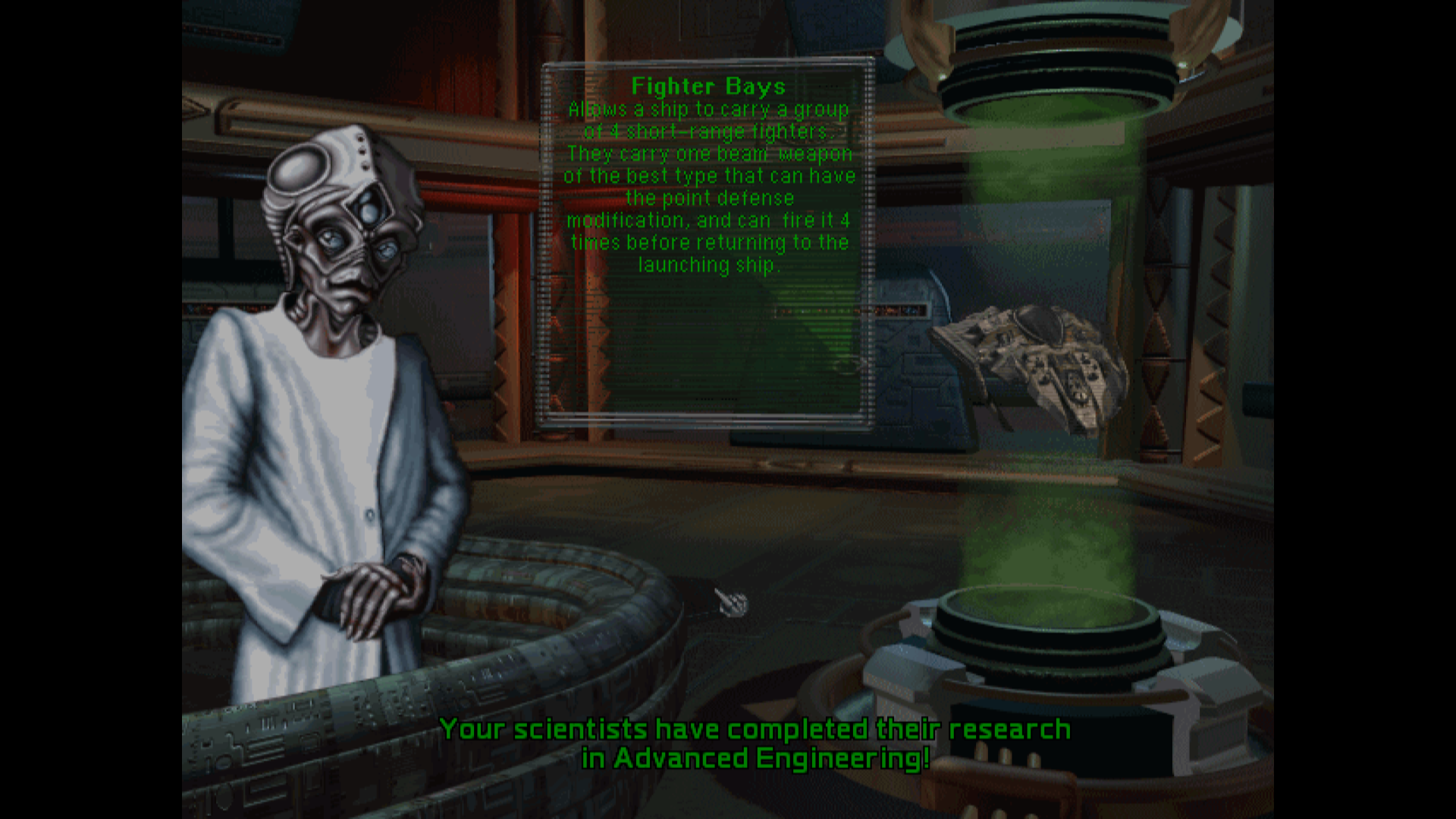 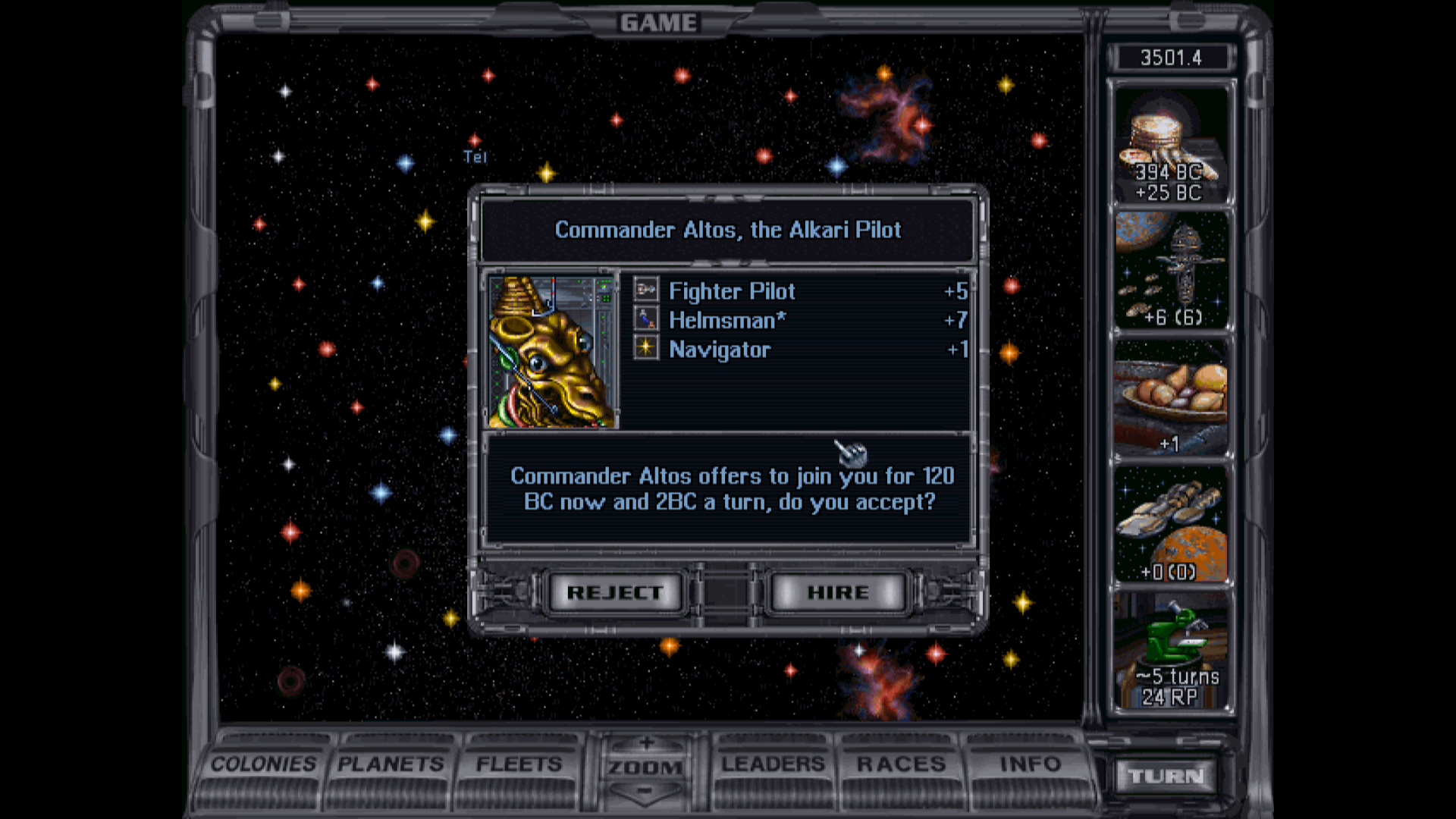 In 406, Salen Personal Vehicles introduced the first high-performance void-ready small craft. These small vessels are primarily engine, with a control chamber mounted on a framework around the spinal engine containing a heavily-cushioned shock couch for the pilot, along with high-output attitude thrusters on the frame. Although these are of little practical use, being unusable in atmosphere and lacking the range for travel outside of orbit, nonetheless orbital flying as a recreation became a passion amongst a significant subculture on Nares, with professional racing and precision maneuver demonstrations emerging within a decade of the introduction of the craft. Fighter Pilot will improve both offense and defense of fighters in the fleet with this leader, while Helmsman improves the defense of actual ships. Not a bad leader with a Fighter Bays start. 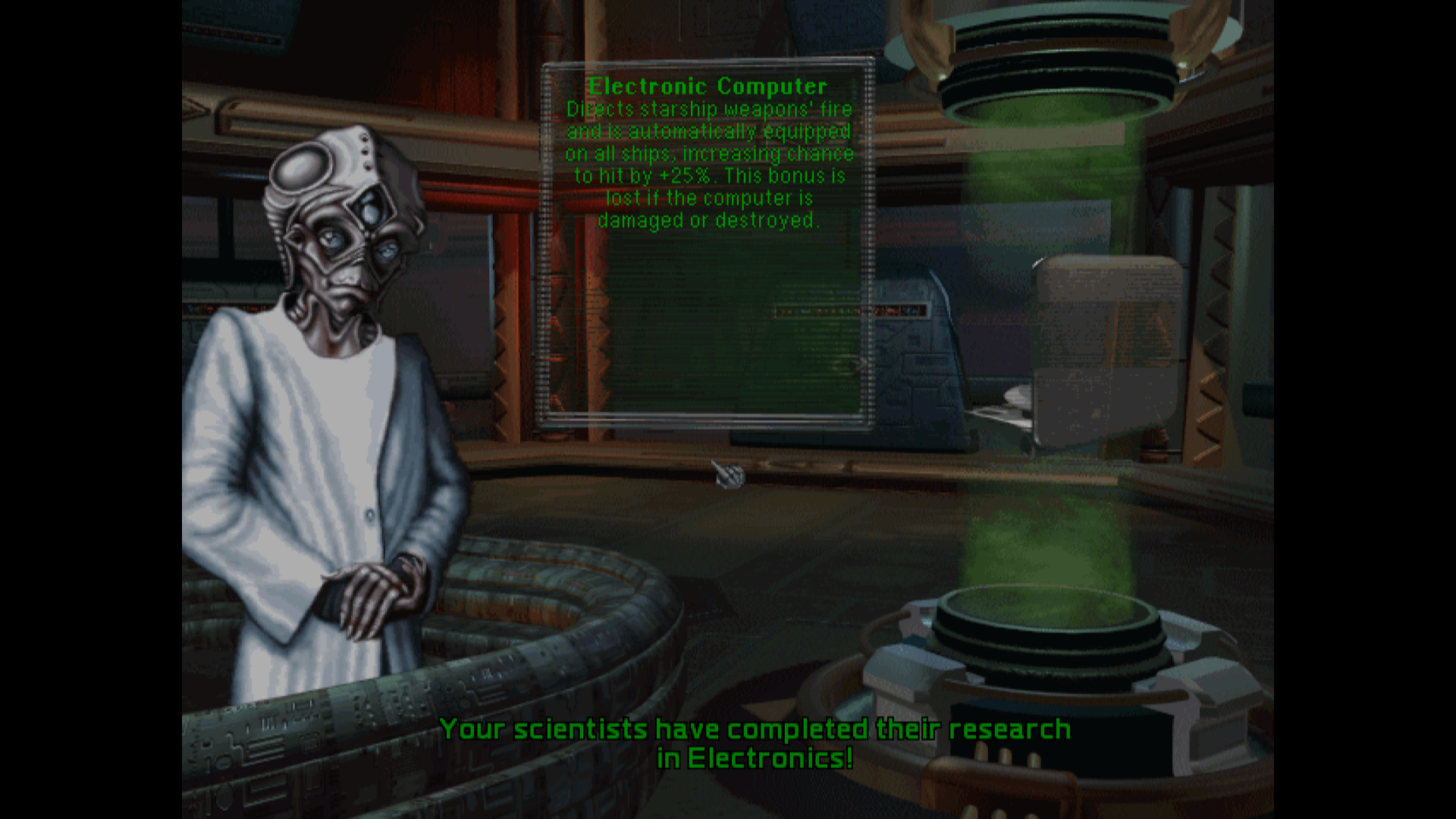 Continued improvements in electronic and computing technology led to a new generation of guidance computers for small craft by 418, along with many incremental improvements in existing consumer and business computers and electronics. Experiments into efficient and effective optical computing are already underway, and are expected to totally revolutionise the computing industry on Nares when they are unveiled. Narestan Civilisation as of 420 YE 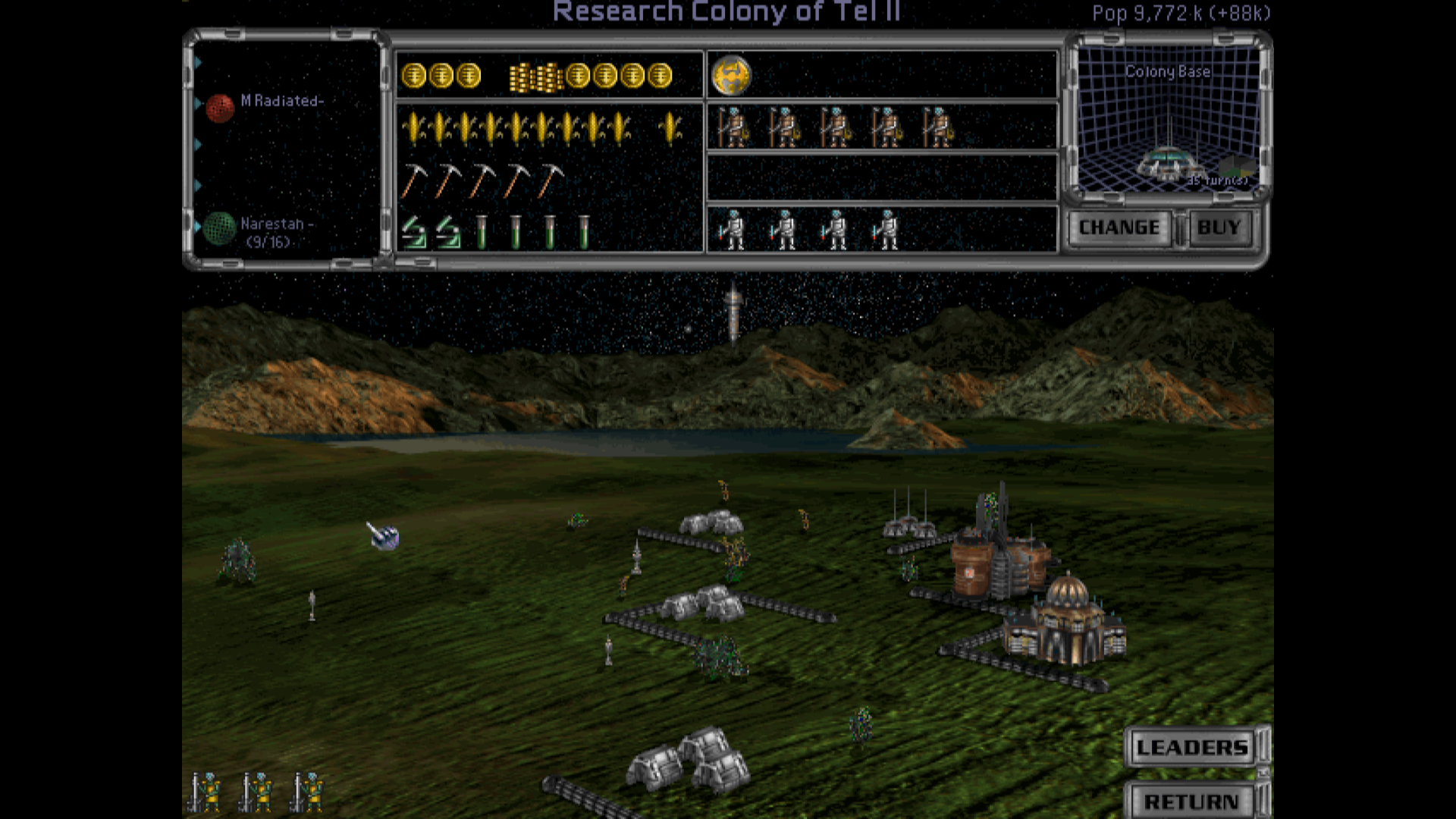 Nares now has a population of nearly 9.8 billion persons, with an agriculture sector now employing an estimated 250 million to support the growing population. Real prices of durable goods have fallen with the revolution in industrial technology on Nares, while the new industry of personal voidcraft has appeared from nothing within the past 15 years. Powerful and compact computing technology has begun to be more pervasive than it already was in the Information Age society of Nares. Incremental investment in new technology should minimise the time needed to implement optical computing on a wide scale when it finally becomes practical. Now that we have 5 production per turn on Nares, we can save it up for future improvements. Because of the way production switching works in Master of Orion 2, using a Colony Base as a store of production in the early game helps us more efficiently get early improvements in place, which is something of a big deal this early in the game. 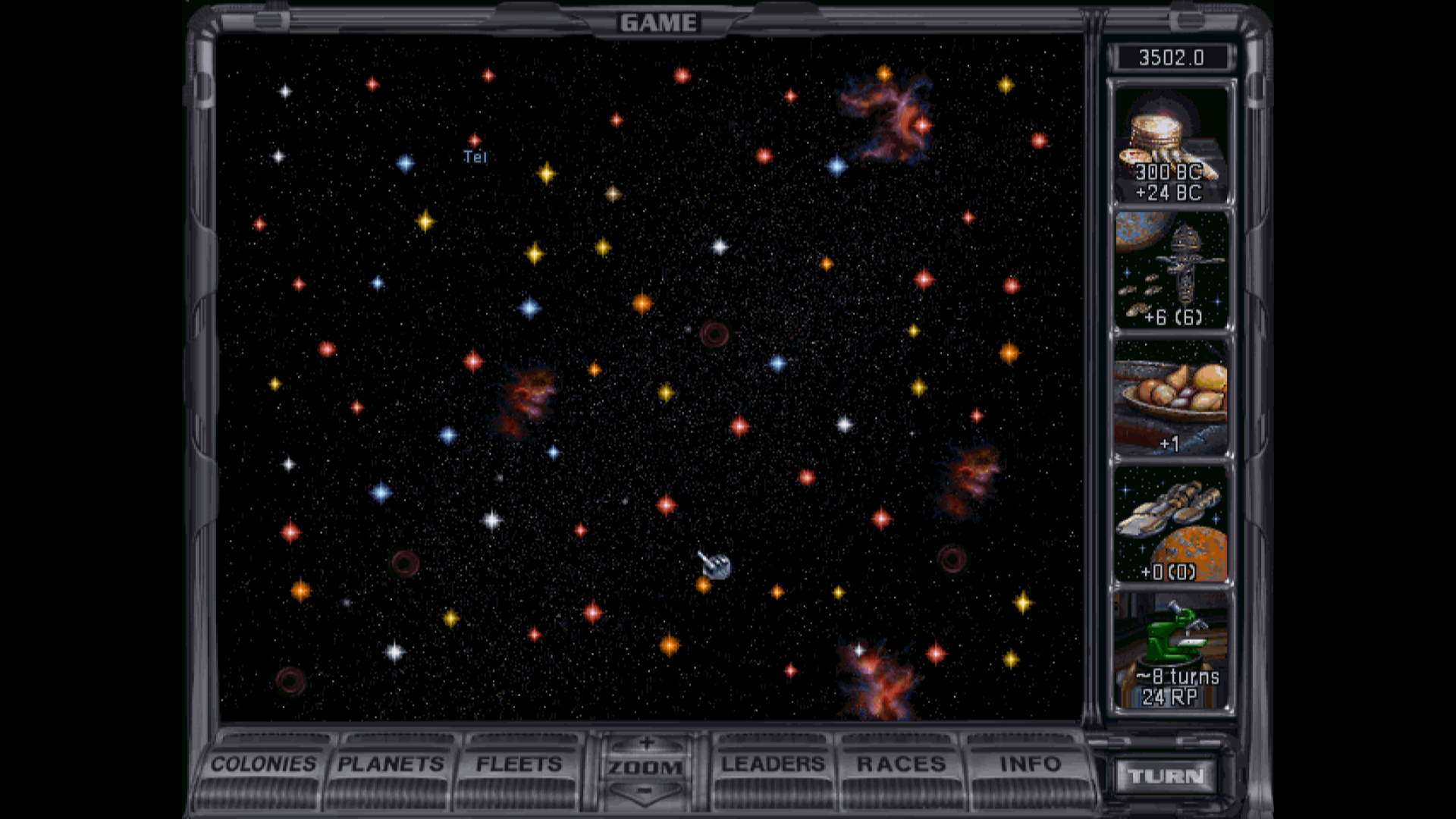 Innovation continues at a similar pace as it has for the past two decades, rapidly bringing new technologies and new applications, given the heavy investment into R&D and the rapid adoption of new ideas and new devices by the Narestan populace. Investment capital continues to accumulate, with 24 trillion credits being saved up per year. Despite the activity in the orbit of Nares, Narestan activity still remains firmly focused on that single planet, for now. It is anticipated that the next decades will bring new and significant changes to the planet, but only time will tell what the future will bring. Investment Proposals Void Piloting Sporting Leagues Interest amongst both prospective pilots and audiences in high-precision voidcraft events is high, although it is possible that audiences could grow even larger. With sufficient revenues to support high-grade training and equipment, the development of Narestan piloting talent and a tradition of void flight could be greatly accelerated. All this, ultimately, depends on just how popular these sports are. Please vote on whether to hire our new expert pilot leader. Space Technology, Exploration, and Colonisation As Nares grows more developed, its ability to support large-scale space exploration and colonisation will grow steadily greater, and large-scale investment into space technology is likely to happen within a decade, following anticipated revolutions in computing and agriculture. That said, whether Narestan investors and colonists will focus on an immediate drive to colonise Sedal or focus more heavily on exploration of nearby stars in hopes of better prospects first remains uncertain. Colonisation of Sedal is likely to be considerably cheaper, but Sedal itself is a planet of only modest attractiveness. Please vote on colonisation of Sedal as soon as we have the technology and infrastructure in place to support it, or focus on immediate scouting in hopes of better worlds. Changes are slowly accelerating on Nares, and slowly its people look to the stars as the last barrier to their ambition. nweismuller fucked around with this message at 02:02 on Mar 27, 2017 |
|
|
|
IAmTheRad posted:Is our faction appearance based off the Psilons? It's the best graphics set I could choose for them, yes. That said I imagine them looking a bit different than standard Psilons.
|
|
|
|
IAmTheRad posted:We just got fighter bays. Getting a leader so quickly that will capitalize on this is worth it. Hire the alien pilot Spoiler: we're getting Hydroponic Farms before we work on space research. Our current research queue as stacked in my decision-making procedure is: Research Labs, Hydroponic Farms, basic Power, basic Chemistry, Cold Fusion (for colony ships).
|
|
|
|
It looks like there's a pretty overwhelming consensus. I'll start playing through the next update.
|
|
|
|
Beyond the Luminal Constant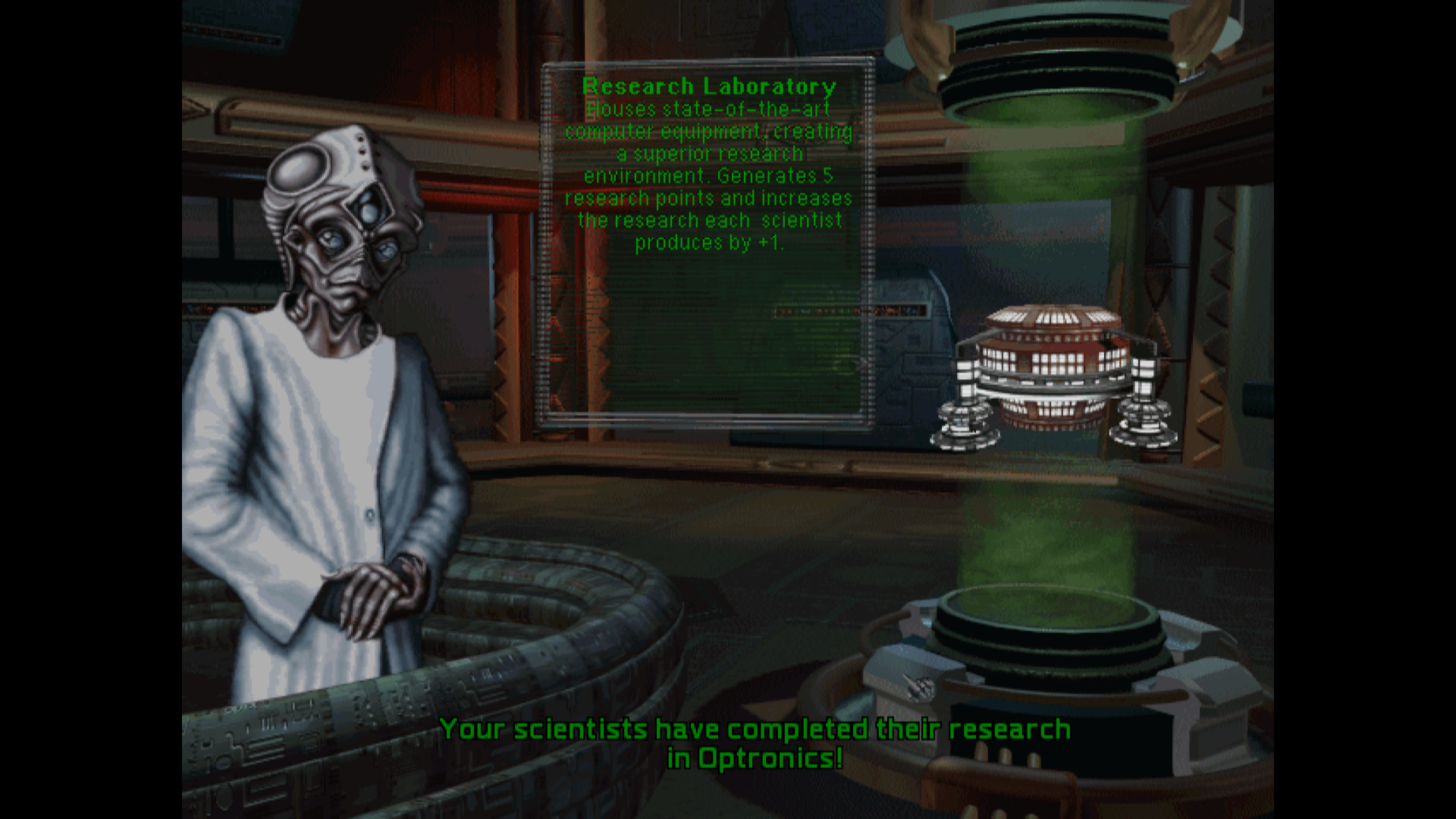 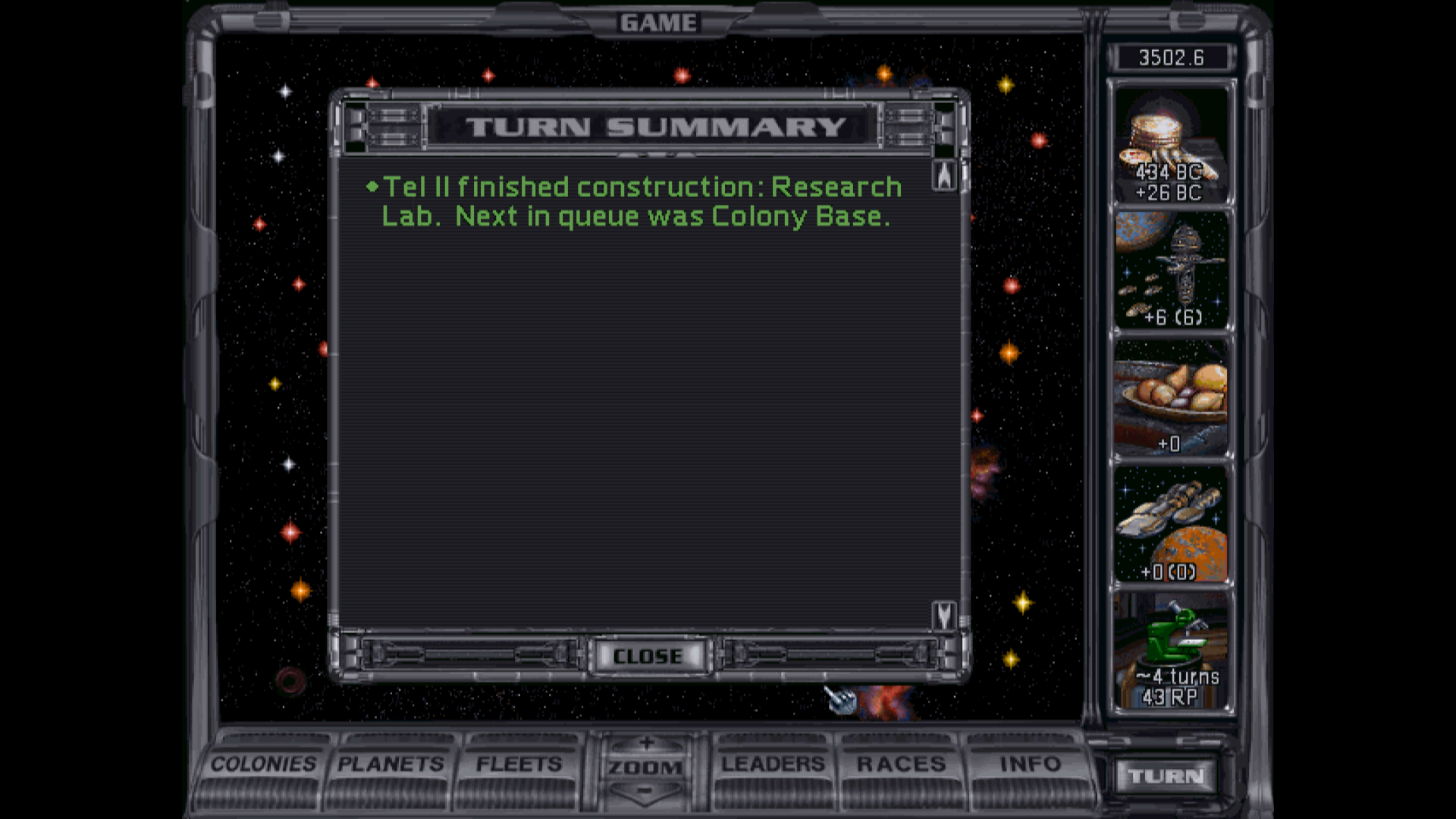 The continued investment in computing technology eventually led to fully-functional optical computers being developed in 425, which significantly increased the processing speed available to computers. New hardware and software spread through uses in research, business, and personal computing technologies, and, by 426 YE, Nares saw immense improvements in productivity and innovation. Cutting-edge computer technology eased the design of new technologies and helped with the processing of large quantities of data, helping organisational efficiency, research projects, and simple consumer applications in communication and recreation. 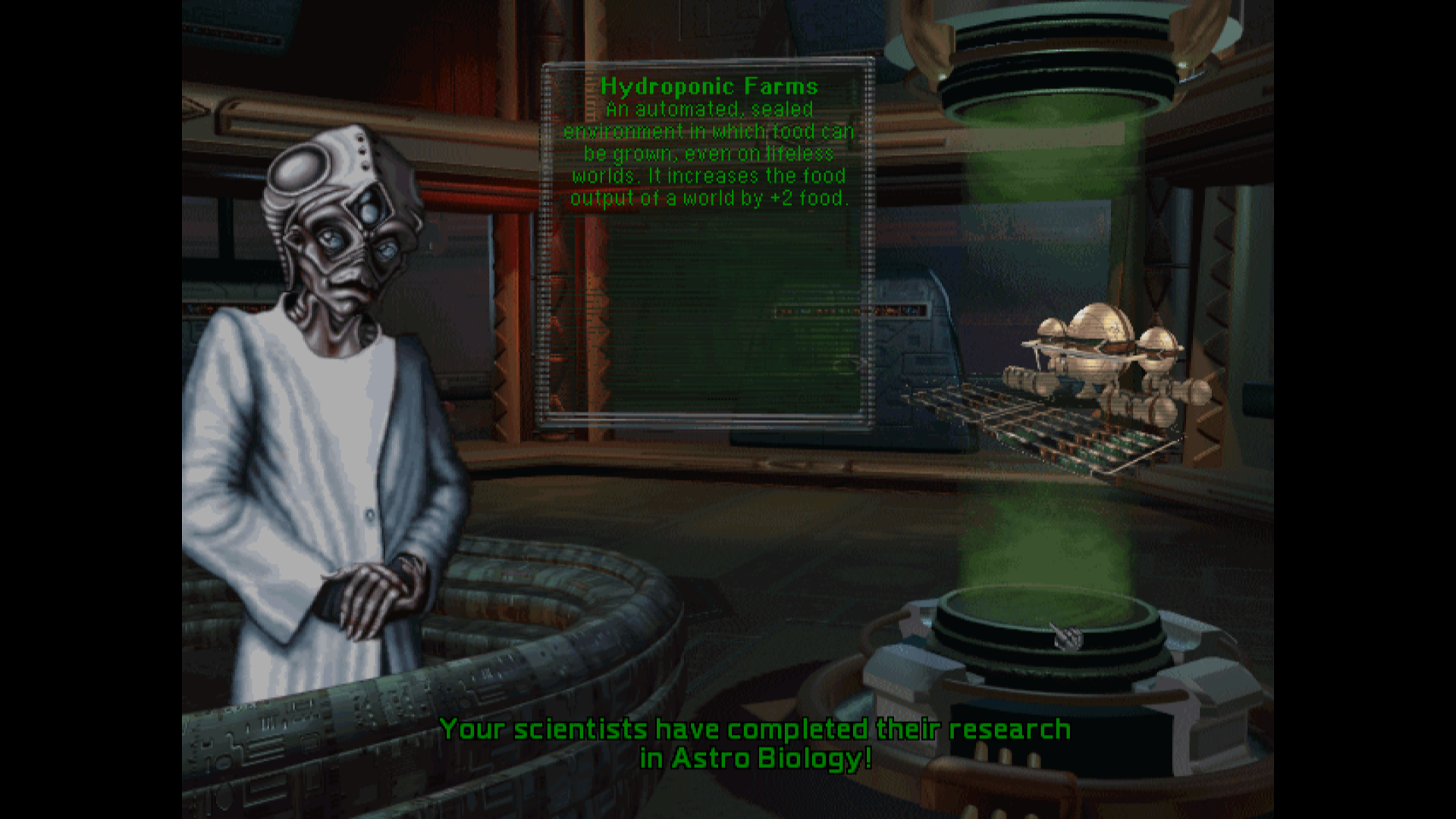 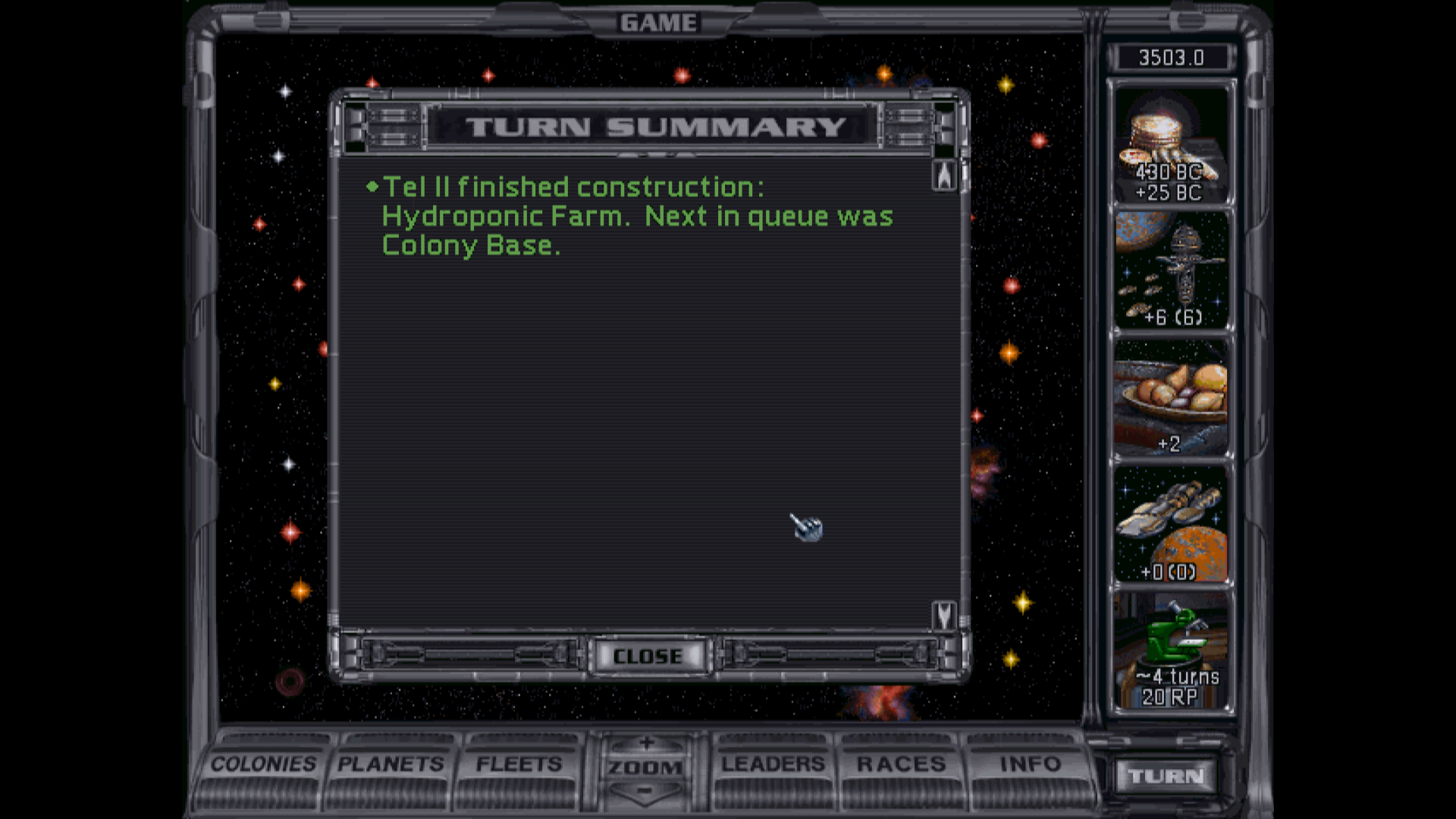 Meanwhile, investments in industrial-scale hydroponic agriculture, although equipment-intensive compared to more traditional farming methods, allowed for a notable reduction in needed employment in agricultural fields by 430 YE. New specialty industries became needed to support the specialised requirements of hydroponic agriculture on this scale, but the economy of Nares was efficient enough to absorb this with barely a ripple. As agricultural employment began to contract, employment in heavy industry began to grow as space industries started to absorb more and more investment from Nares' capital markets, the daunting task of assembling a true interplanetary presence starting to be tackled by Narestan civilisation. 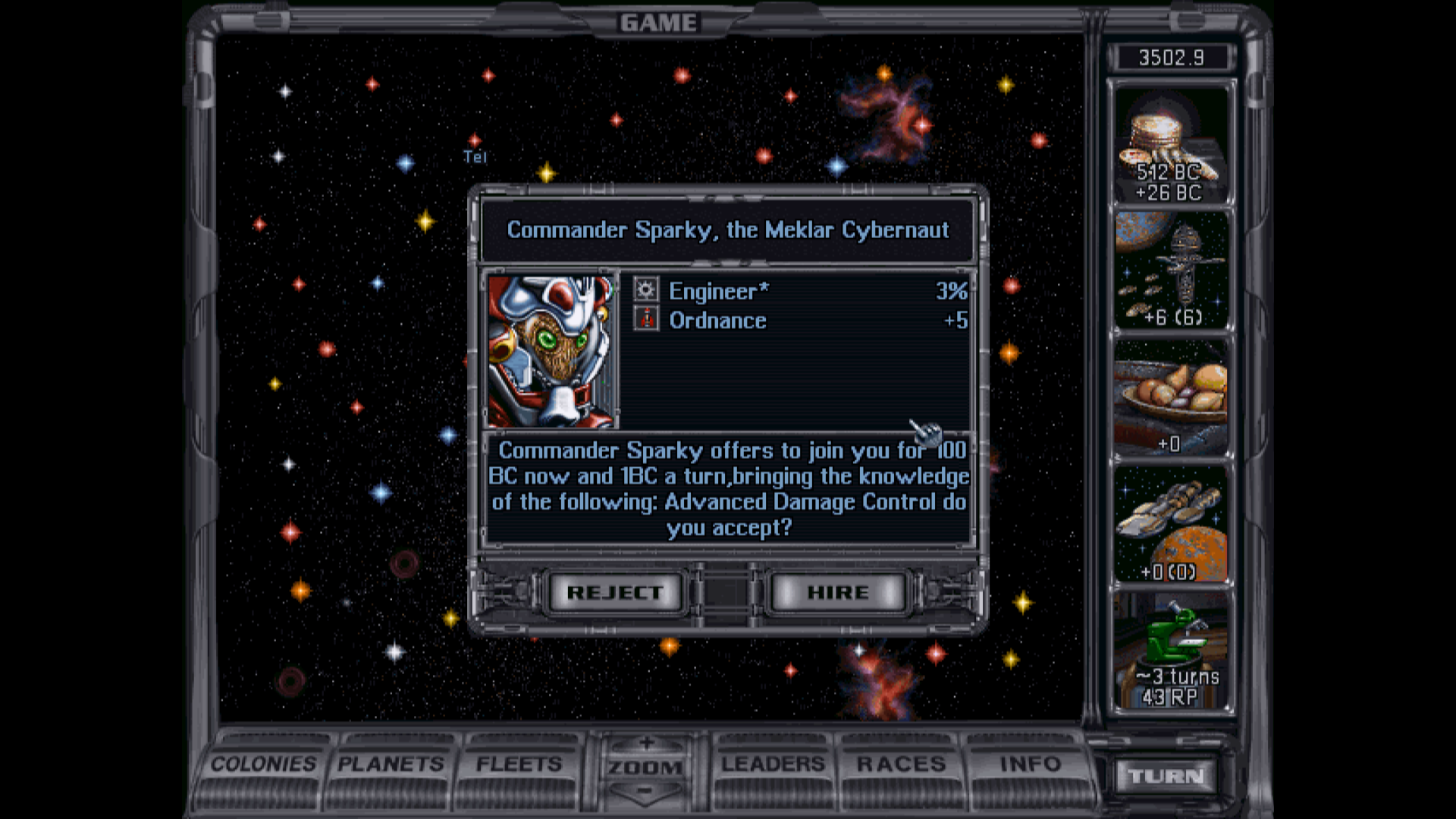 The growth of investment to space industries and space technologies led to a steadily-growing cadre of expert aerospace engineers employed in Narestan industry. The potential for radical new techniques in shipbuilding and in the maintenance and repair of spacefaring vessels promised to further bolster the strength of Narestan space industries. 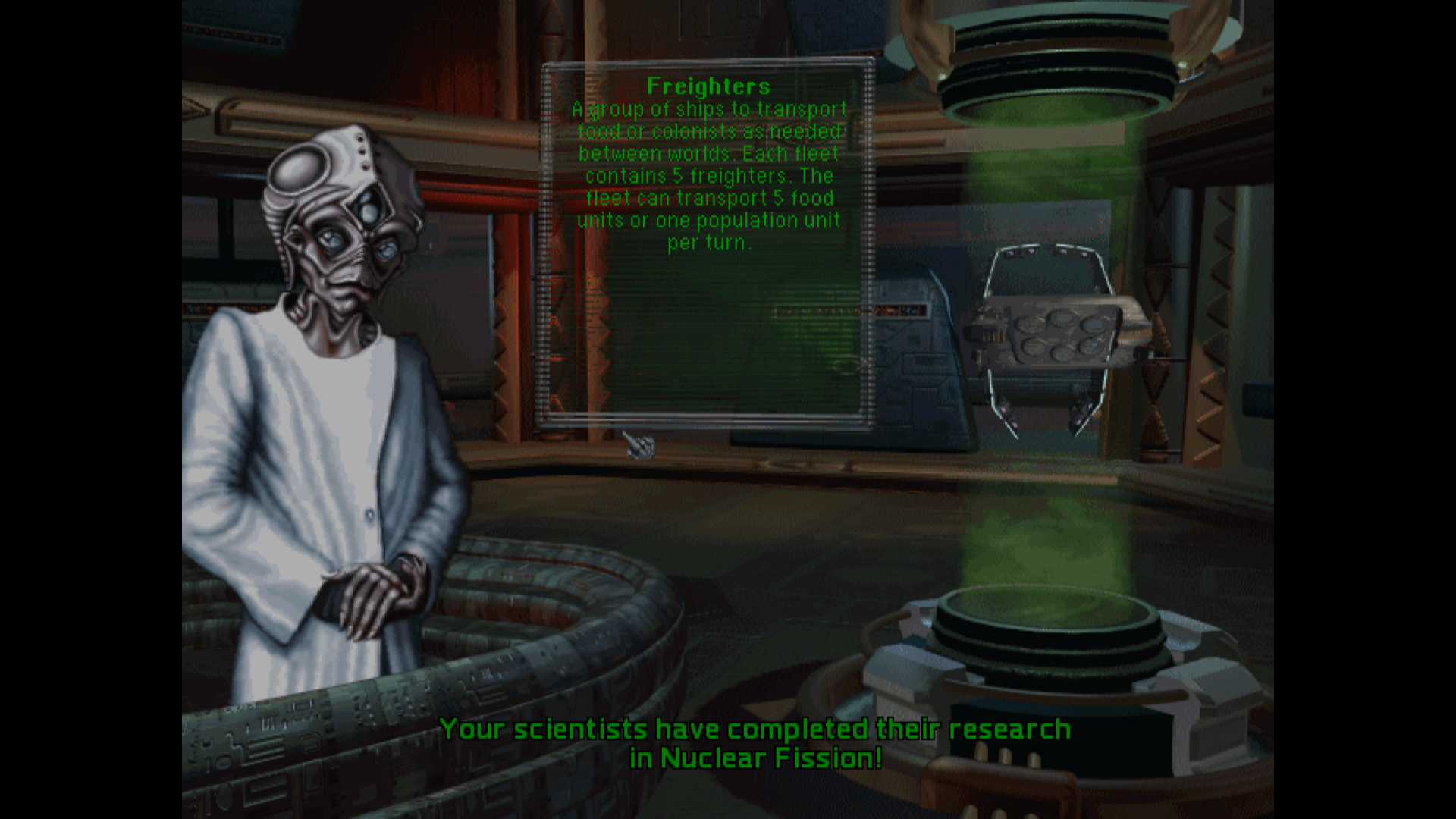 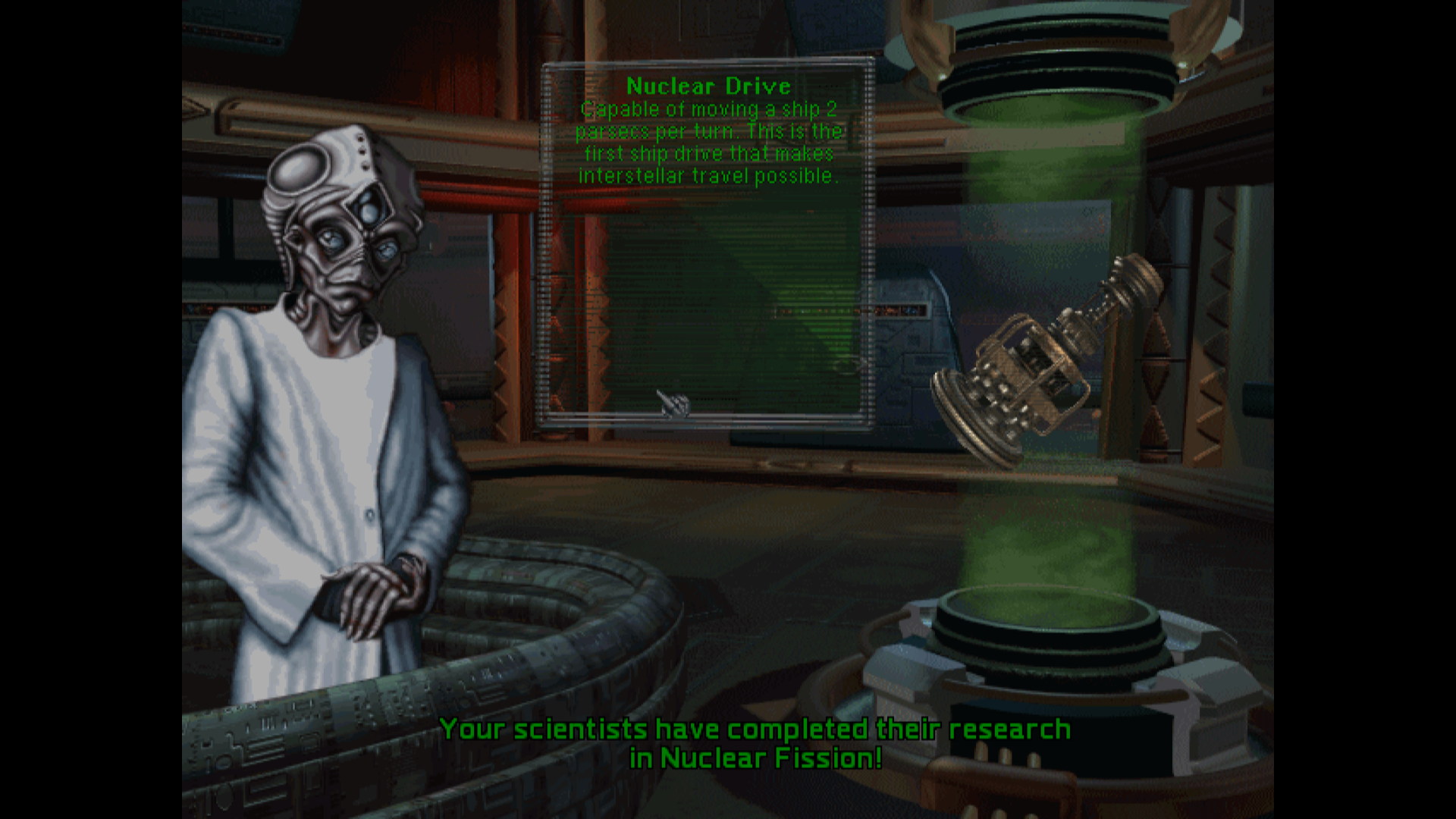 By YE 433, adaptation of existing nuclear power plants to run drive systems that could achieve interplanetary flight in a reasonable timeframe was complete, and the first test probes intended to verify the predictions of the potential of FTL travel through a 'hyperspace' dimension were completed and test-launched. Although the test probes did achieve entry into hyperspace, they exited shortly thereafter, shredded and crumpled by the intense gravitational shear stresses of hyperspace. It quickly became apparent that hyperspace travel would require reinforced vessels with sturdy hull materials, braced against the crushing stresses of FTL. With this technology, we can start building freighters, allowing basic interplanetary transport in the same system, but we still need the basic armor material to build FTL vessels. 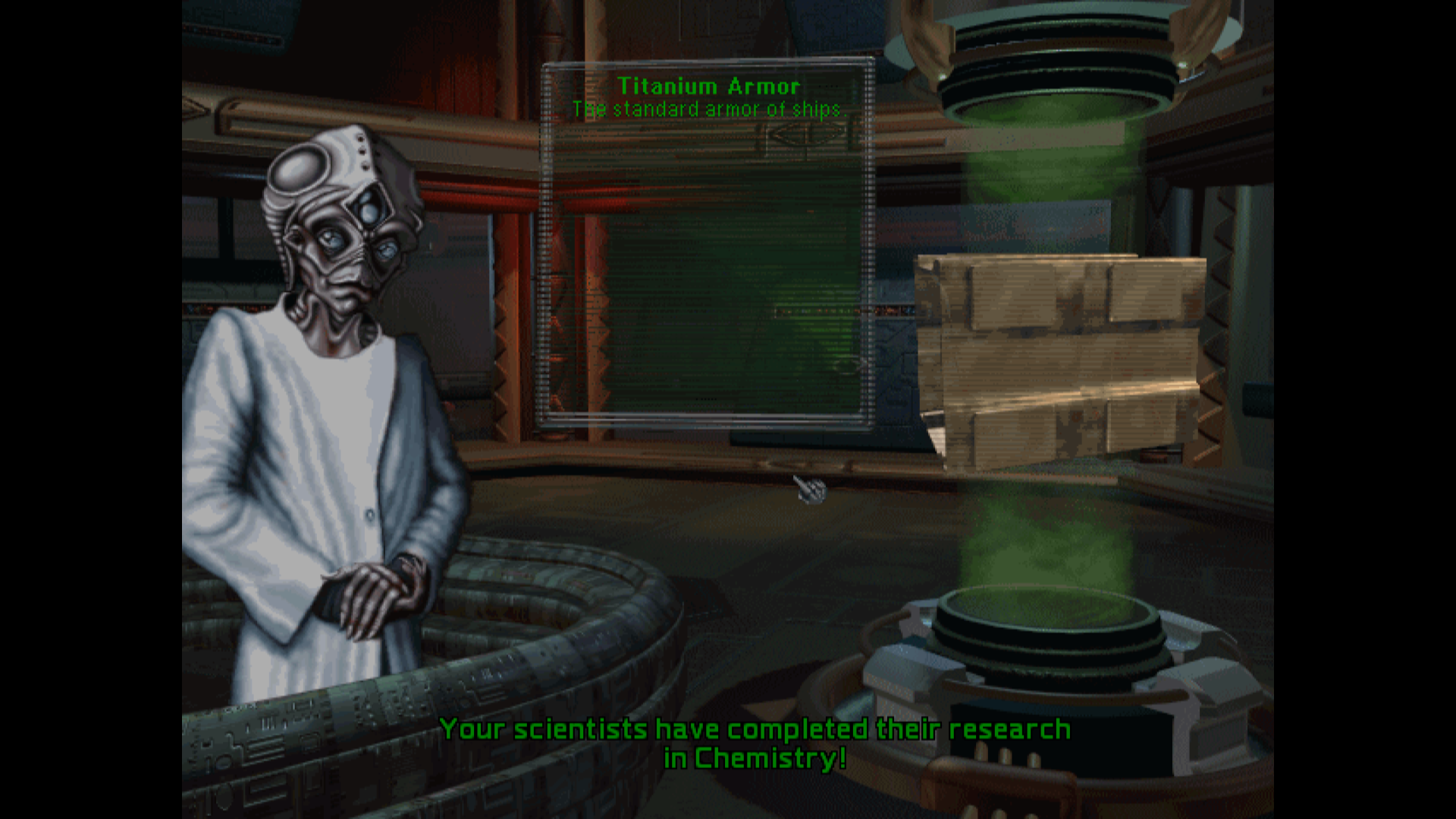 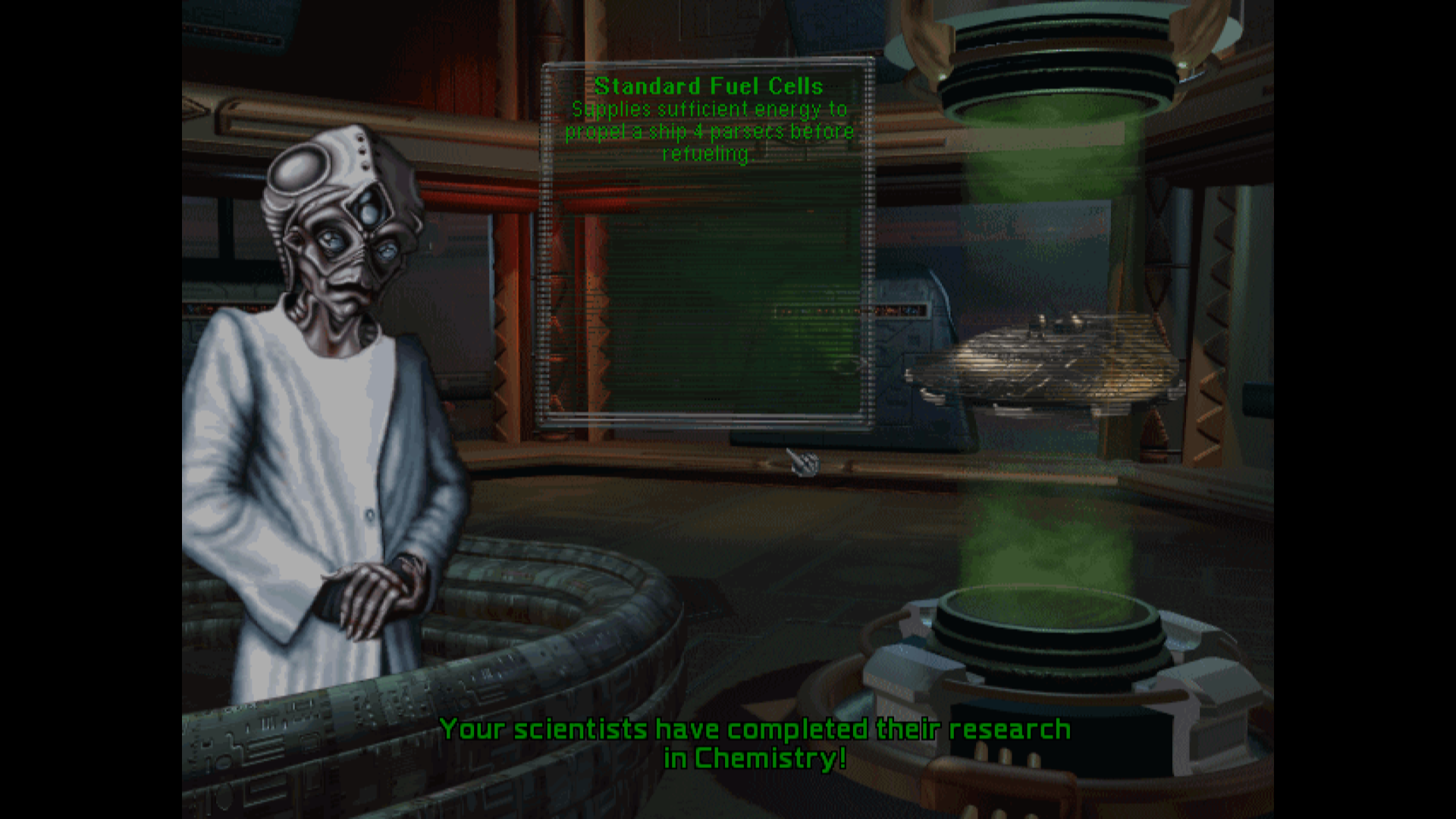 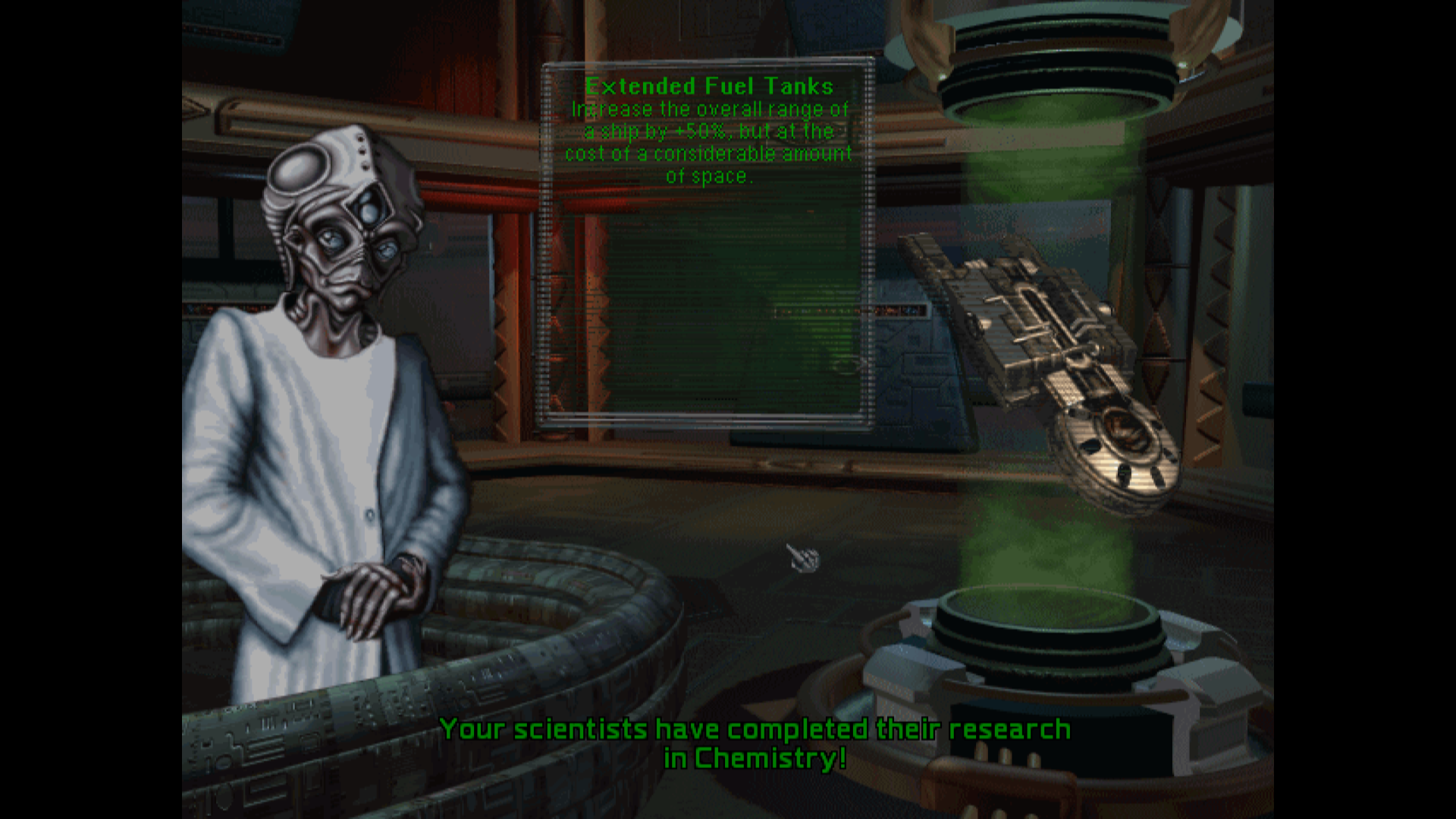  Three years later, intensive study into materials science had delivered titanium hull alloys capable of standing up to the stresses of hyperspace travel, slightly improved reactor fuel mixes for increased long-range endurance of interstellar vessels, and innovations in thruster design for STL vessels that allowed for faster and more maneuverable small craft. Adaptation of existing small craft drive units with the improved impulse may actually allow for heavy anti-ship missiles that could have the acceleration and maneuverability to effectively engage ships at the speeds and ranges likely to be in play if conflict ever erupts in the void. Use of nuclear payloads for shipkillers could allow for proximity detonation that could deal effective damage without requiring a direct contact intercept by shipkiller missiles. Still, the potential for such technology was, for the moment, largely reserved for fanciful novels and dramas positing pirates and pirate-hunters among the stars. 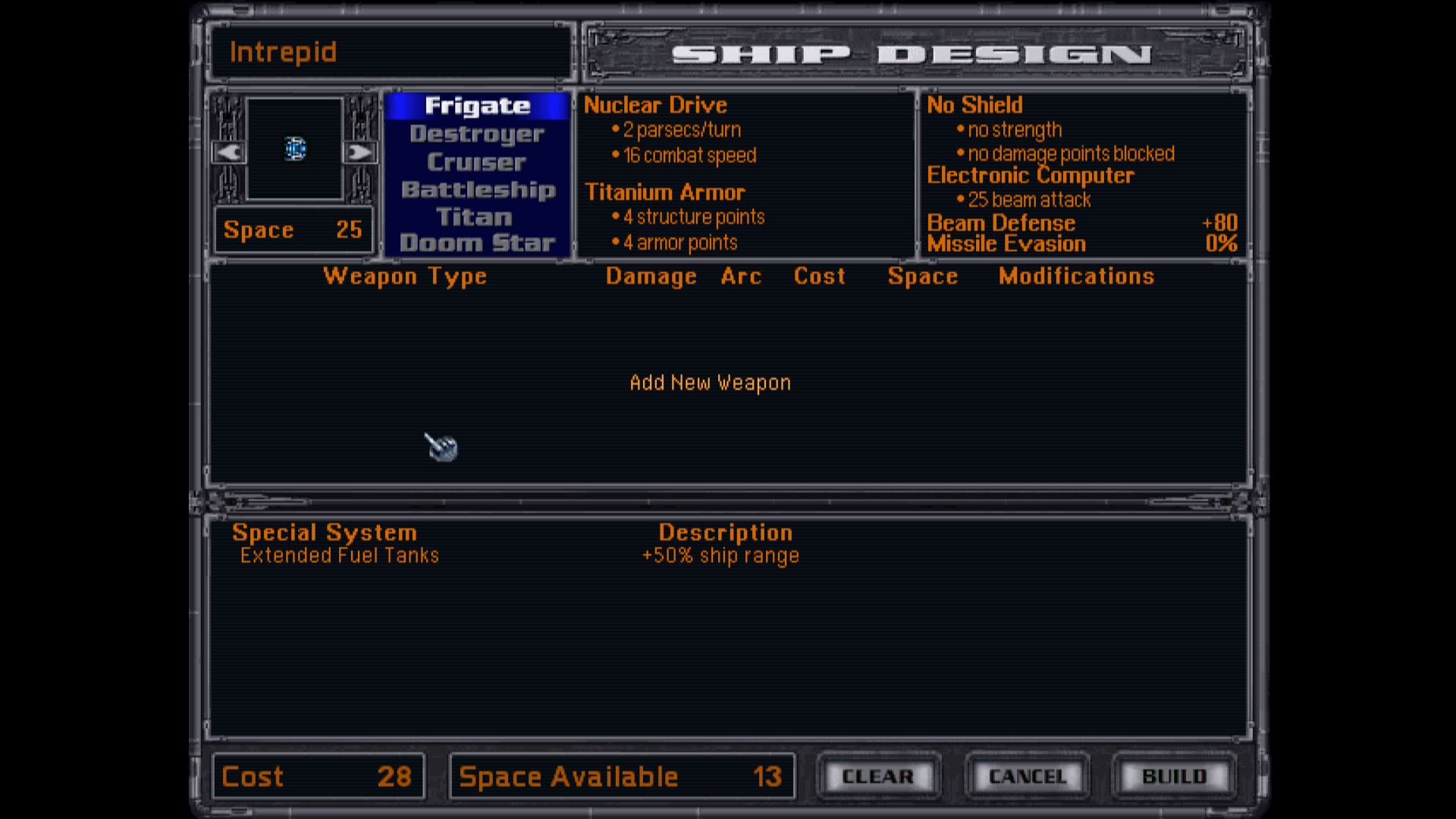 With the ability to develop effective interstellar craft, two separate consortia raised funds to commission exploratory vessels with similar designs. Both the Intrepid and the Venturer supported a modest exploratory and scientific crew, sufficient to survey distant stars, along with expanded reactor fuel bunkerage and other consumables to maintain the crew for the years needed to cross interstellar distances, even at FTL. The Intrepid launched in YE 437 and the Venturer in YE 438, each targeting one of the two yellow stars in operational range of Tel.  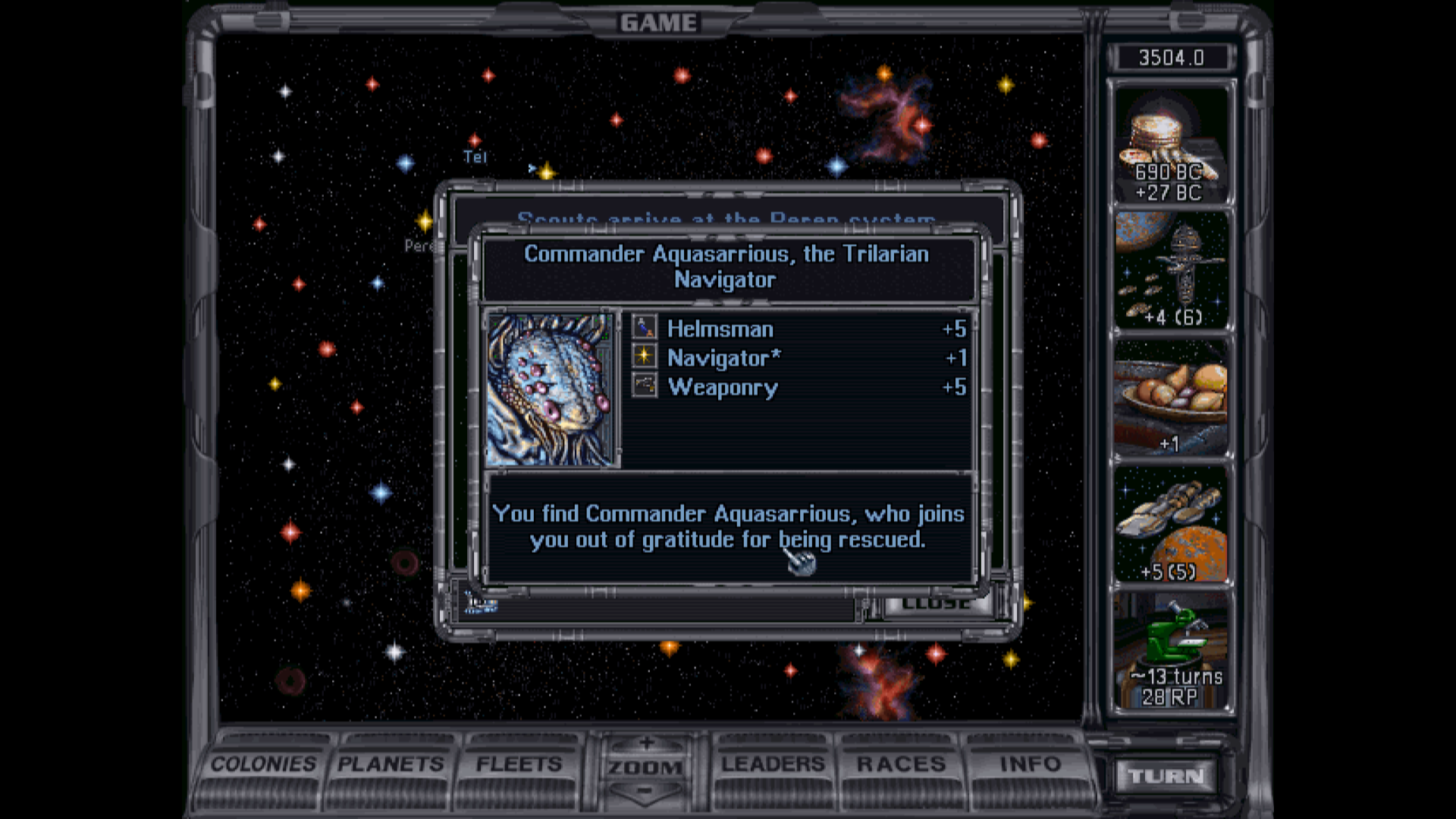 By YE 440, the Intrepid arrived at the Peren system, launching a fast communications probe back to Tel to report its findings. Peren, unfortunately, was fairly disappointing, with three planets dominating its inner system. The inmost was a small, radiation-baked planet, in some ways similar to Sedal, but smaller. Next further out was a relatively hot gas giant, and, finally, a tiny ice-covered planet with an inert nitrogen atmosphere. Although more hospitable than Sedal or the other worlds in the Peren system, and enjoying rich deposits of heavy metals, this planet was extremely small, and would never support a colony of more than perhaps one billion persons. The experience from the first Narestan voyage of discovery was already recorded and analysed, and had begun to allow for the training of skilled interstellar navigators for Narestan starships. Peren III is tiny, tundra, rich, with 1B max population. I'm continuing to gloss these leaders as native talent, for now. 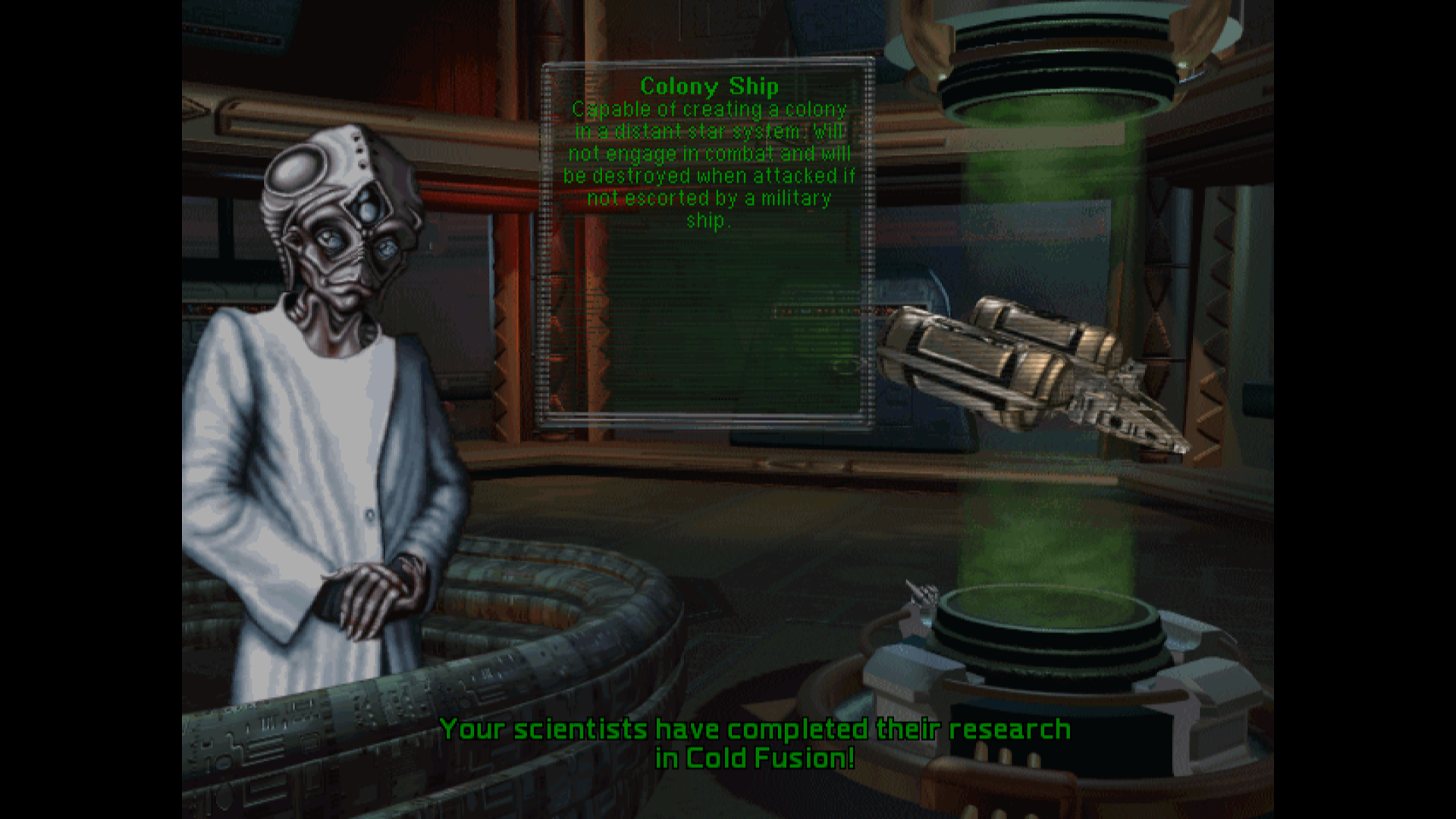 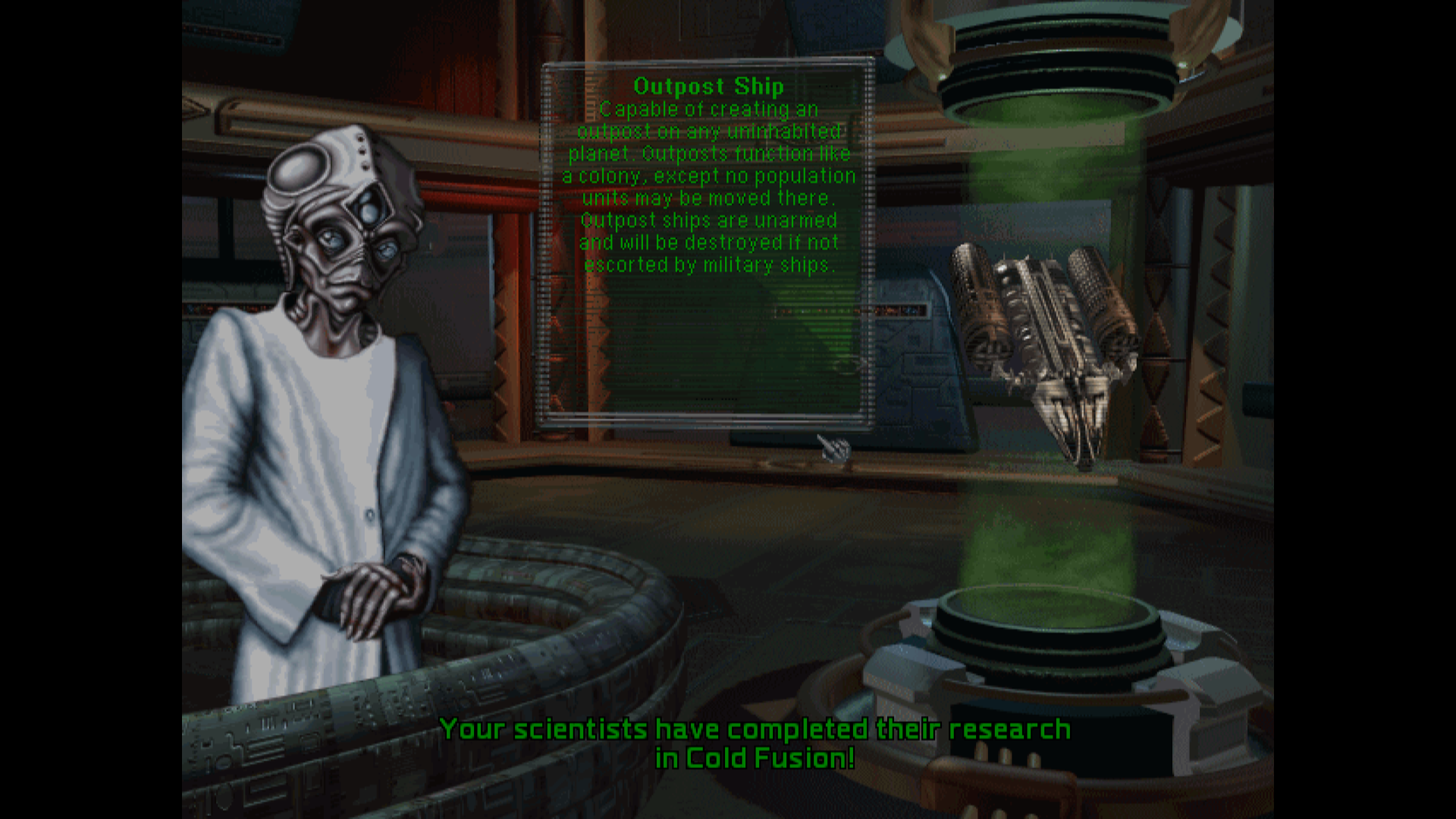 Meanwhile, experimentation with cold fusion finally produced results, helping revolutionise industry on Nares as fusion plants began to displace the previously-dominant fission plants that powered Narestan civilisation. The previous questions as to how significant colony populations could be transported across interstellar distances began to be answered with the introduction of fusion plants- although any ship to carry large populations would need to be massive and have staggering power demands, fusion plants could scale to support the power needs of these gargantuan ships economically and reliably. Large populations of colonists could sleep in carefully-managed medically-induced comas, leaving only a relatively small crew to manage the operational needs of the ship. Narestan Civilisation as of 440 YE 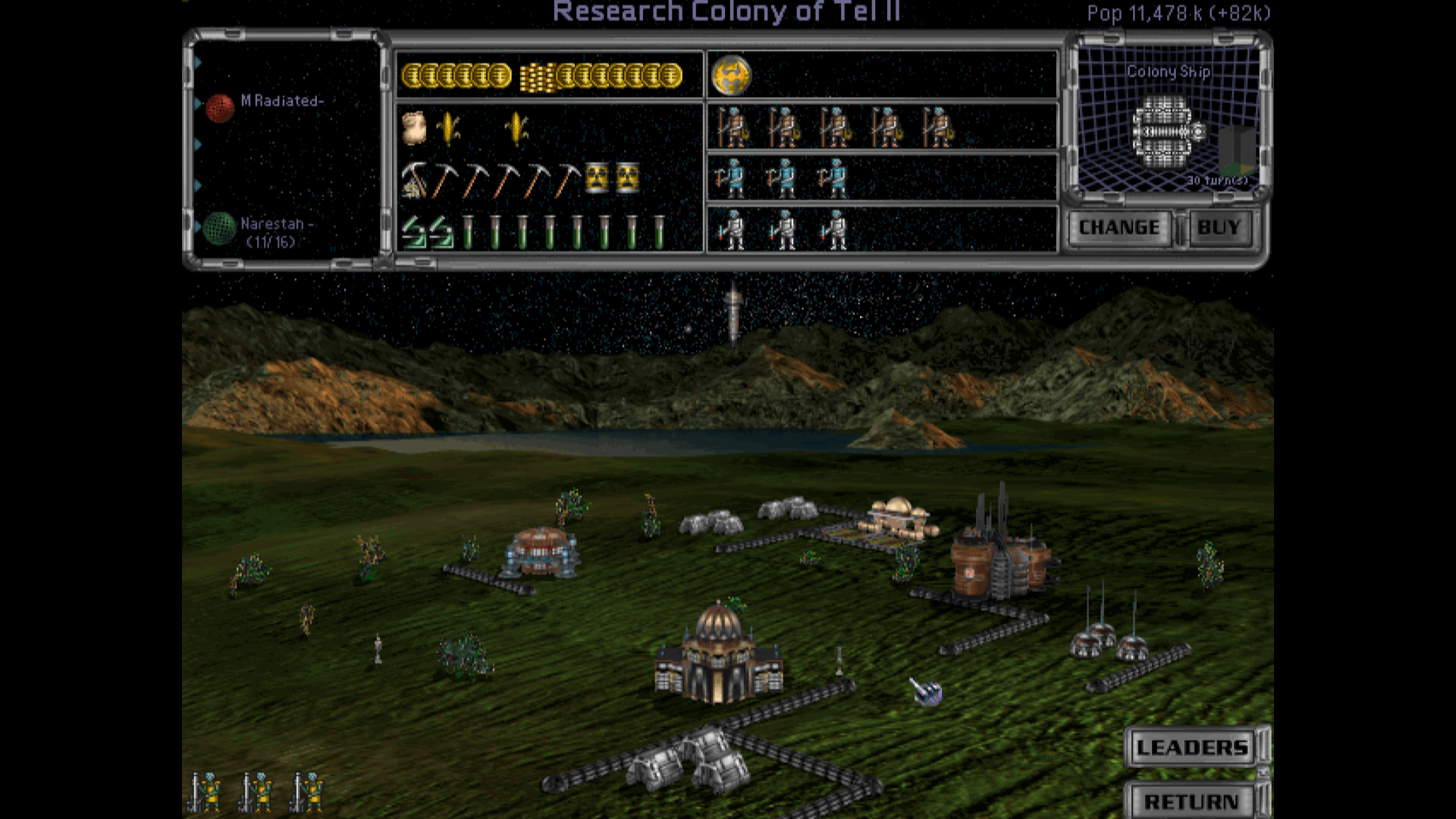 Nares stands at nearly 11.5 billion persons in population, with growth continuing steadily. The economy is more productive across multiple sectors, with an agricultural workforce no larger than that of 20 years ago supporting a larger population. Although employment in R&D has shrunk from approximately 200 million to only somewhat over 150 million over the past twenty years, innovation on the planet has actually accelerated slightly, with scientists and engineers working more efficiently and effectively with improved facilities and communications. Where things have changed dramatically, however, is in the heavy industry of Nares. Formerly a relatively tiny fraction of the economy, largely supporting the existing industrial base and helping implement new innovations as they occurred, heavy industrial employment has ballooned to approximately 150 million, many of whom are assembling equipment, systems, and supplies that will be required for any off-planet colony, either on Sedal or on some further planet around a new star. The massive increase in industrial output has started to require more expensive waste management techniques to prevent property damage to others that might lead to even more costly settlements over the trespass. Research is slightly up, annual income holds steady, and our industrial output has absolutely skyrocketed. Pollution, as ever in MoO2, is basically just a diminishing returns mechanic, which is assumed to be effectively sequestered as it's produced, thereby reducing effective industrial output. 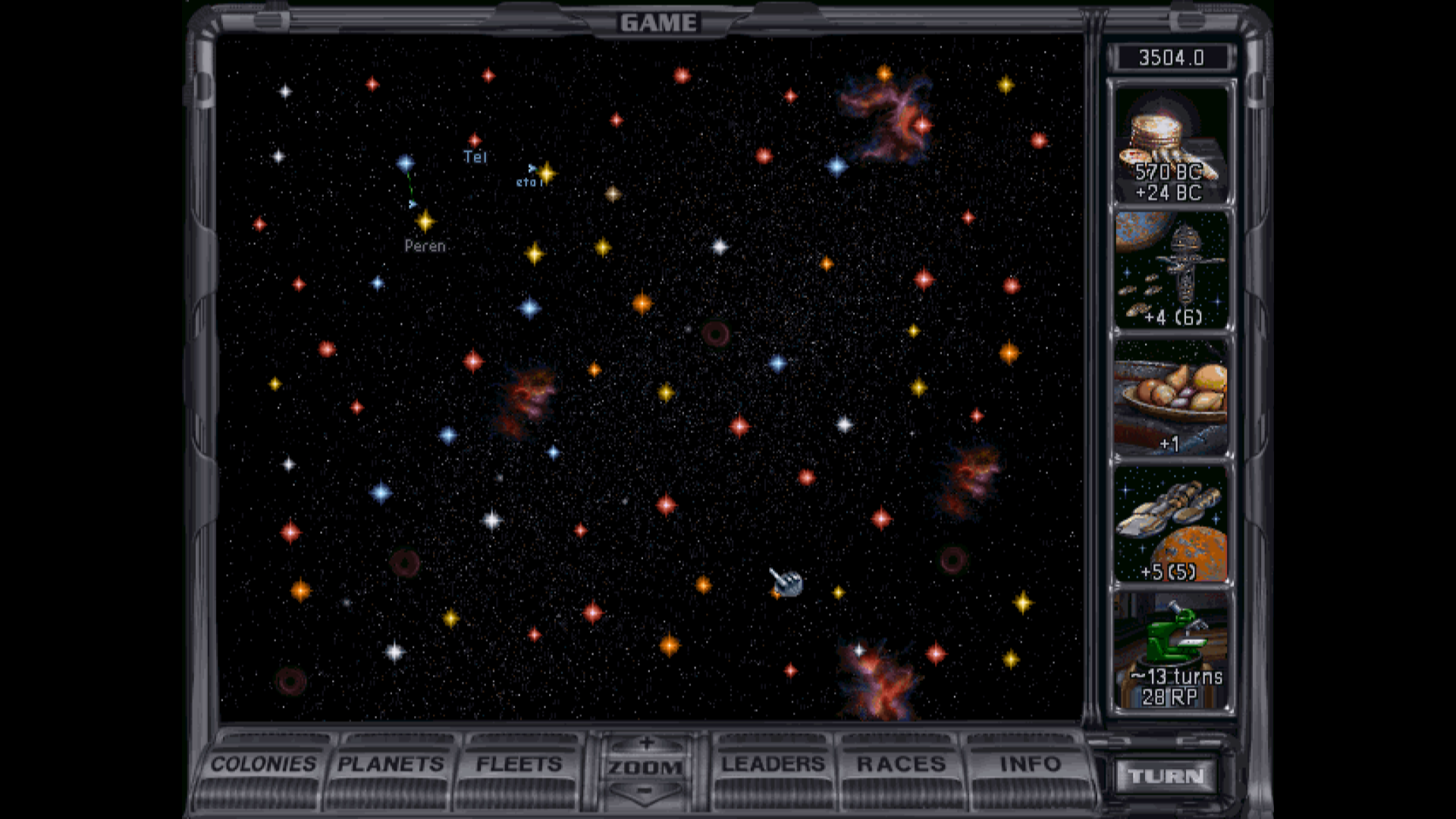 The Venturer is one year out from its target star, while the Intrepid is two years from the second star on its itinerary. The four stars closest to Tel are expected to be explored within the next five years, helping reveal more of what the galaxy beyond Tel is like and hopefully revealing a world more promising than those thus far found beyond Nares. A small fleet of heavy freighters has been assembled by hopeful shipping companies to service anticipated trade once a new colony is established. A significant reserve of investment capital has accumulated, hopefully accelerating Narestan colonisation in the future. Freighters don't cost us anything unless they're actively transporting food or population units, so getting a few up to support a new colony as soon as we get it is prudent. 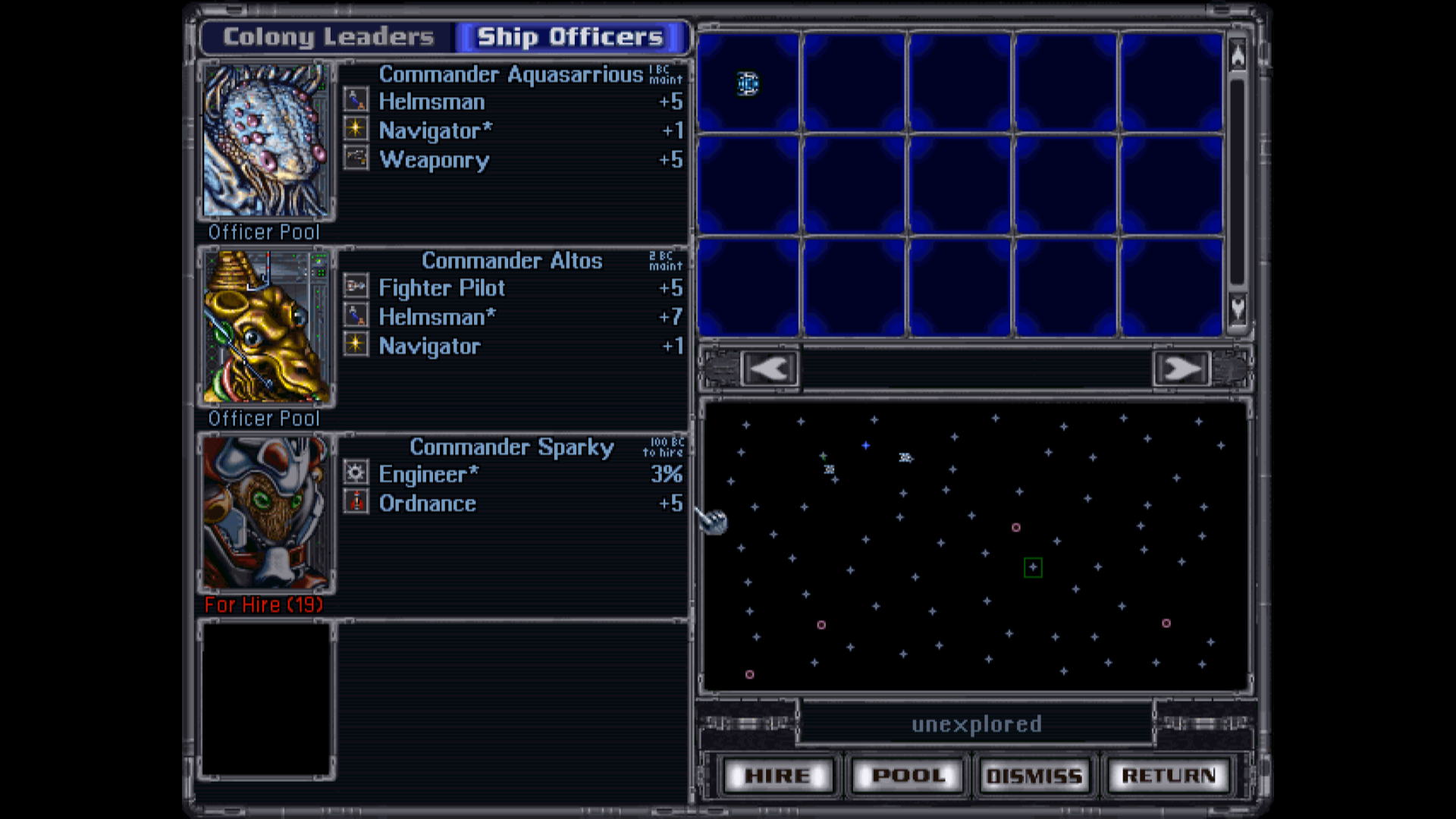 Small craft void maneuvers are now a major sport and recreation that supports an impressive pool of piloting talent, one that draws from a somewhat different cultural background than the navigators and explorers of the two major exploratory consortia. Both cultures, however, share a dream of a society of routine space travel, one that is slowly beginning to become a reality. Design engineers, although perhaps somewhat less immediately involved in space travel, nonetheless form a critical support to both these cultures. Investment Proposals Development of Engineering Departments The engineering departments of major aerospace companies could potentially become even more effective with the proper financial support. The potential payoffs seem well worthwhile. Please vote on whether to hire our new expert engineer leader. The new technology alone seems a good enough reason to me to vote yes, however. Research Proposals Continued research into engineering and shipbuilding could help improve the currently rather cumbersome methods that would be needed with current technology for transfer of cargoes in and out of gravity wells, and potentially lead to dramatic new industrial methods down the line. Meanwhile, continued agronomic research promises to even further improve agricultural productivity, helping more effectively feed the Narestan population. Other fields with less obvious immediate benefit but still of potential interest include the development of a new generation of drive systems that take advantage of the improved power output from fusion reactors or the development of new high-performance industrial alloys, which might eventually lead to more efficient ways to handle the current industrial waste problem. Please vote between targeting Spaceports, Soil Enrichment, Fusion Drives, or Tritanium Armor. Notable that Spaceports will allow Robo Miner Plants, which should greatly improve our production speed, while Tritanium Armor will allow for Pollution Processors, which will help with waste disposal as pollution grows to be a larger problem. If you vote for Spaceports or Tritanium Armor, please also vote for whether to immediately continue to the next application. If you vote for Spaceports, also vote between Battle Pods and Survival Pods along the way. Industrial and Research Funding Future growth of the workforce might lead to increases in the employment of heavy industry or research and development. Relative focus of investment might help determine how that difference tilts. Our next population unit will be go to industry or to research; please vote between the two. Four is the limit I'll be running on most industrial sectors under normal circumstances, and I normally prefer three all else being equal, but this vote will help guide my labor allocation philosophy in this particular game. The Narestan people have reached to the stars, and soon, perhaps, new worlds shall be in their grasp. Many things have changed over the past decade, but Narestan prosperity and progress has remained consistent. May it always remain so. nweismuller fucked around with this message at 02:10 on Mar 27, 2017 |
|
|
|
Heavy Lift Vehicles, Orbital Lighters, Freighters, and Communication Probes- Communications and Trade in Early FTL Society Four basic technologies underlie many of the fundamental operations of any early faster-than-light society, over and beyond the obvious requirement of 'faster-than-light drives' themselves. These technologies are the heavy lift vehicle, the orbital lighter, the interstellar freighter, and the fast communication probe. Without any one of them, interstellar societies would falter, trade and travel choking off. The heavy lift vehicle or 'heavy surface to orbit shuttle' is the workhorse of materials transfer in and out of planetary gravity wells. With a cargo area designed to accomodate a small load of standard shipping containers, a streamlined fuselage for atmospheric operations, and powerful thrusters, the HLV is designed to escape a gravity well and enter orbit with a cargo payload as efficiently as possible. Once in orbit, cargo transfer is accomplished by use of orbital lighters. These small craft, operated by either a single pilot or remote drone operation, are designed to latch onto cargo containers, safely and precisely shifting them between HLVs, freighters, and stations. Orbital lighters are generally directly hosted by a freighter or by an orbital station. Interstellar freighters are designed with a FTL drive system, enough crew facilities to support a small crew for the long haul of interstellar voyages, and a cavernous unpressurised cargo area. Some also add on passenger transport facilities. The fundamental design objective of an interstellar freighter is to reduce operating costs for extended voyages as low as possible while still maintaining the integrity to survive FTL travel. All three make for a cumbersome and rather expensive means to shift goods between gravity wells, but nonetheless some level of interplanetary and interstellar trade is viable even with this awkward system. Meanwhile, the fast communications probe allows for information to be transferred considerably faster than either cargoes or persons between the stars. Ship drive systems are designed with the assumption that the ship and the drive should survive their journey, increasing cost and bulk and reducing possible FTL speed. By a series of design compromises, FTL speeds over 50 times those practically achievable by standard vessels can be effectively achieved by a stripped-down unmanned probe consisting of a power plant sufficient to run the drive system, a pre-programmed navigation system, the FTL drive itself, and a powerful radio transmitter attached to prerecorded data packages. Although the voyage effectively destroys both the power plant and drive system for future use, this can safely deliver the transmitter across interstellar distances, allowing messages packed with as much data as is needed to be transmitted in weeks rather than years. The travel lag between systems in FTL societies almost renders the interstellar trade needed to support a 'society' at this scale impossible- without the rapid communications permitted by these probes, it truly would be impossible. Despite the expense needed for these single-use probes, they remain the best means early FTL societies have to keep themselves connected and coherent. nweismuller fucked around with this message at 02:14 on Mar 27, 2017 |
|
|
|
wedgekree posted:Sparky's tech provides automated repair unit, which allows ships to automatically regenerate health in combat and fully repair after battle. Super important early game o maintaining survivability. It's actually Advanced Damage Control. It doesn't provide in-battle repairs (although the engineer leader does if assigned to a fleet), but automatically fully repairs after battle without need for any local facilities for service. It is indeed great for keeping fleet endurance up. nweismuller fucked around with this message at 08:31 on Oct 2, 2016 |
|
|
|
Well, it's hard to argue with that level of unanimity. I'll start playing the update.
|
|
|
|
Colony ships are loaded with the people and equipment to start a new full-scale colony in a distant system with a significant population, its own industrial base, significant economic output, and the ability to assemble local defenses. Outpost ships, on the other hand, are a stripped-down mission that establishes a base somewhere that serves as a fueling and sensor station. It is likely there's small-scale mining or trade activities that defray the costs of operation of the base, as there is no maintenance cost for an outpost, but it's basically just a lonely station somewhere. Unlike full-scale colonies, outposts can also be established in asteroid belts or around gas giants. E: Beaten to the punch, heh.
|
|
|
|
WarpedLichen posted:Yay, a MOO2 let's play. I am... not even sure what in the world you are talking about. Beginning writeup of the next update.
|
|
|
|
Horrors in the Void 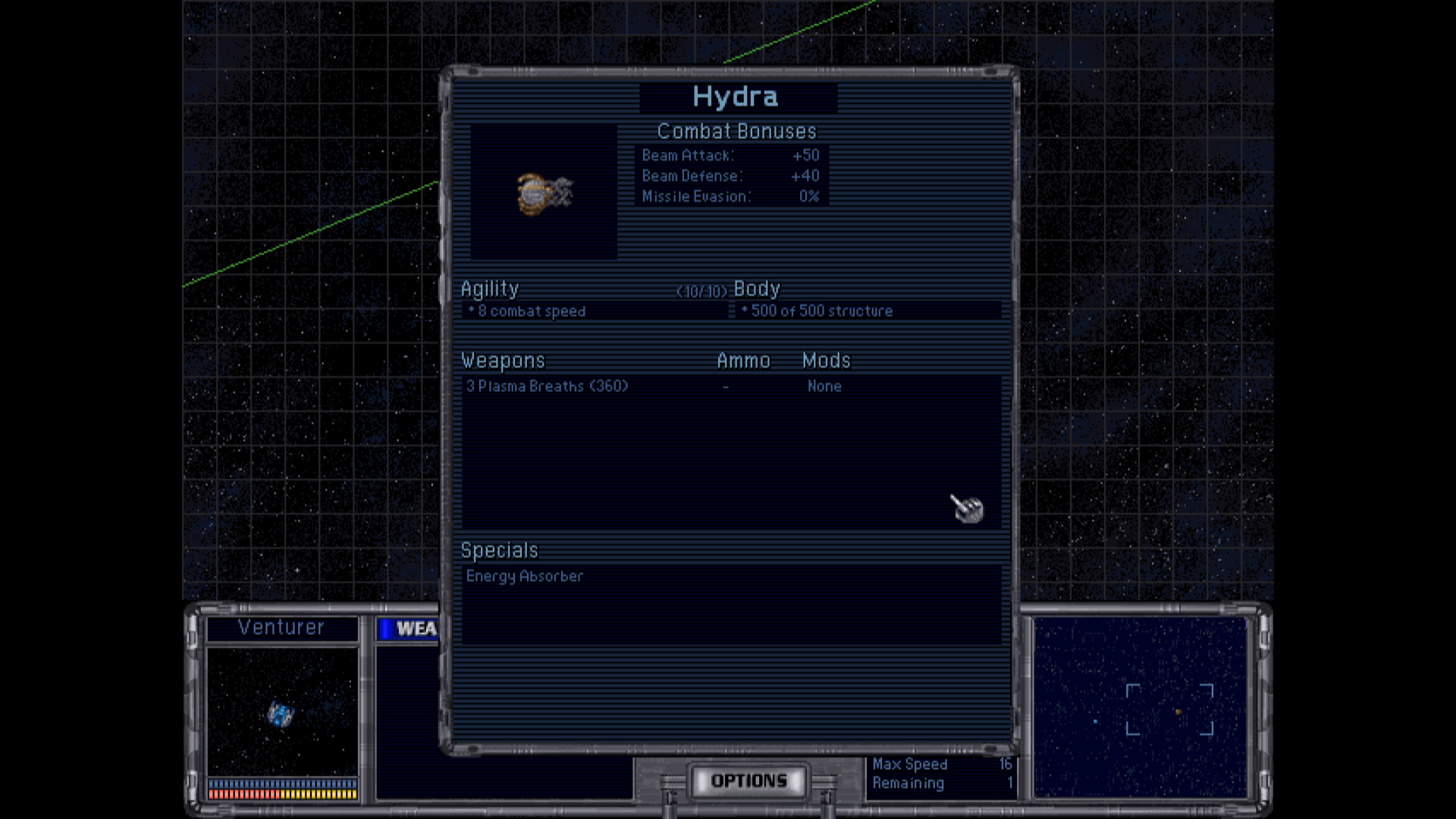 In 441, the Venturer arrived at the yellow star Ras, sweeping its sensors to survey the system. To its crew's shock and horror, along with the various bodies one might expect in a star system, they found a massive quasi-biological mass of tentacles, eyespots, and engulfing mouths with a core burning with temperatures like a stellar furnace which began to propel its way towards the exploration vessel. Frantic effort by the crew eventually allowed the ship to push itself back into hyperspace on an emergency course back to Tel before the terrible thing drew close enough to harm the Venturer. 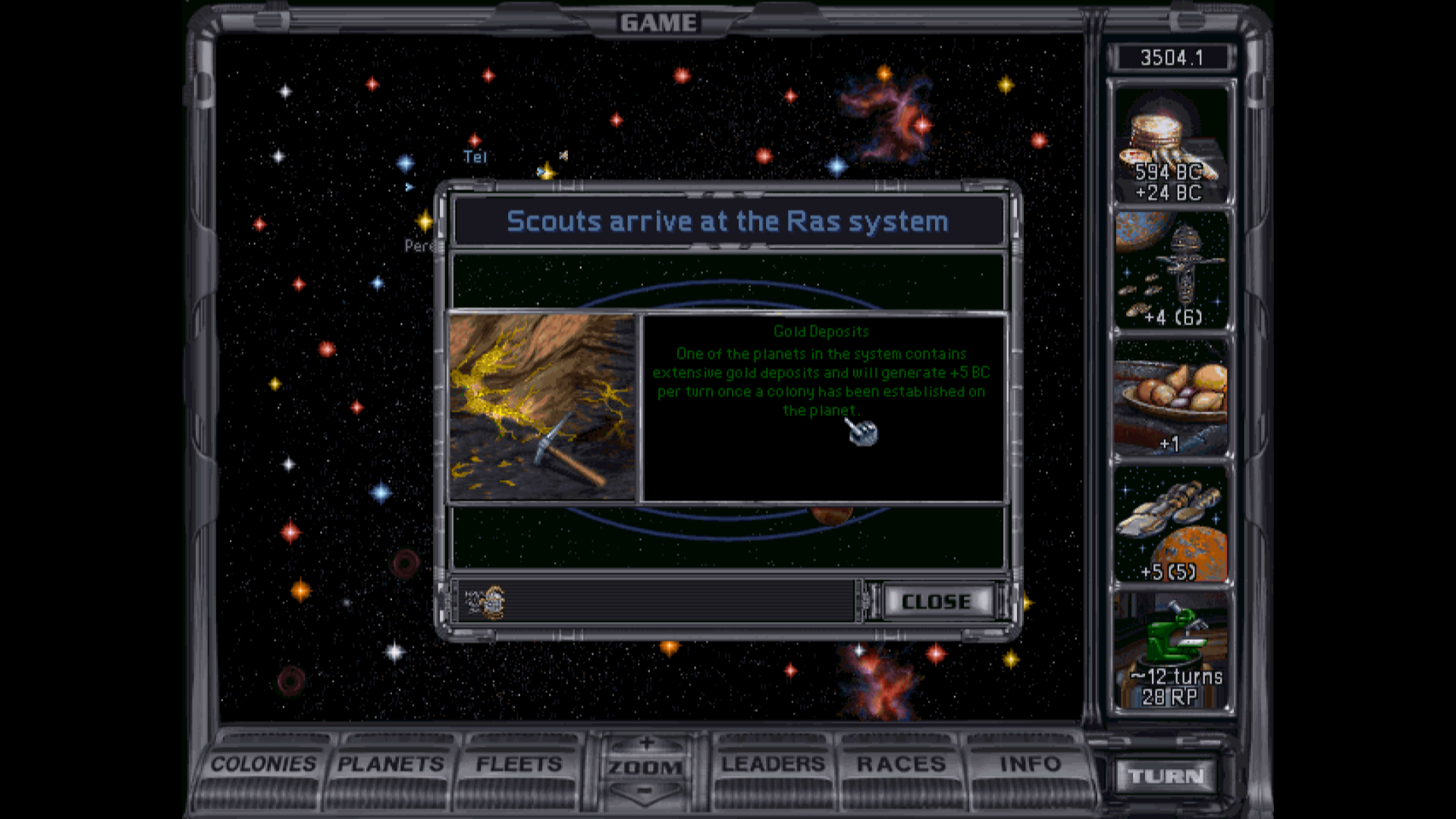  The planets orbiting Ras almost seemed to mock the explorers, as it was too dangerous to risk a return mission, yet what the Venturer had seen showed great promise. Ras I was an immense planet whose oceans and continents hosted an incredibly lush biosphere. Prevailing weather patterns that encouraged warm, mild conditions with heavy precipation over a very wide band of latitudes made for an extremely stable and friendly growing environment that provided large and stable supplies of food for local herbivores. The lush conditions for growth made deserts nearly unknown on Ras I, aside from those of the small polar ice caps. Despite its size and the rich deposits of heavy metals in the crust, the gravity on Ras I was anomalously low, hinting at strange secrets hidden on the planet. Meanwhile, Ras V was a planet approximately the size of Nares, thickly shrouded in choking clouds of sulfuric acid. As a planetary environment, it was brutally unforgiving, but large amounts of gold were present lacing the rocks of this Hellish world. The gold of Ras V might have proven a spur to greed, but the horrific planetary conditions were an equally daunting obstacle. The inner system between Ras I and Ras V was marked by a thick and broad asteroid belt and a gas giant unusually close to its system primary. Ras I is a huge, gaian, rich planet with low gravity; Ras V is a large, toxic, abundant planet with gold deposits. Low gravity gives a 25% output penalty on the planet, but the fertility and mineral richness on Ras I just might make up for that- assuming we could get through the space hydra. The 5 BC bonus income on Ras V is nice, but liable to get eaten into, eventually, by the 50% increase in maintenance costs on toxic worlds if we colonise it. 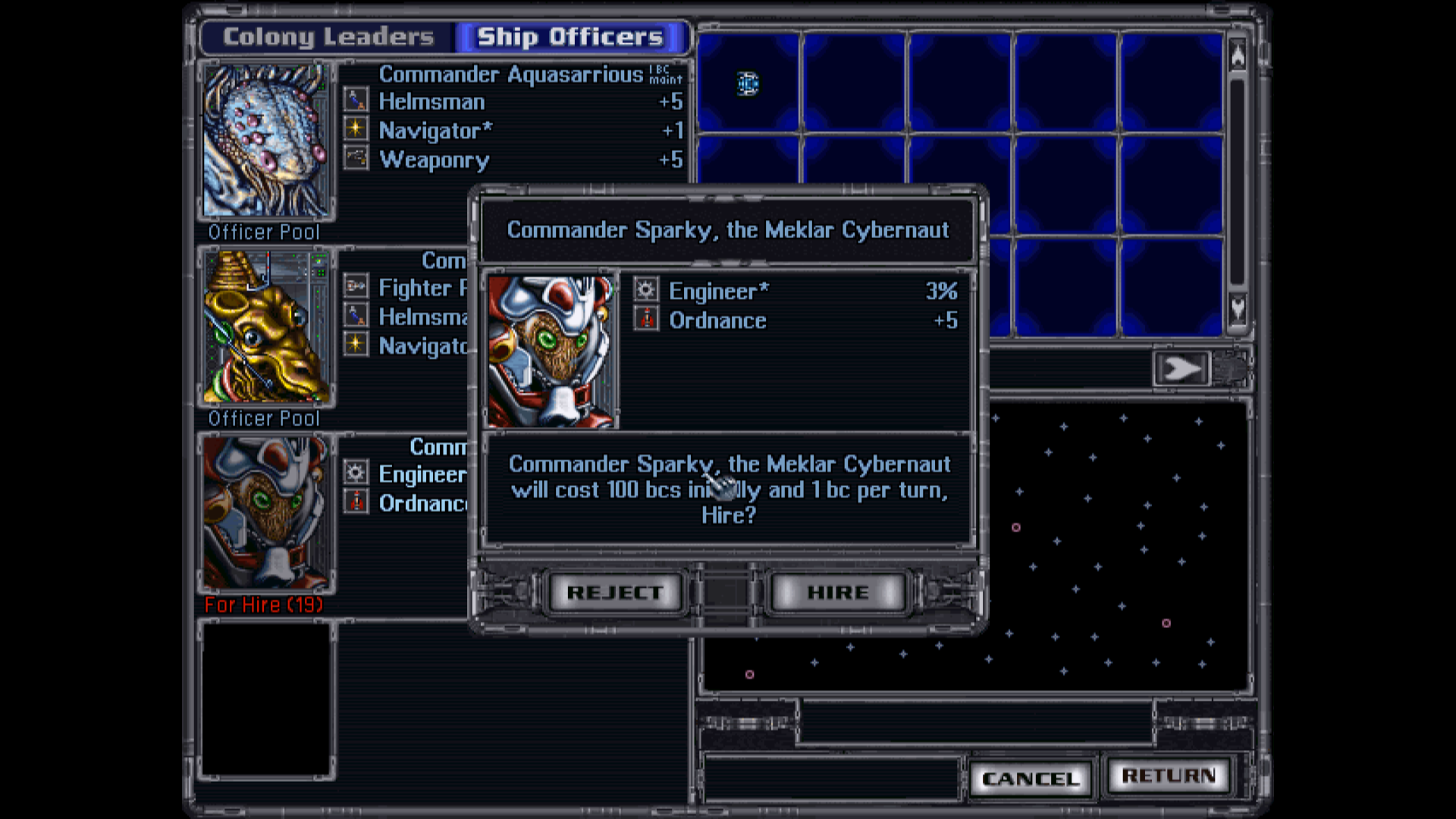 Continued development of engineering talent amongst major aerospace firms was only encouraged by experience and funding, and a series of radical techniques for design of repair equipment intended to help ships overhaul even major damage without need of a shipyard was eventually developed in 441. The expert pool of engineering talent in Narestan society would doubtless serve it in good stead in the future. 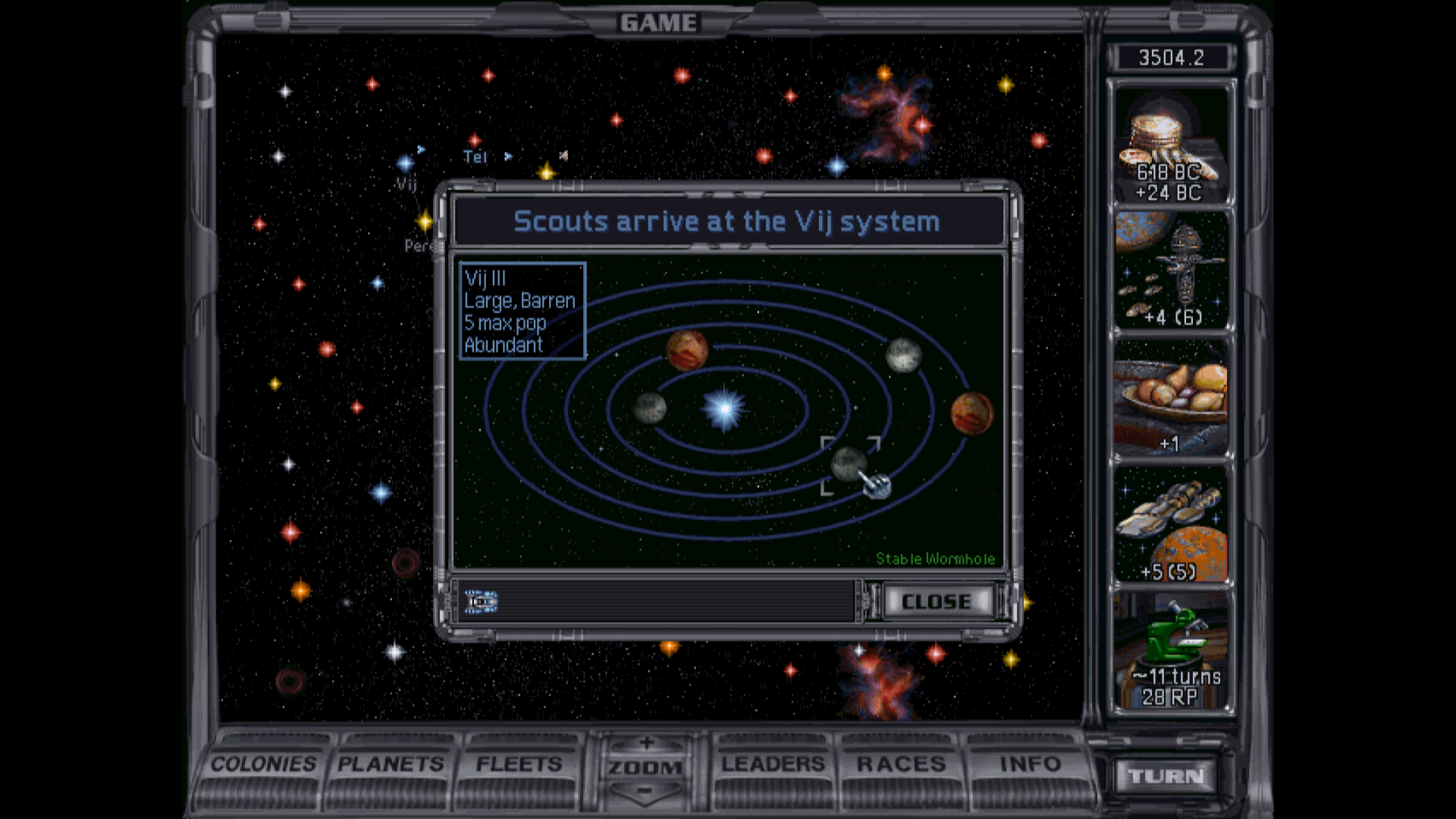 A year later, the Intrepid arrived at the hot blue-white star Vij. Two massive gas giants orbited in Vij's second and fifth orbits, still within its inner system. Meanwhile, three planets with thick, inert atmospheres orbited as the first, third, and fourth planets of the system, their atmospheres protecting them from the intense radiation output by the hot young star. Vij I was notably smaller than the other two, which were approximately the size of Nares, while Vij IV had unusually rich mineral and metals deposits along with crushingly heavy gravity that rendered it highly unattractive for colonisation. The most interesting thing about Vij, however, was evidence of a structural anomaly in hyperspace around the system providing a short, direct path to a red star on the opposite side of the galaxy. Vij I, III, and IV are all barren planets. Vij I is small and mineral abundant, Vij III is large and mineral abundant, and Vij IV is large, mineral rich, and suffers from heavy gravity (which more than offsets any additional production from the mineral richness, as well as penalising other outputs by 50%). The wormhole lets us travel between two stars in only one year.  With the prospects of a truly promising new world accessible to Narestan colonisation dwindling, the initial colonisation mission from Nares set out to Sedal, establishing a functional colonial population by 442. Although Sedal was a radiation-baked wasteland, nonetheless the initial expense of colonising it was much less than would be needed for an interstellar mission, and investment was ready to develop the new colony into a prosperous and productive community. A colony base only costs 200 production, compared to a colony ship's 500, and it began to become clear we weren't getting anything exciting nearby that made sense to hold out for, so I made the call to buy out a colony base. 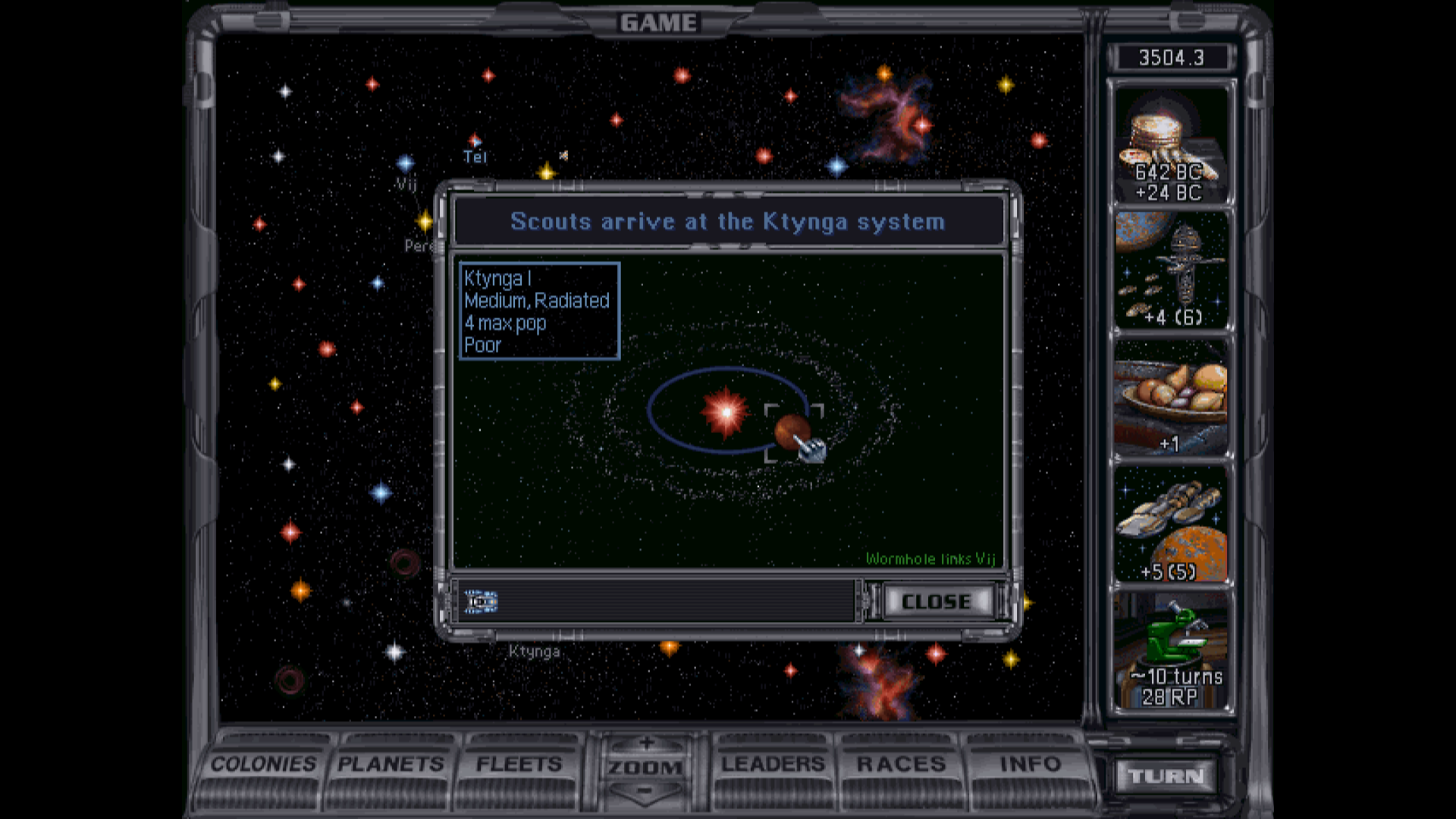  In 443, the Intrepid arrived at the opposite side of the strange path linking Vij and Kytynga, while in 446, the Venturer arrived at the red star Kelev near Tel. Both had close-orbiting, metal-poor planets seared and baked by radiation, of relatively little interest. Kelev also had, further out, a bitterly cold planet with modest oxygen content in its windswept atmosphere and thick ice sheets covering most of its surface. Further exploration proved there was an extremely primitive ecology of hardy molds around the equatorial belt of Kelev II, which otherwise was mostly notable for a crust seemingly comprised mostly of light rocks and silicates with minimal industrial metal content and inconveniently low gravity. Kelev II is a small, tundra, ultra-poor, low-G world- not a very attractive prospect at all. It appears everything near Tel ranges from 'bad' to 'mediocre', except for the system guarded by the horrifying hydra. Eventually, the work of scientists and research departments on Nares and Sedal bore fruit with continued improvements in the engineering of spacegoing ships around the year 450. Improvements in machinery and restructuring of internal spaces could recover a very significant amount of usable space for vessels, at the cost of a significantly increased manufacturing cost. The development of high-quality spaceframes in the future would no doubt help with whatever challenges the Narestans met amidst the stars. The following decade passed largely uneventfully, although with growing investment dedicated to an attempt to improve the ease and efficiency of trade between Nares and Sedal, and with continuing efforts to assemble colonists for the bleak worlds of the stars surrounding Tel. Narestan Civilisation as of 460 YE 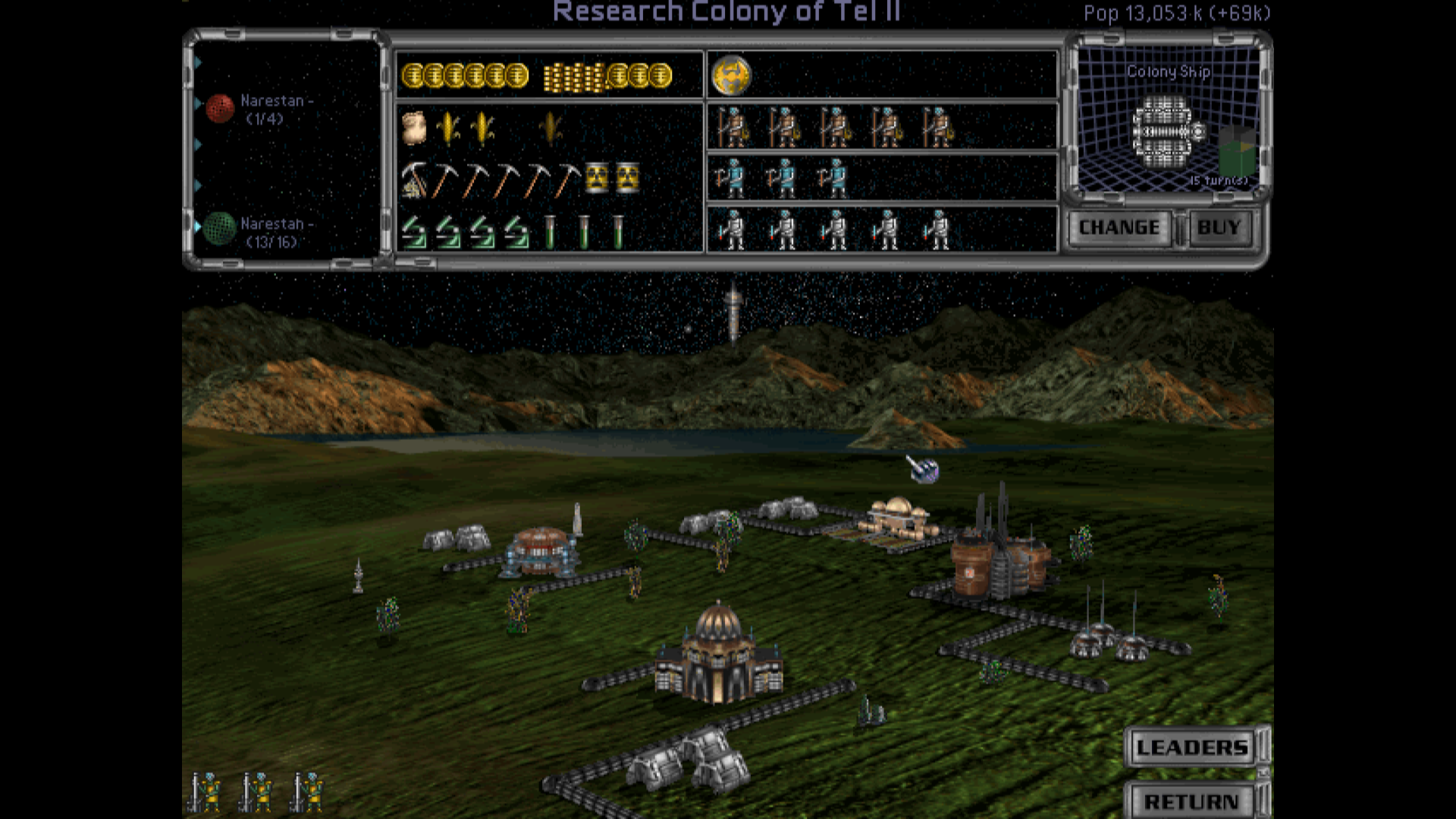 The population of Nares now stands at just over 13 billion persons and still growing, with the population employed in science, research, and development having increased from approximately 150 million to 250 million over the past twenty years. Food imports from Sedal currently make up approximately 8% of the food consumed on Nares, which has helped keep the size of the local agricultural sector steady. Nares remains prosperous, although the pull of new opportunities continues to attract colonists to a new colonial mission.  Sedal is now home to almost 1.7 billion persons, with an infrastructure which was rapidly moderised to match the standards of the homeworld. The relatively small population and the capital-intensive nature of its improved industries means that Sedal is critically dependent on imports from Nares to maintain its own infrastructure, importing large amounts of specialised equipment for its laboratories and its sealed industrial farms. The primary exports of Sedal, under current conditions, are food and a steady, if modest, flow of scientific data and engineering services under contract to firms back on Nares. Although the planet is well-developed, the difficulties of large-scale interplanetary trade, the smaller population, and the rather overstressed local infrastructure renders the availability of some products somewhat less reliable than on Nares itself, although it is hoped that eventually time will remedy these difficulties. Work has begun on a shipyard to orbit Sedal, although it is still a very long way from competion. Sedal's running a deficit of two BC, but it exports a unit of food and produces research. We can count that as a win for now.  Annual investment has continued to slowly climb over the past two decades, while innovation and invention have risen sharply. Regular freighter runs link Nares and Sedal, with a great deal of transport capacity still to spare. It is anticipated that continued efforts to improve the flow of trade between the two Narestan worlds shall soon bear fruit, and, despite the unexpected dangers to be found beyond Tel, the Narestan people are confident of ability to thrive as an interplanetary and even interstellar civilisation. Investment Proposals Sedal The construction of the shipyard over Sedal is an expensive proposition, while demand for specialty equipment and personnel for Sedal's laboratories and farms remains intense. The sale of industrial assets currently used for shipyard construction to local manufacturing firms on Sedal that focus on equipment to support local infrastructure and the supply of durable goods to the population may occur, leaving the shipyard half-finished until a later date, but much depends on the specifics of corporate negotiations and the anticipated value of the deal to everybody involved. Please vote on whether to temporarily divert Sedal to building trade goods until its population increases further. Review of Exploration Data on Physical Phenomena Going over the physical data collected by the Intrepid and Venturer could potentially allow for a more solid basis for the understanding of physics. Although no applications of particularly great value are anticipated from the project, it is also a relatively easy project that would require relatively little funding. Please vote on whether to grab Physics immediately after our current research project. Long-Term Research Continuing improvements in robotic equipment could have exciting applications in mining, industry, and construction, while advanced agricultural methods could have immediate and dramatic payoffs in the efficiency of Nares' agricultural sector, and both enjoy notable funding. Aerospace firms, meanwhile, continue to work on improving the ability of their drive systems to take advantage of the improved power output allowed by fusion reactors, while the metals industry has been continuing to experiment with the development of economical, durable alloys that could stand up to the harshest conditions and extend the lifespans of almost anything made of structural metals. Please vote on Robo-Miners, Soil Enrichment, Fusion Drive, or Tritanium Armor as our next major research priority. Colonisation Missions Although the planets beyond Tel accessible to Narestan exploration and colonisation are frankly not terribly exciting as a group, nonetheless there is still enough enthusiasm for the potential payoffs to drive continued colonisation efforts. The specifics of what planet may be most promising are still discussed by many, however. Please discuss and vote on what planet to colonise first, or whether we should start with an outpost. Please do not propose Vij IV, Kelev II, or anything in Ras as a colonisation target (due to 'heavy gravity', 'basically worthless', and 'we can't even do that yet', respectively), nor will I colonise Kytynga without first having a colony on Vij that can serve as logistical support for the effort. Nares' explorers are long since safely home, and its civilisation slowly gears up for the immense leap beyond its own star system. Hopefully Narestan prosperity will only continue to increase. nweismuller fucked around with this message at 02:24 on Mar 27, 2017 |
|
|
|
I am not precisely sure how 'large, radiated, mineral poor' is better than 'large, barren, mineral abundant', frankly. Also, I'm not going to be building Housing here- keeping the population growth at its natural rate is a thing I'm going to be doing in this game.
|
|
|
|
I'm going to be out for the weekend. It'd be nice if I got more valid votes on the Sedal production thing than just Theantero's. I'll probably be ready to handle the update when I get back, but should be able to check the forums in the interim.
|
|
|
|
Trade and Traffic Continued work by shipping, transport, and engineering corporations paid off by 464 YE, when major spaceport facilities were designed and constructed on both Nares and Sedal. The expense of shifting cargo mass to orbit was greatly reduced by the construction of major cargo mass drivers built into the surface of the planet, capable of launching cargo containers into orbit without the need for the containers carrying fuel of their own and thereby escaping the tyranny of the rocket equations. Orbital spaceport stations with populations equivalent to small cities collected cargo containers with their own lighter fleets, maintained local fuel manufacturing industries, and served as the warehousing and transfer points for traffic between worlds. Cargo containers to be dropped to planetary surfaces were fitted with basic automated landing thrusters and guided to splash down near surface spaceport facilities. Although there was still a need for orbital shuttles to bring passengers or living cargoes up into orbit or down to planetary surfaces, this nonetheless proved to be an immense improvement in the efficiency of shipping and led to an immediate boom in trade. 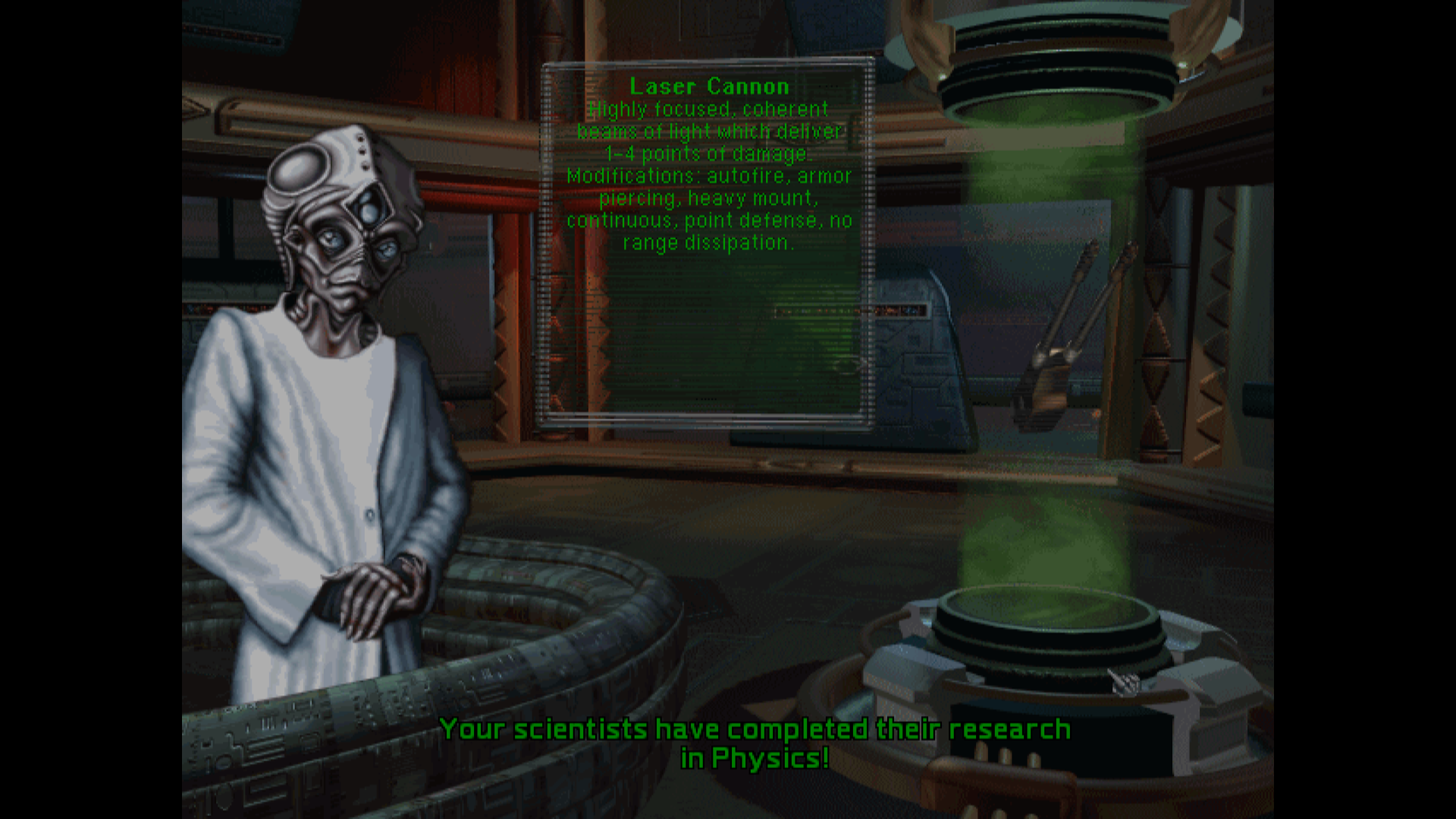 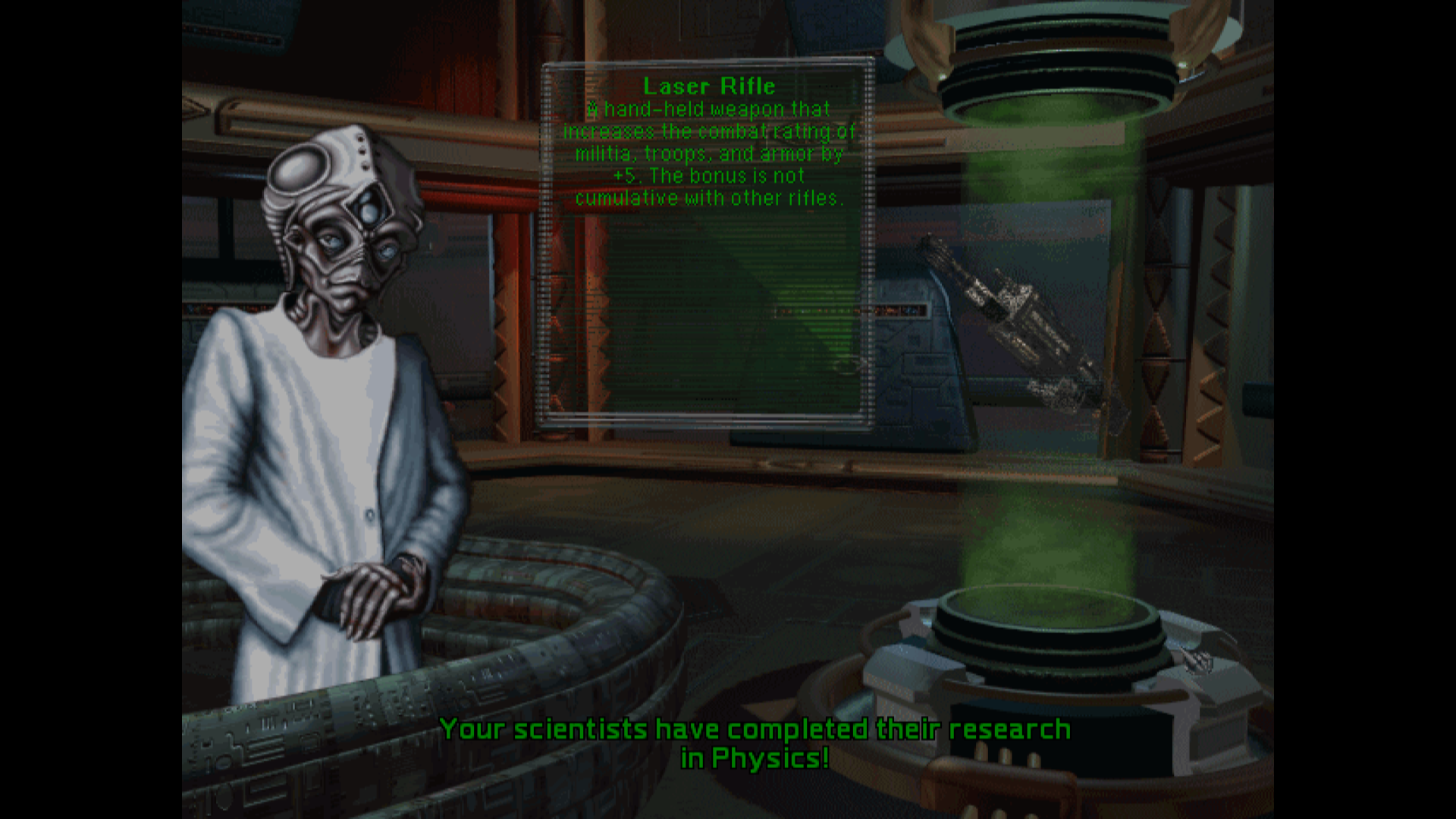 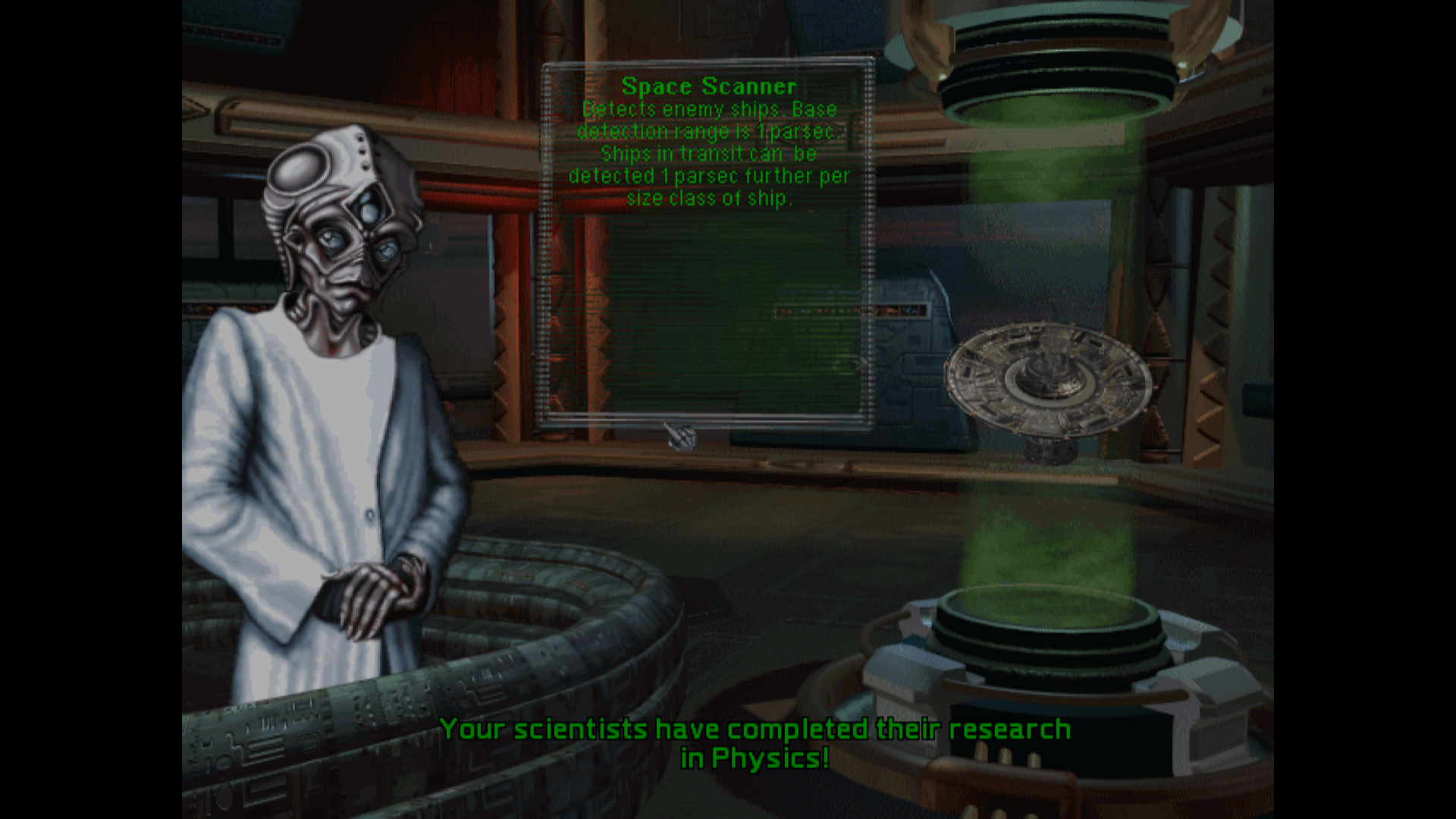 Two years later, review of the scientific data recovered by the Intrepid and Venturer led to a number of breakthroughs in basic physics. Although lasers had been known as a technology for many years, a firmer grasp on the underlying principles allowed for the development of compact, reliable, and efficient solid-state laser emitters that could serve effectively as weapons on any scale from hand-held personal weapons to starship weapons. Development of high-capacity single-use batteries even allowed the deployment of effective void-to-void lasers on high-performance small craft without a reactor of their own to power a ship-scale laser. Meanwhile, analysis of the faint traces in realspace left by travel in hyperspace let standard sensor arrays be tuned to sweep for evidence of FTL travel. Sedan Insurance, the insurance provider for the shipyard orbiting over Nares, insisted at this point that the shipyard's owners either mount defensive weapons arrays against the risk of future piracy or suffer an increase in premiums. The shipyard consortium, in response, modified their original design to accept a number of launchers for nuclear shipkiller missiles- each nearly as large, in their own right, as a manned small craft, in order to produce the immense acceleration needed for their role- and an array of laser cannon. Star Bases are armed, and now that we have all the basic weapons technology needed to arm one, I present it as doing so. Meanwhile, massive investment had completed the colony mission that was to embark to the Vij system. Three years later, in 469 YE, the colony on the newly-named planet Sadesal would be established. With Sadesal now home to a Narestan population, the slow progress of a circle of trade between Vij and Tel became a reality. Our high income means we can afford to rush-buy things earlier than might be expected. 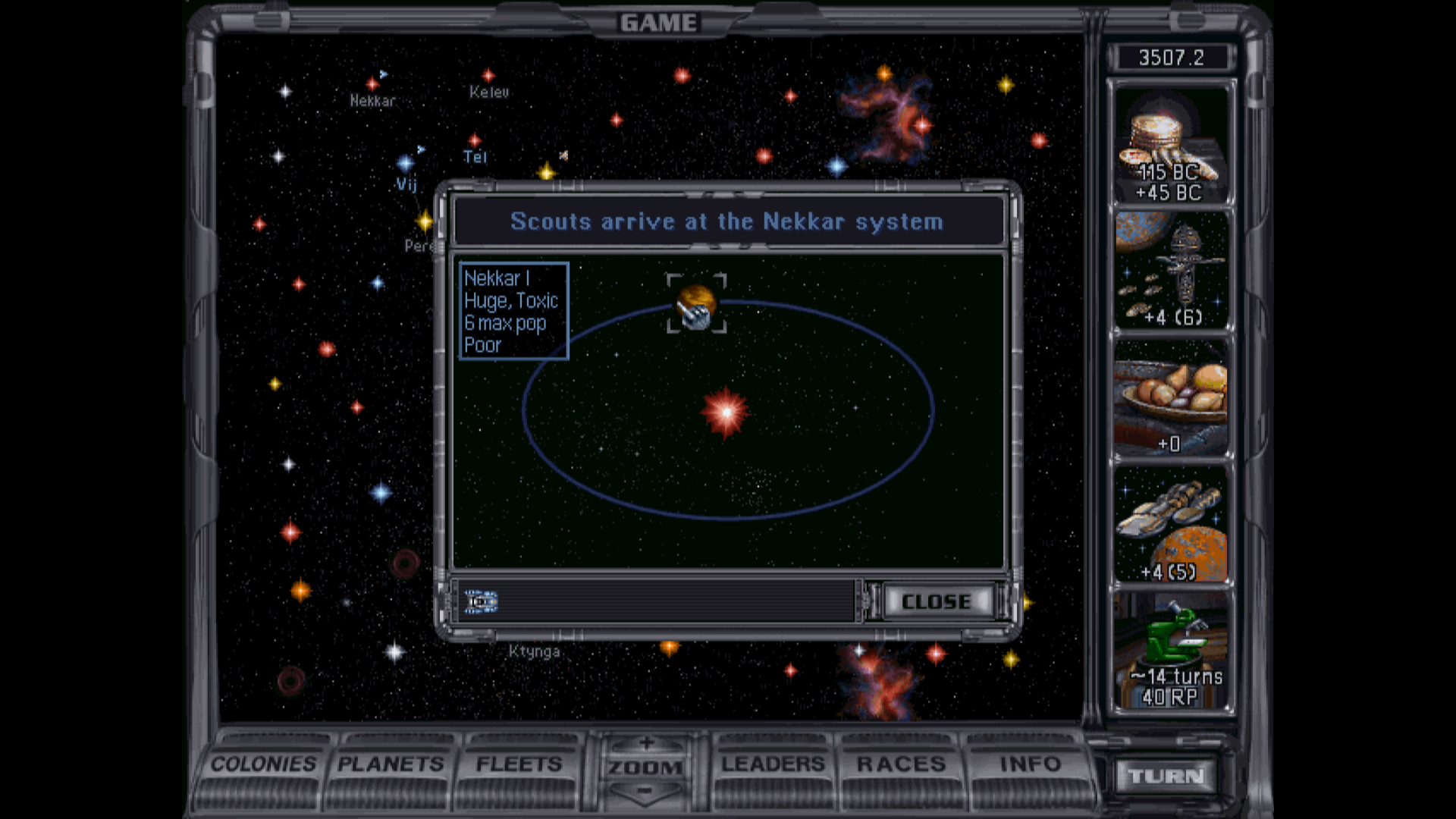 Three years following that colonisation, the red star Nekkar was explored by the Intrepid. In the inner system was only one body of particular note- a massive planet with concentrated acidic seas covering much of the surface and an atmosphere of highly corrosive vapors. Unfortunately, despite the planet's size, it seems a poor candidate for future colonisation. 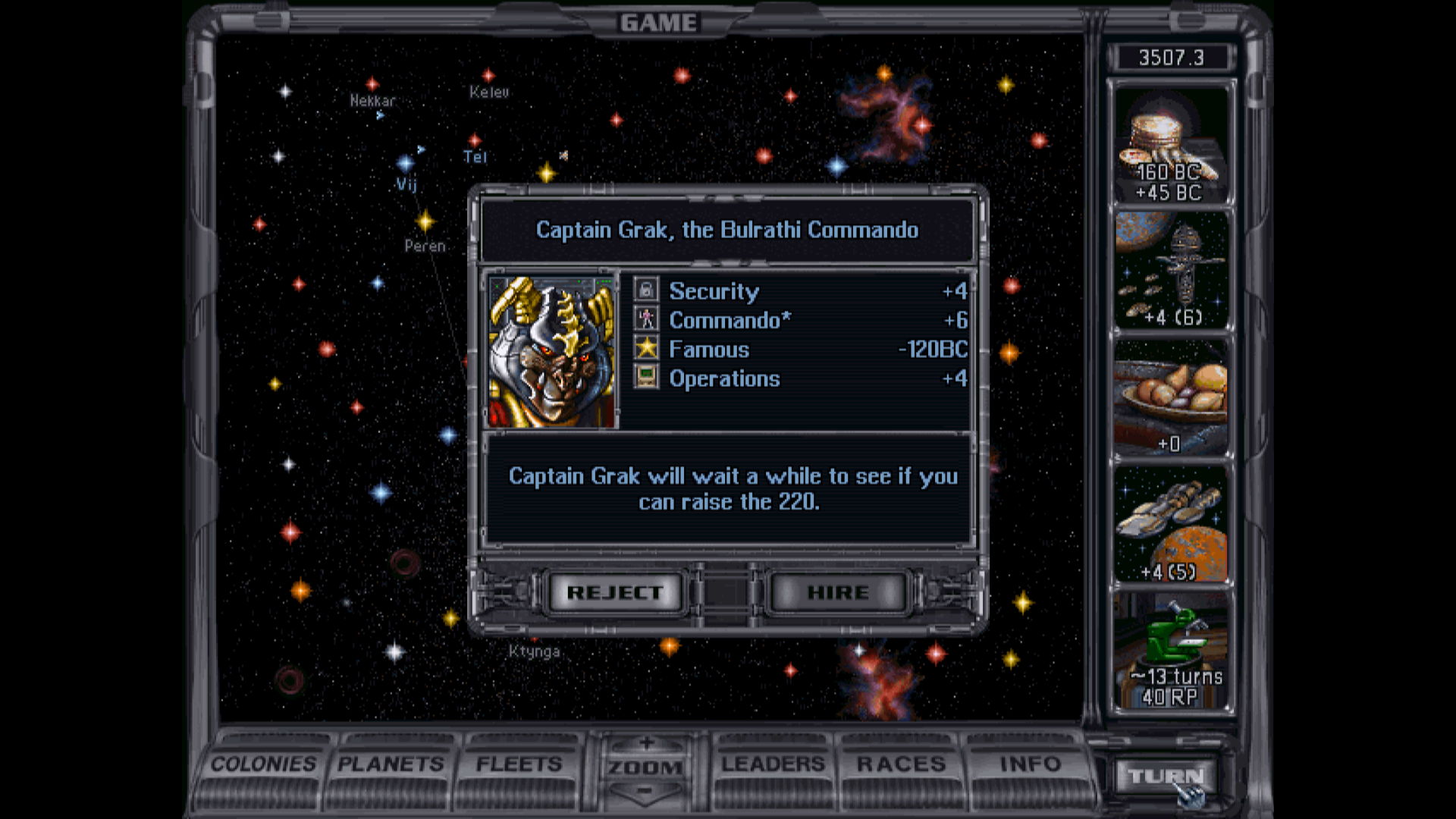 Discussion of the security challenges facing a FTL civilisation and hypothetical analysis of threat response tactics began to be a serious topic amongst security firms. Attention to interstellar command and control and logistics, if properly prepared for, might help allow for more efficient space security, while intensive training in established surface tactics and educational programs for promising security officers might help in future security actions and the cultivation of new talent. Our expert commando leader will help discount future leaders (and existing leader upkeep costs), help us support more ships through the Operations ability, and helps make surface and boarding combat much more effective. Development of Narestan planets and preparation for future colonisation continued steadily over the following years, slowly cementing the Narestan place amongst the stars. Narestan Civilisation as of 480 YE  Nares now has nearly 14.4 persons in population, with population growth slowing as the cities continue to grow larger on the planet's surface. The ease of trade with other planets that its spaceport facilities has engendered has helped drive a massive increase in specialisation of industry on Nares, with the corresponding increase in productivity and local incomes. Colonists and investors for another interstellar colony mission are being gathered, with Narestan ambition eager to find what opportunity can be forced from the worlds within range. 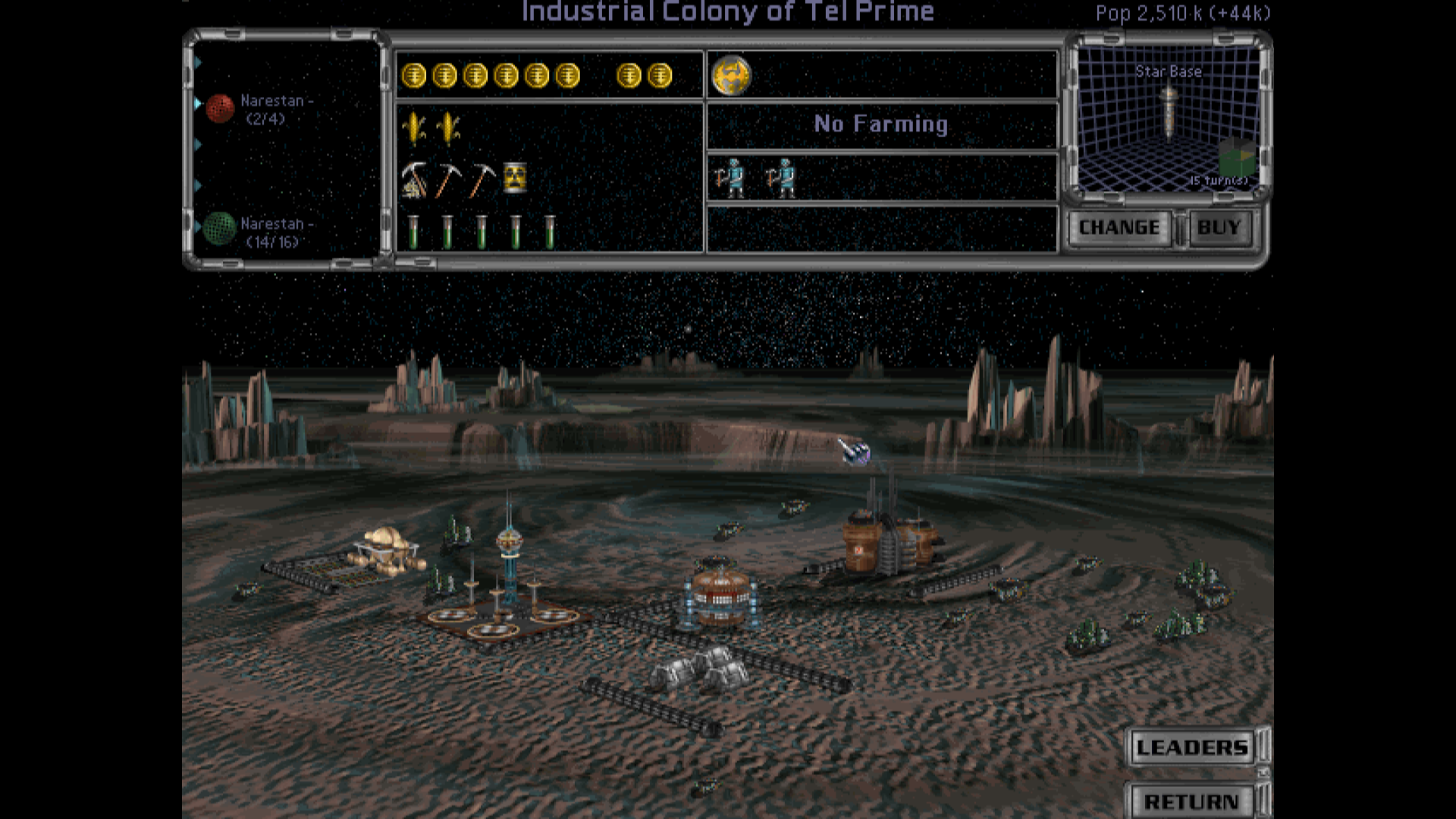 The growth of the local population, now over two and a half billion, coupled with growth in interplanetary trade has seen a massive leap in the the sophistication of Sedal's economy. Although its previous agricultural exports are a thing of the past, Sedal could continue to survive as a self-sufficient colony maintaining all its current infrastructure, while still benefiting from trade and specialisation between planets. Work continues steadily on an orbital shipyard over Sedal. 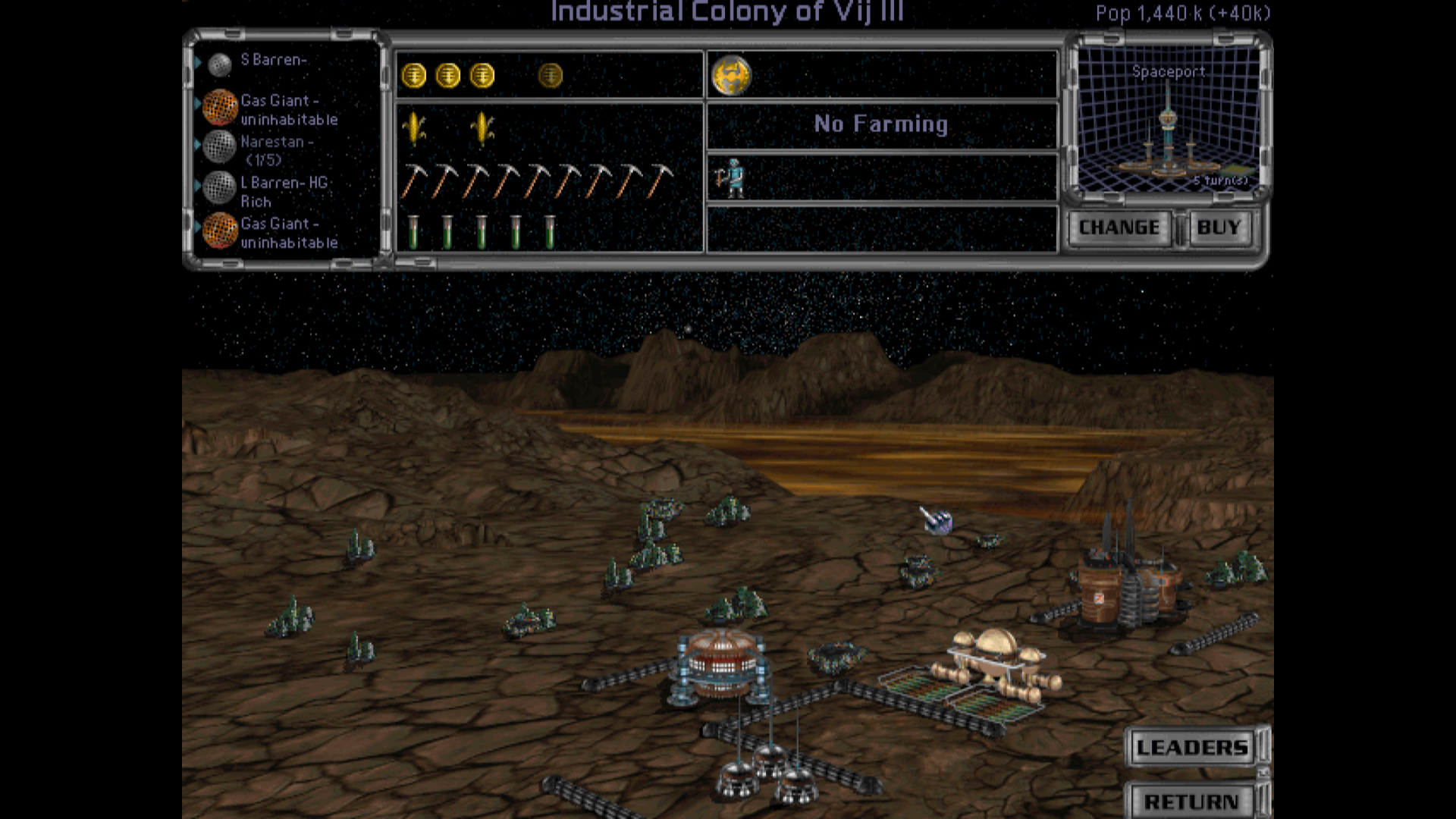 Sadesal, like Sedal before it, is a planet dependent on specialised imports from richer, more developed worlds to help support its rapidly-assembled infrastructure. Also like Sedal, it has relied on exports of agricultural produce from its sealed industrial farms and the export of basic scientific data and some high-tech components to finance needed imports. Construction of its own spaceport complex is under way on Sadesal.  The past decades have seen a major surge in the rate of accumulation of investment capital, driven in large part by the growing network of Narestan trade. Innovation has increased slightly, primarily driven by the small scientific and technical community on Sadesal. Narestan civilisation now is a genuinely interstellar civilisation, although the stars beyond Tel remain fairly short of promise. Even so, the Narestans hardly intend to let this stop them creating a grander and richer civilisation amongst the stars. Investment Proposals Security Firm Organisation Investment in security firms to help enable the implementation of the set of ideas discussed in the security community could have a number of long-run benefits, even if Narestan civilisation remains at peace as things stand. Please vote on whether or not to hire our new expert commando leader. Research Priorities Development of advanced industrial robotics is well under way; other R&D funding has been flowing to biological and agricultural sciences, the development of improved drive systems, improved materials science, and the development of a formal theory of space warfare by security firms. Please vote between Soil Enrichment, Fusion Drive, Tritanium Armor, or Space Academy for our next technology following Robo-Miners. Colonisation Priorities Peren Prime and Kelev Prime appear to be the least unpromising planets for colonisation in the immediate region, although which to prioritise first is still in discussion by mission planners. Please vote between Peren and Kelev for our next colonisation target. The steady improvement of Narestan prosperity has continued for the past two decades, with even greater breakthroughs to come soon. The Narestan people remain alone on the galactic stage, curious as to whether any other societies are there to be found amongst the stars.
|
|
|
|
Shipkillers, Laser Cannon, and Attack Boats- the Basic Theory of Void Combat Theorists of void combat in this interstellar era note three basic technologies available for assembling forces capable of engaging enemies and pirates in space. The shipkiller missile and laser cannon are each basic weapons systems capable of engaging targets at spaceborne velocities and ranges, while the attack boat, a security variant of high-performance civilian small craft, is, in many ways, a hybrid of both these basic technologies. The shipkiller missile consists primarily of a very large propulsion unit, fitted with high-power attitude thrusters, a basic sensor and seeker package to home in on its target, and a high-powered nuclear warhead. Once in close proximity to its target, rather than risking overshoot by an attempt at a contact intercept, the warhead will detonate, searing its target with the intense wave of photons created by the nuclear event. Over 50% of the warhead energy is lost uselessly to all sides, but nonetheless nuclear shipkiller missiles are anticipated to deal severe damage to any target. The relatively limited guidance package on shipkillers means that initial launch requires a turret for a launch tube, oriented to roughly capture its target in its sight window, and the high output of the propulsion unit requires a magnetically-assisted launch before the shipkiller touches off its primary drive, lest the missile destroy itself via propulsion backblast before it ever reaches its target. All this means that the required supporting machinery for a shipkiller launch tube is significant. Laser cannon capable of engaging at the distances of space combat are high-output solid-state arrays that need the formidable input energy available from a starship fission or fusion reactor, unlike lower-output land vehicle laser weaponry, which draws power from conventional engines. Laser cannon deal modest damage, but should be capable of effective engagement of hostile shipkillers or attack boats, giving them a vital defensive role. The conversion of power into coherent light in lasers remains a very low-efficiency process, with huge amounts of heat being produced by ship-mounted laser cannon. In order to deal with this heat buildup, each laser cannon has its own radiative heatsink array installed on the hull surface surrounding the laser cannon, helping mitigate this issue before its electronics fail and the internal temperature of the ship rises to untenable levels. Attack boats, for their part, have a propulsion unit very similar to that of a shipkiller missile, with a frame wrapped around this mounting its own sensors package, command compartment, weapons system, and even heavier manuever thrusters. The command compartment is either a lightly-armored crew compartment with a cushioned seat for the pilot, flooded with an oxygenated breathing medium as close to the density of the Narestan body as possible in order to minimise damage from G-forces, or a sophisticated package of computer equipment, transmitters, and recievers allowing remote drone piloting of the attack boat by an operator on its host vessel. The weapons system for an attack boat is a light laser mount, which has overcome the challenges of power delivery for lasers in a void environment by use of specially-designed high-density batteries that effectively slag themselves with each shot, thus serving as 'ammunition' for the weapon. Although each attack boat is somewhat larger and more complex than a shipkiller missile and requires support equipment for refueling, rearming, and maintenance, the displacement required for a four-boat squadron bay is only half again as much that of a shipkiller launch tube, its associated turret, and magazine space for five missiles. This is achievable in large part because the intelligent guidance of attack boats allows them to 'swim' out of their bay under maneuver thrusters, orient on a target, and light off their primary drives at a safe range. Attack boats are expected to be able to effectively make intercept with targets ranging from other attack boats and shipkiller missiles to hostile ships, and should be extremely effective as missile hunters due to their ability to engage at minimal range. In the event that an attack boat's target is neutralised, it can easily choose a new target to attempt intercept with. Attack boats are low-endurance weapons, with only four shots in their laser before they must return to their home vessel to refuel and rearm, which is done by making intercept with its home vessel and then 'swimming' back in to the squadron bay. The squadron bay, for its part, is kept permanently in vacuum with airlock access to the rest of the ship, with vacuum-suited support personnel to rapidly service the attack boat before it is launched once more. nweismuller fucked around with this message at 02:32 on Mar 27, 2017 |
|
|
|
Hope these lore posts are proving interesting to people. I enjoy writing them up.
|
|
|
|
Teledahn posted:This is a good post. There are, currently, three main schools of thought with their own proponents. Some advocate a pure attack boat strategy for potential void combat, thinking that attack boats will be able to thwart any missile-armed threats and effectively launch offensive strikes. The other two schools believe a hybrid approach might be more viable. One side believes that reliance on missile volleys from long range as primary offensive firepower will be reliable and powerful, using carrier escorts to protect against missile counterfire or launch offensive strikes as the situation warrants. The other believes that development of long-range kinetics could effectively defeat enemy armor and do absolutely devastating damage from long range, again backed up by escort carriers that can flexibly operate either defensively or offensively, and which would likely be able to use better kinetic weapon technology to upgrade their attack boats. Do feel free to advocate for any of these sides.
|
|
|
|
cheetah7071 posted:What difficulty is this LP being played on? Normal. I tend to prefer Normal playthroughs on 4Xs, mostly because 'transparent cheating by the computer' isn't terribly fun for me, even if I'm good enough to overcome it.
|
|
|
|
Did you have a nonaggression pact with anybody you got framed with? Having a nonaggression pact broken by you conducting espionage counts as an oathbreaker thing, and being framed saddles you with those consequences.
|
|
|
|
Wayne posted:Edit: Oh, yeah, I forgot but my brother was watching at that point and reminded me; but I actually made a research treaty and non-aggression pact with the mrrshans once, and then lost contact when the silicoids wiped out one of my colonies. When contact resumed, all my treaties with the mrrshan were gone. I didn't have any problem making friends with them again at the time, but now I wonder if the game counted you as breaking those agreements. In my experience, loss of contact cuts trade and research treaties, but not non-aggression pacts- if your non-aggression pact was broken, that suggests more happened than just loss of contact.
|
|
|
|
Trade on Alien Shores By 482, major breakthroughs in robotic automation revolutionised mining, construction, and industry in Narestan society. Heavy equipment able to be programmed for semi-autonomous operation and capable of high-precision remote operation for delicate tasks that required Narestan judgement allowed for most of the difficult and dangerous tasks in mining, construction, and forestry to be handed off to robots and drone operators, while continued advancements in design of robotic assembly lines and industrial equipment allowed factories to continue to expand their capacity. As the new technology was quickly adopted, mines were pushed deeper, production of raw resources was increased, and factories expanded their operations to churn out the equipment and goods needed by Narestan civilisation. Preparation for a second interstellar colonisation mission accelerated.  Within a decade of this breakthrough, in 492, a new colony was established on Telesen, the radiation-seared planet orbiting closest to the red star Kelev. Despite the hostile environment and relatively poor local resources, Telesen nonetheless seemed to be one of the best candidates for exploitation by Narestan colonists in the immediate area, who were hoping to overcome the challenges of creating a prosperous colony through ingenuity, industry, and technology.  A short time later in the year, Narestan colonists on Sadesal were shocked by the appearance of an alien communications probe in the Vij system. Sending a probe back to the alien probe's source strained the capacity of current reactor design to the utmost, but nonetheless eventually enough information was gathered to translate the language used by the alien probe. The Interstellar Union of Yilaria and its Colonies, a government unifying the Mrrshan species, had achieved sufficient operational range to reliably send long-range ships and probes between its territory and the Vij system. A consortium of interested companies and investors overseen by a new Board of Directors hammered together an ad hoc framework for negotiations with an alien unitary government, and prepared to see what opportunities could be achieved in dealing with the Mrrshan.  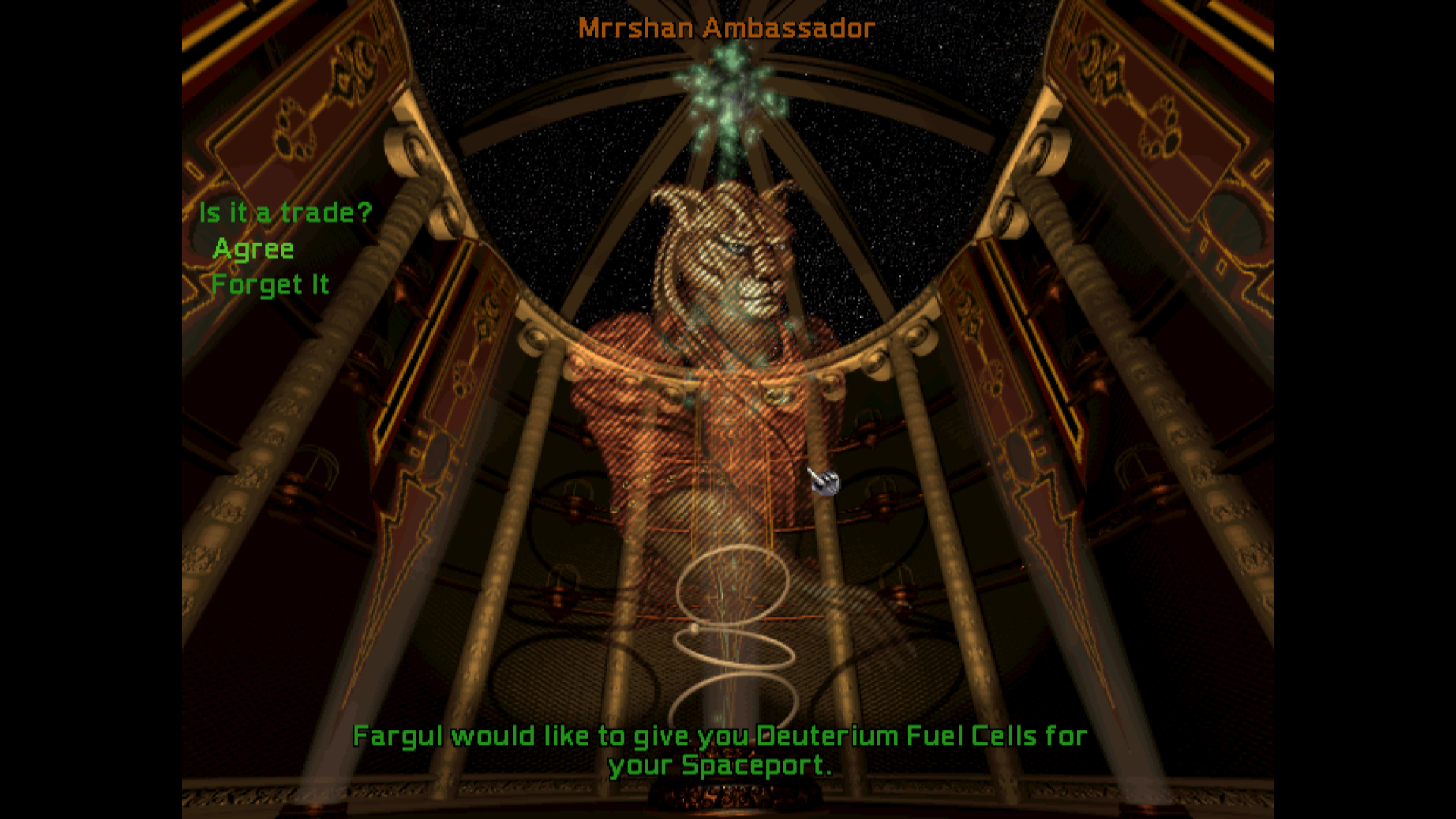  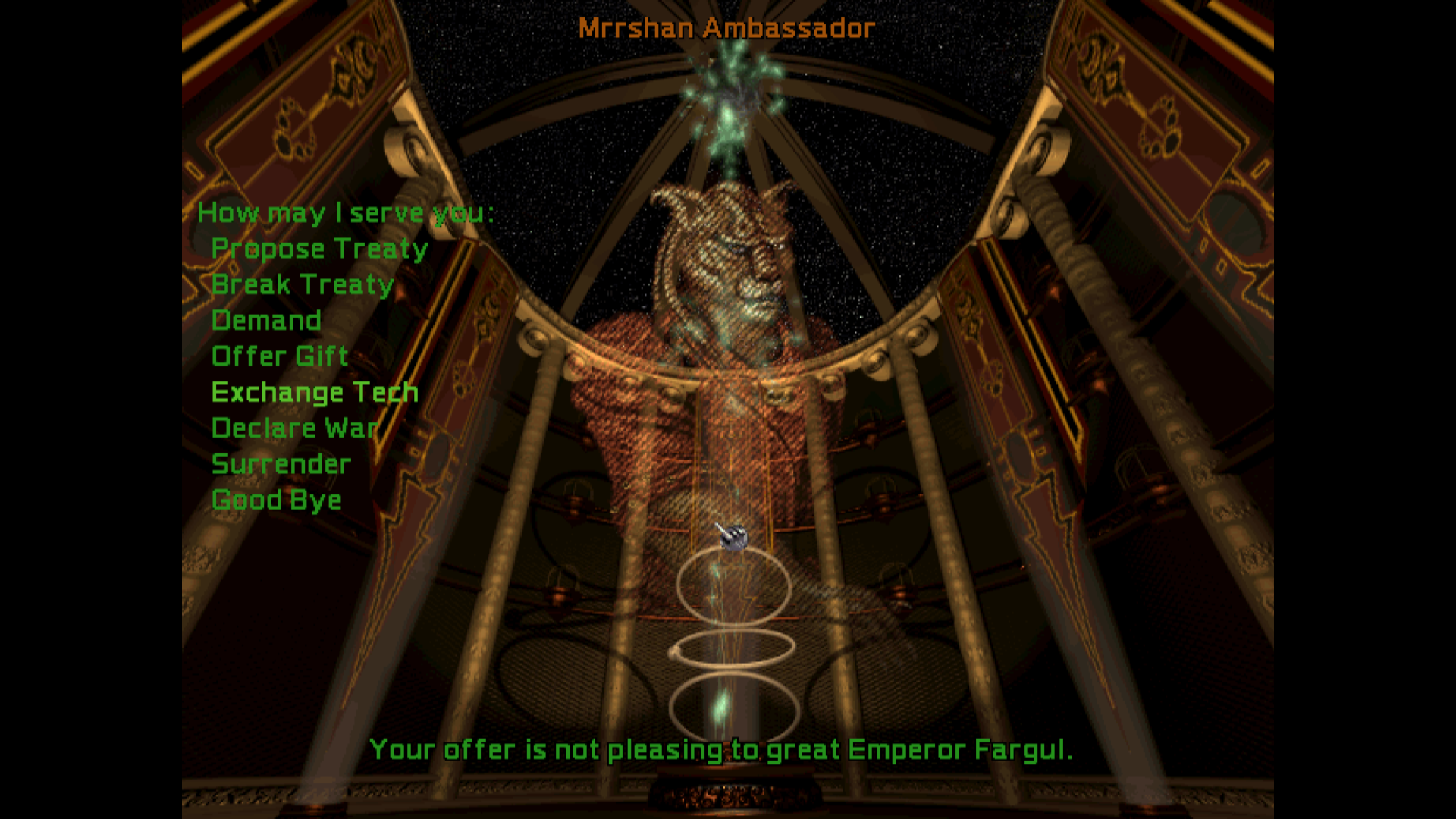 Early negotiations with the Interstellar Union in 492 were fairly productive. The Mrrshan had developed methods to use heavy isotopes of hydrogen to squeeze more endurance out of a given volume of fusion reactor fuel, which allowed for greater operational endurance for their spacecraft and probes. The ad hoc diplomatic consortium negotiated data on this technology in exchange for Narestan information on cargo mass drivers, orbital spaceports, and other innovations that expedited interplanetary trade, then parlayed this into permission for Narestan shippers and investors to begin to do business in the Interstellar Union's territory, while Mrrshan shippers and businesses could begin to visit Narestan territory. Efforts were made to get legal barriers to coordination of Narestan research departments with counterparts in Mrrshan territory removed, but the Interstellar Union's government was reluctant to permit this, at first. Investment capital began to be sunk into financing trade between the two species. 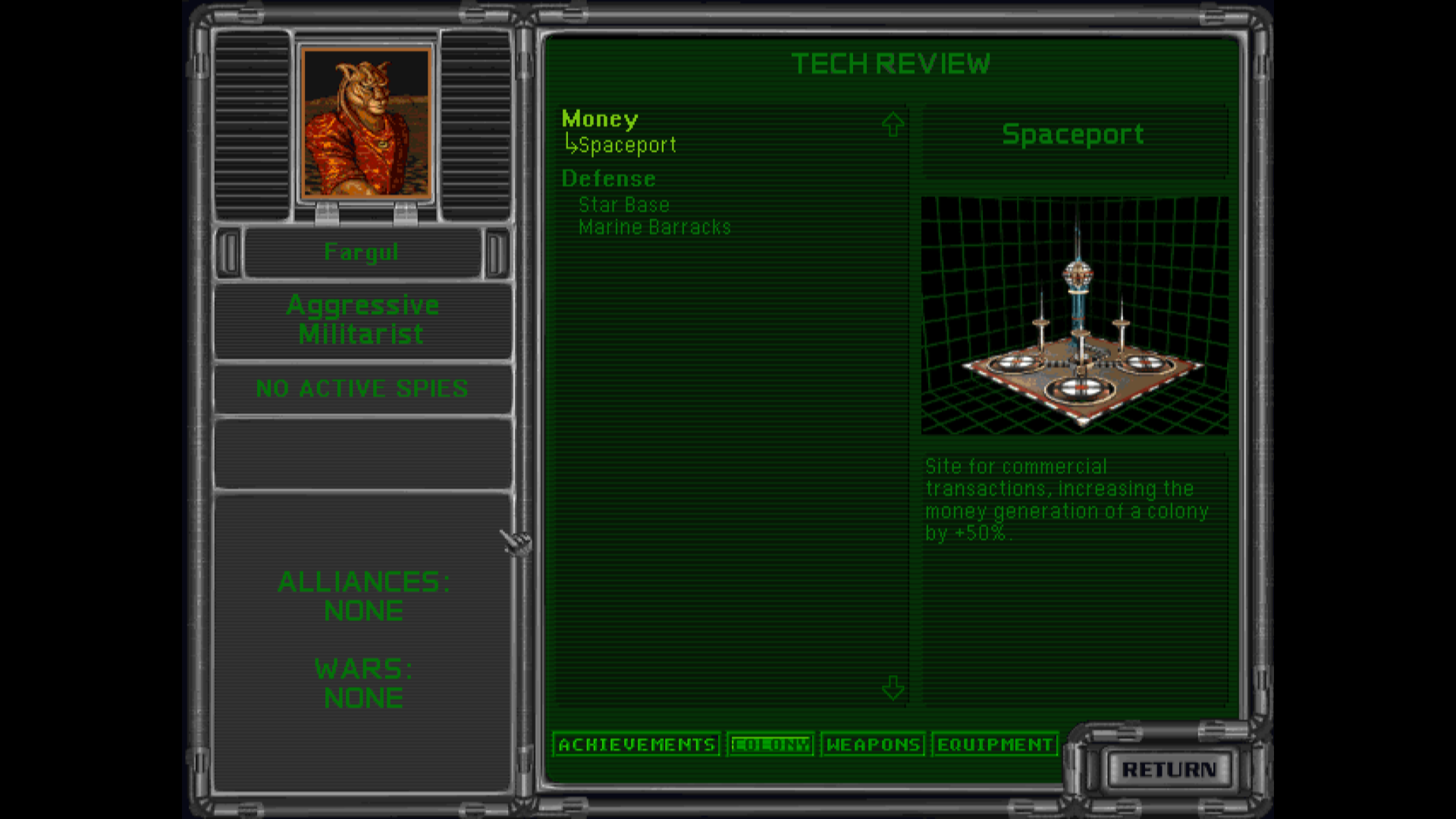 The Interstellar Union is the Mrrshan answer to endemic societal violence and warfare that previously plagued their species, a carnivorous mammaloid species. Instinctive Mrrshan territorialism and hunting behaviors render them touchy and violent outside of their familiar peer groups, with successful Mrrshan societies developing layers of hierarchical domination to force cooperation between different groups and elaborate codes of formal courtesy to ease contact between strangers. The various Mrrshan nations were eventually unified under a single military government headed by the High Marshal of the Armies and Navies. Mrrshan military doctrine emphasises tactical flexibility and independence of operations by individual commanders, and the ingenuity displayed by Mrrshan strategists, logistics officers, and tacticians is remarkable, allowing their forces to operate with an extremely high degree of effectiveness and with an extremely efficient military supply chain. Personal and economic freedoms amongst the general populace are subject to sharp and arbitrary curtailment by the government in the interests of avoiding threats to the ruling power, but a private economy continues to operate under stern government management. Personal weapons for hunting and marksmanship are a matter of art amongst the Mrrshan, and, despite Mrrshan curtailment of personal liberties, the right to personal firearms and blades below the effectiveness of military standard is unchallenged. Even with strict codes of courtesy, honor duels remain common amongst the Mrrshan. 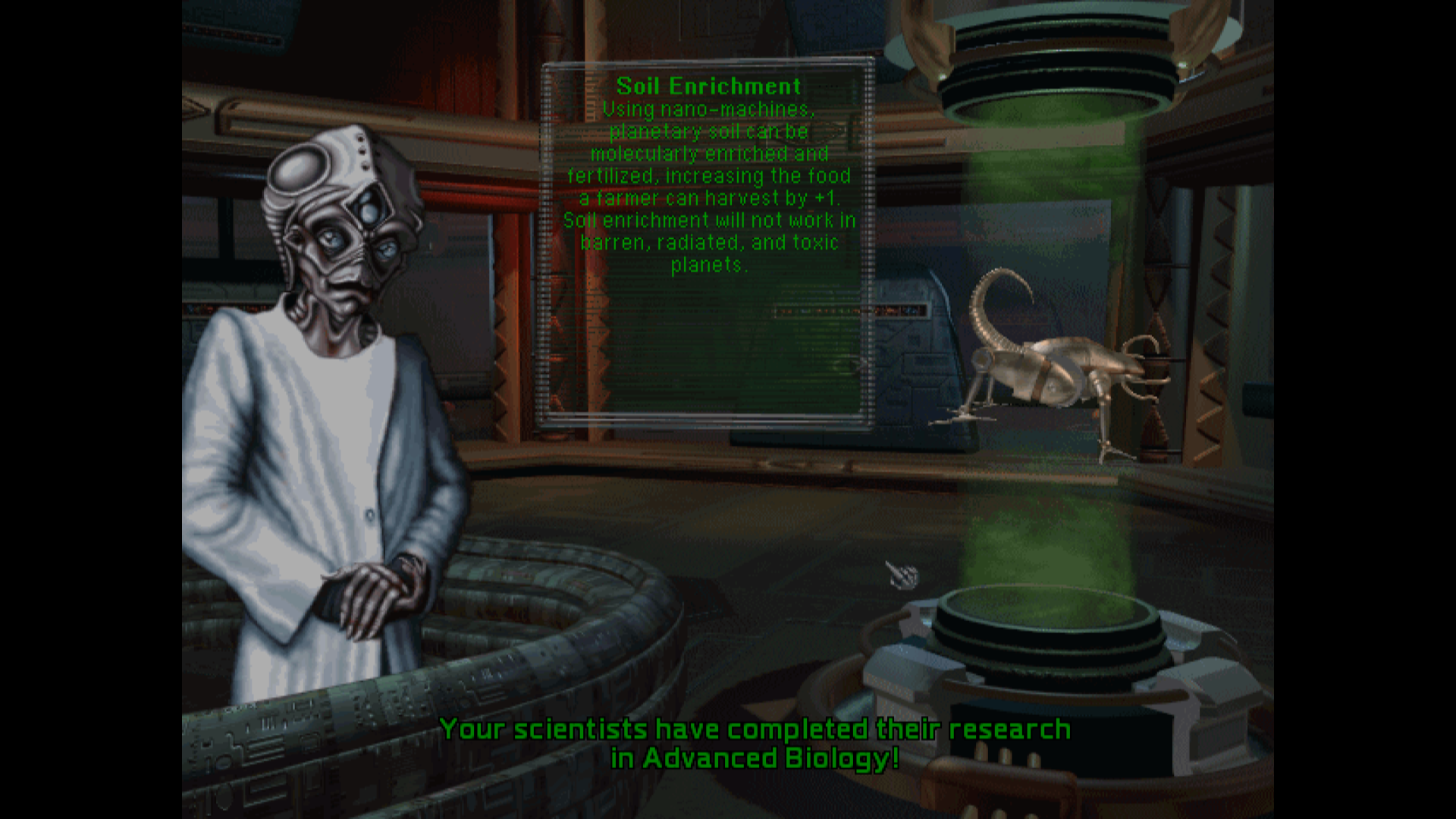 Meanwhile, by 493, Narestan researchers had developed a series of genetically-engineered microorganisms that could be introduced into the soil of agricultural land to create a self-renewing fertilisation process that would help promote healthy plant growth, increasing yields both of vegetable food and of feed for livestock. These microorganisms had been introduced by agricultural concerns across Nares within a year, leading to a boom in agricultural productivity which eventually led to a reduction of the land area under agricultural cultivation, a drop in agricultural employment, and cheaper food prices throughout Narestan society.  Continued intense competition between agribusiness concerns on Nares continued to push attempts to find ways to bolster productivity even further. Little changed at first, but, little by little, yields began to see improvement. 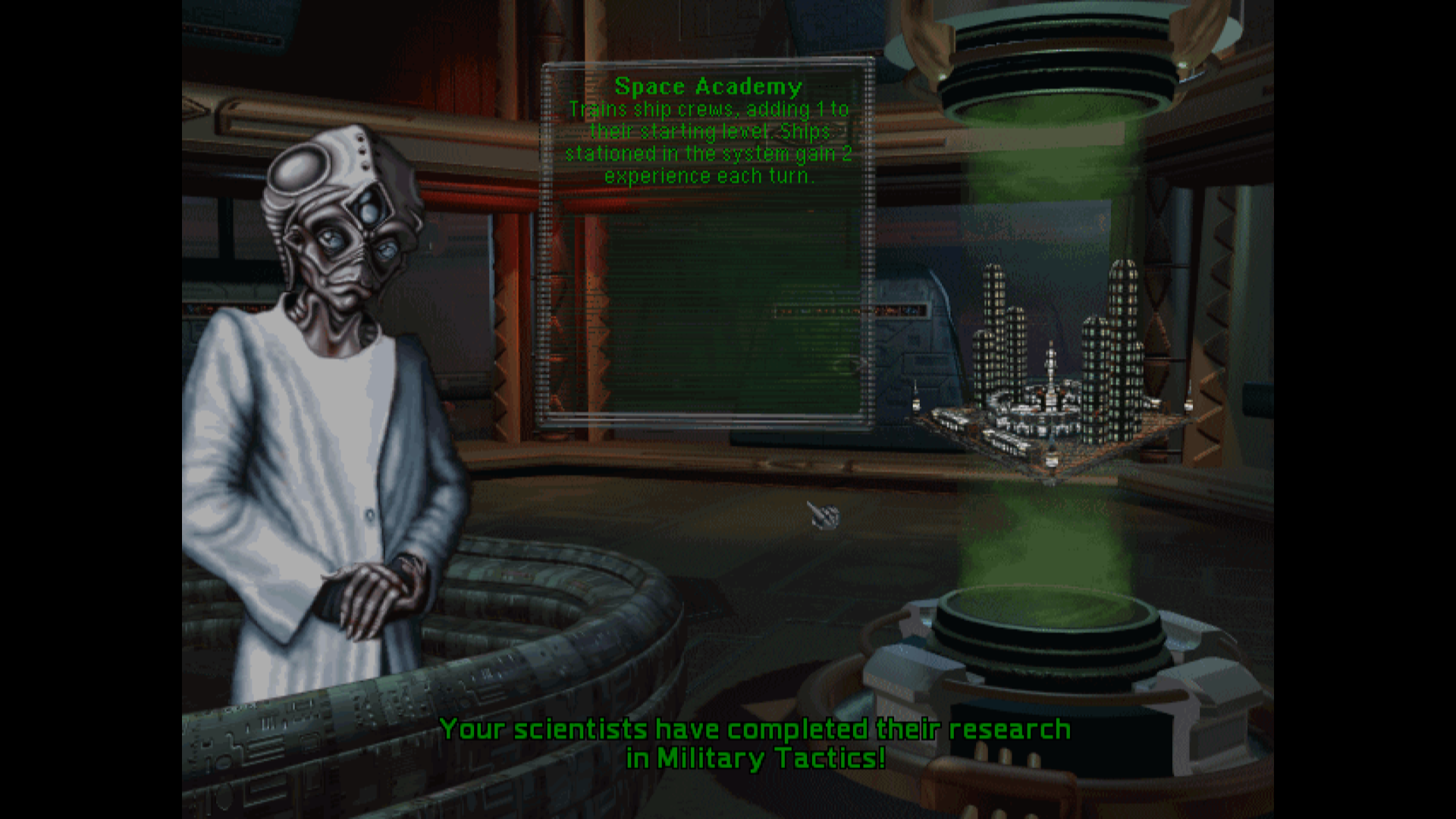 By 497, security firms studying the potential threats presented by piracy or by action from the Interstellar Union had finally evolved a firm theory of space combat tactics and practises, although the practical tests of their ideas remained in the future. Defensive positions in orbital shipyards should prove sufficient to secure planetary colonies against many threats, while the development of mobile armed spacecraft to hunt and destroy hostile vessels could eventually prove critical to keeping spacelanes open to shipping. The immediate threat from the Interstellar Union was believed to be limited, given that it was not believed that the Union fielded military vessels with the necessary reactor bunkerage to cross the distance. For the moment, civilian trading vessels were all that crossed the space between the stars of the Union and those of Narestan society.   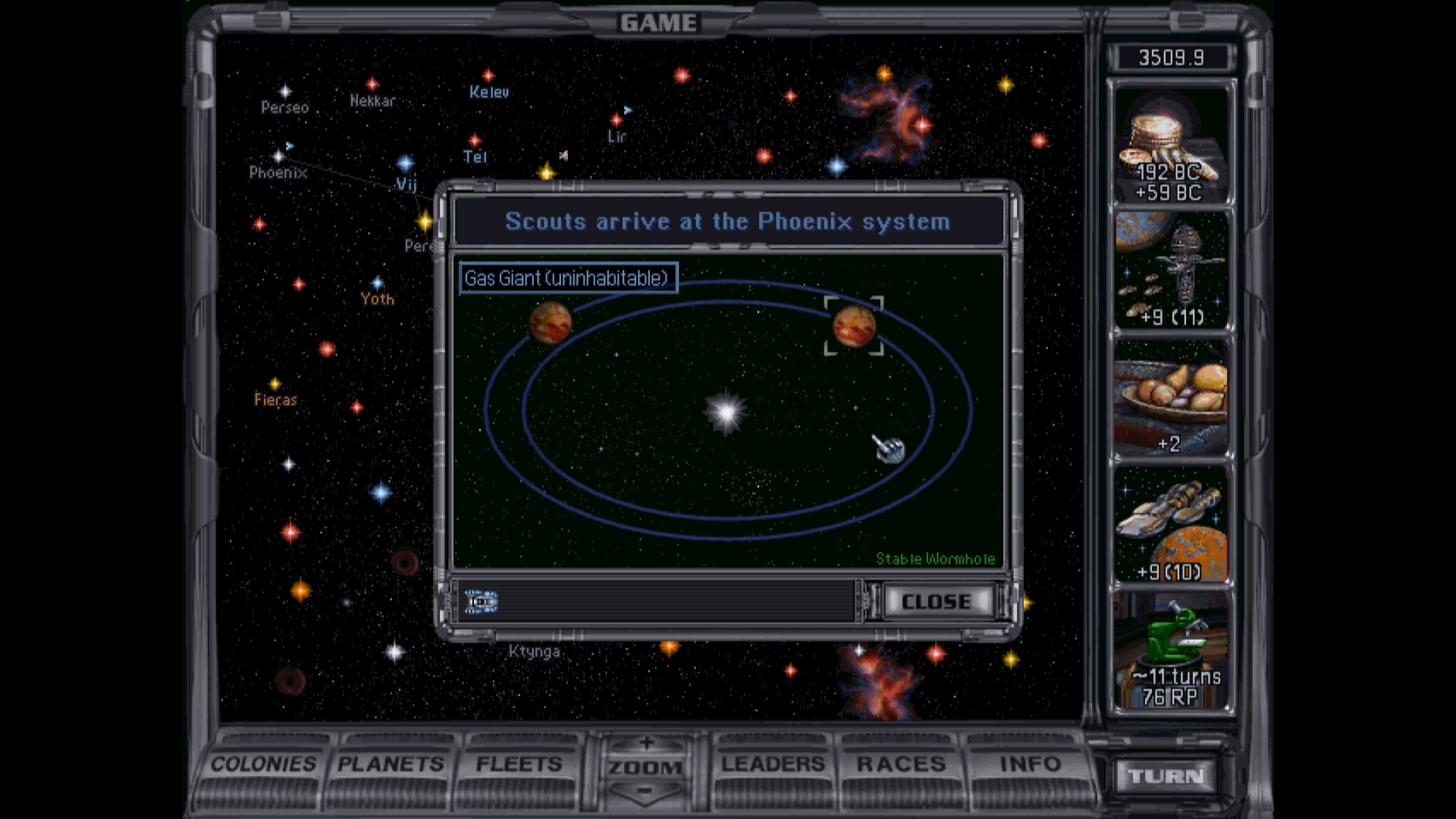 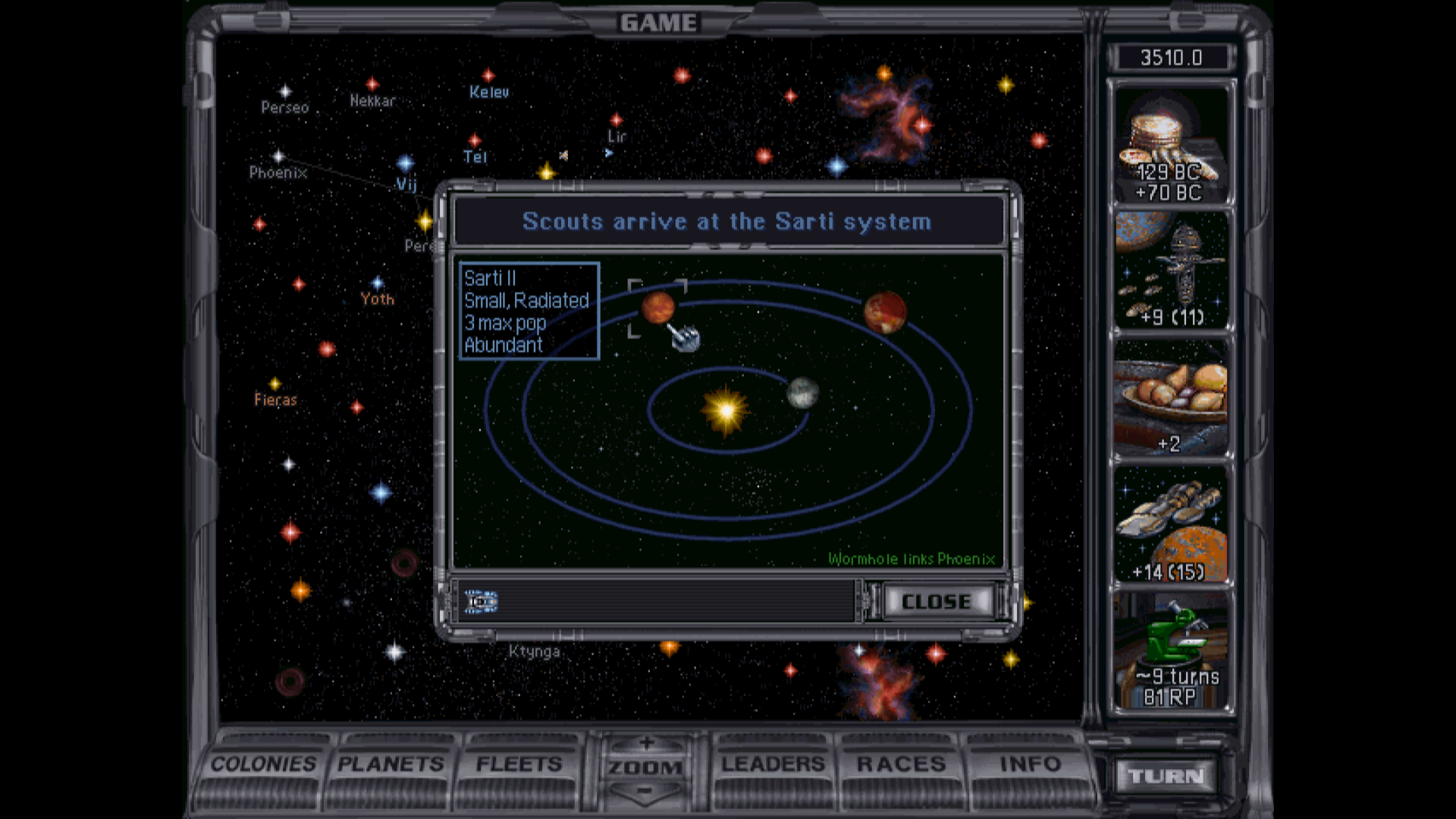 Improved reactor bunkerage had allowed the Intrepid and Venturer to strike out on new voyages of discovery. Although many of the stars they explored were fairly unremarkable in what could be found about them, the white star Perseo was found to have a planet with a nitrogen-oxygen atmosphere, wide oceans, abundant rainfall, and a biosphere largely comparable to Nares' own. Although this planet was somewhat smaller than Nares, nonetheless it proved an incredibly tempting prospect for future colonisation by the Narestan people. 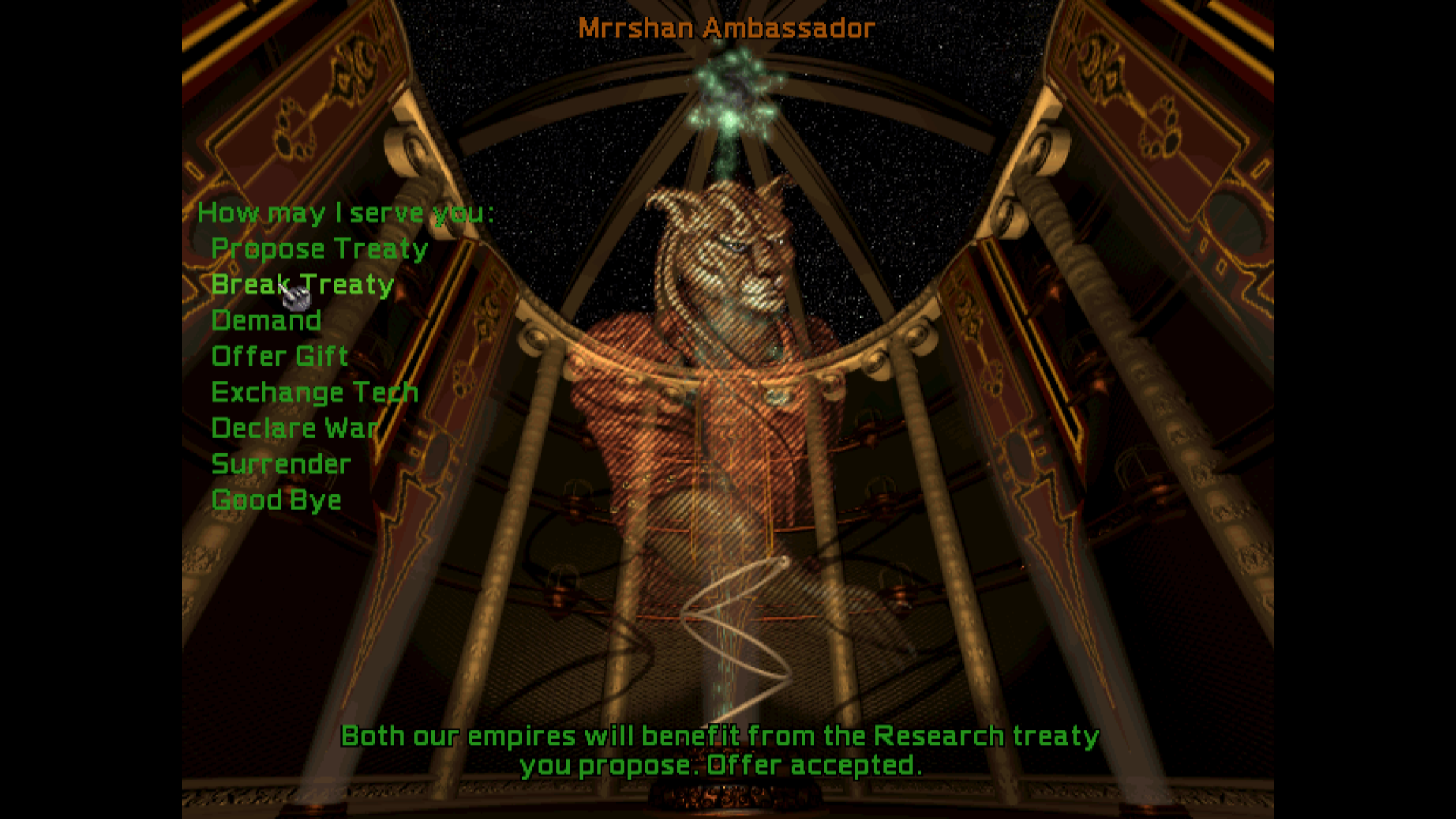 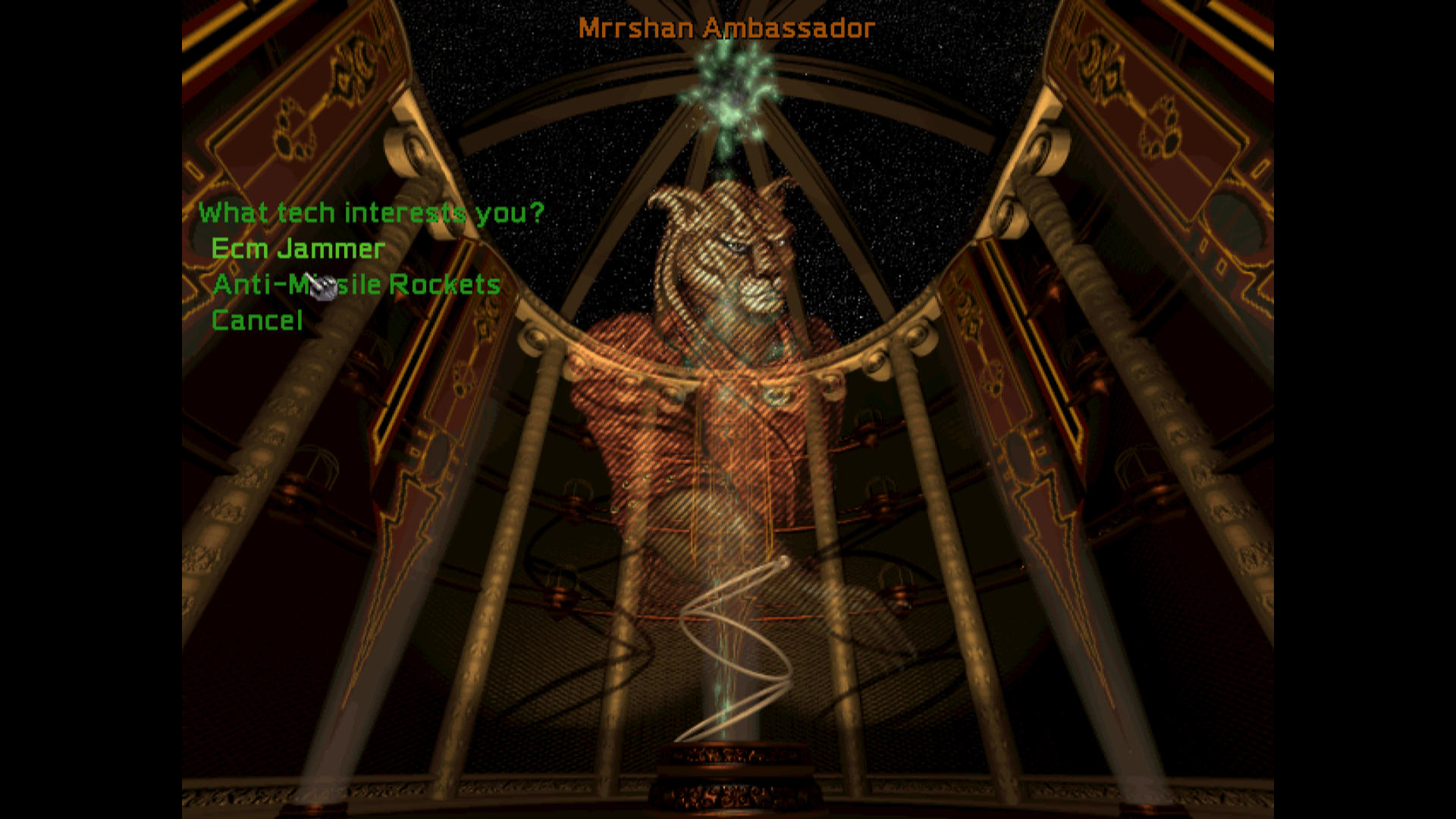 As 500 YE opened, the consortium handling negotiations with the Interstellar Union was able to negotiate for the Union to remove restrictions on research collaborations crossing the Union's borders and to minimise censorship of routine communications between the two civilisations. Although Mrrshan science was notably less advanced than Narestan science, nonetheless correspondence and cooperation between the two civilisations would likely nonetheless help bring new ideas to the fore. The consortium also sounded out advanced technological applications available to Mrrshan industry, seeing if domestic firms and investors would be interested in acquiring the data necessary to replicate these achievements. Narestan Civilisation as of 500 YE 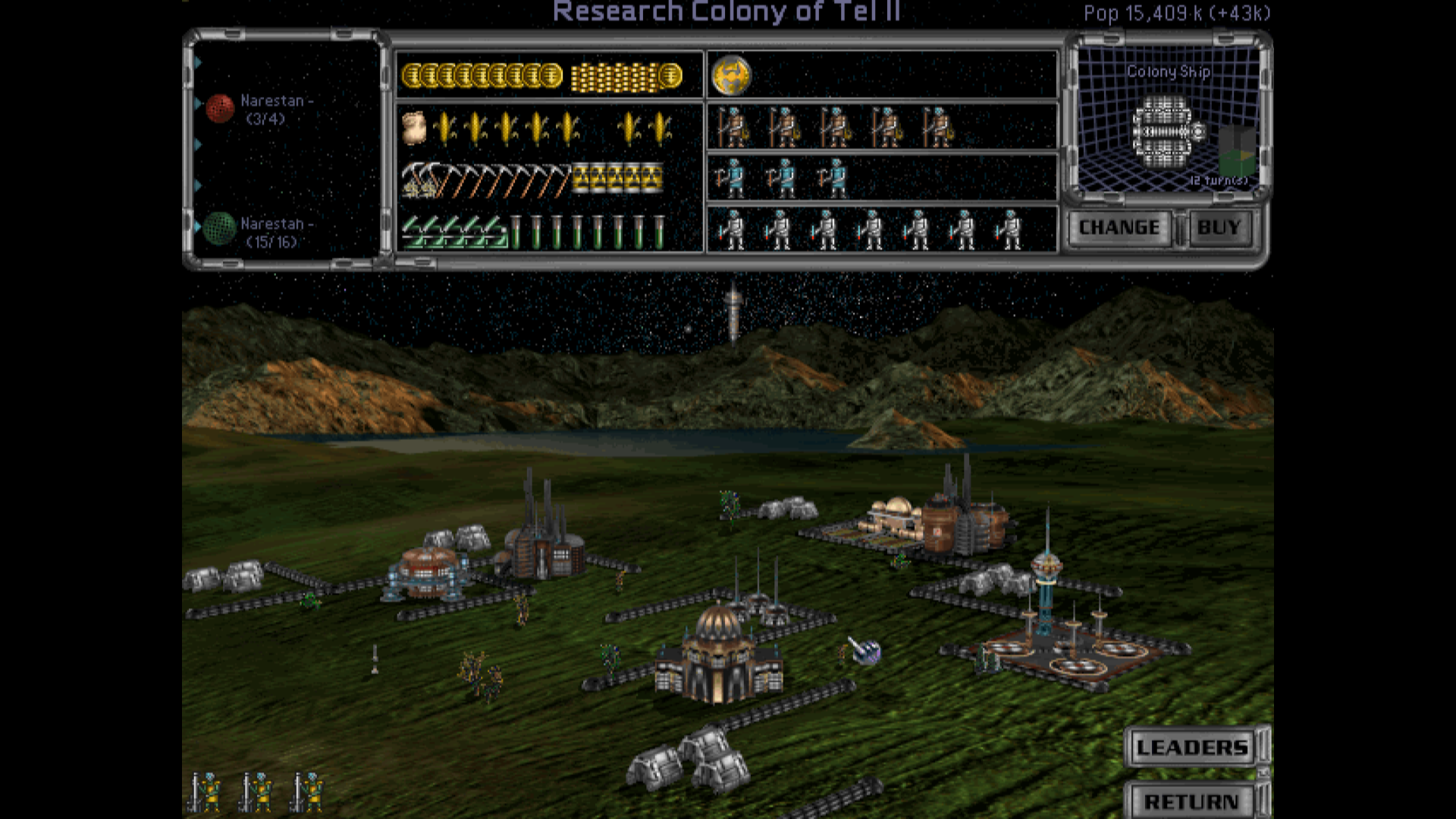 Nares is now well beyond fifteen billion persons in population, with population growth slowing as the planet's cities grow more sprawling and crowded. Much of the new population growth is now absorbed by volunteers for a new colony spreading Narestan civilisation to a fourth star system. Agricultural employment has dipped to approximately 250 million, a notable reduction from two decades ago, while industrial productivity has boomed with the new advancements in robotics and employment in scientific and technological development fields has sharply increased. Despite any crowding, the planet is more prosperous than ever before, with only growing issues with hazardous waste disposal marring the improvement of recent decades. 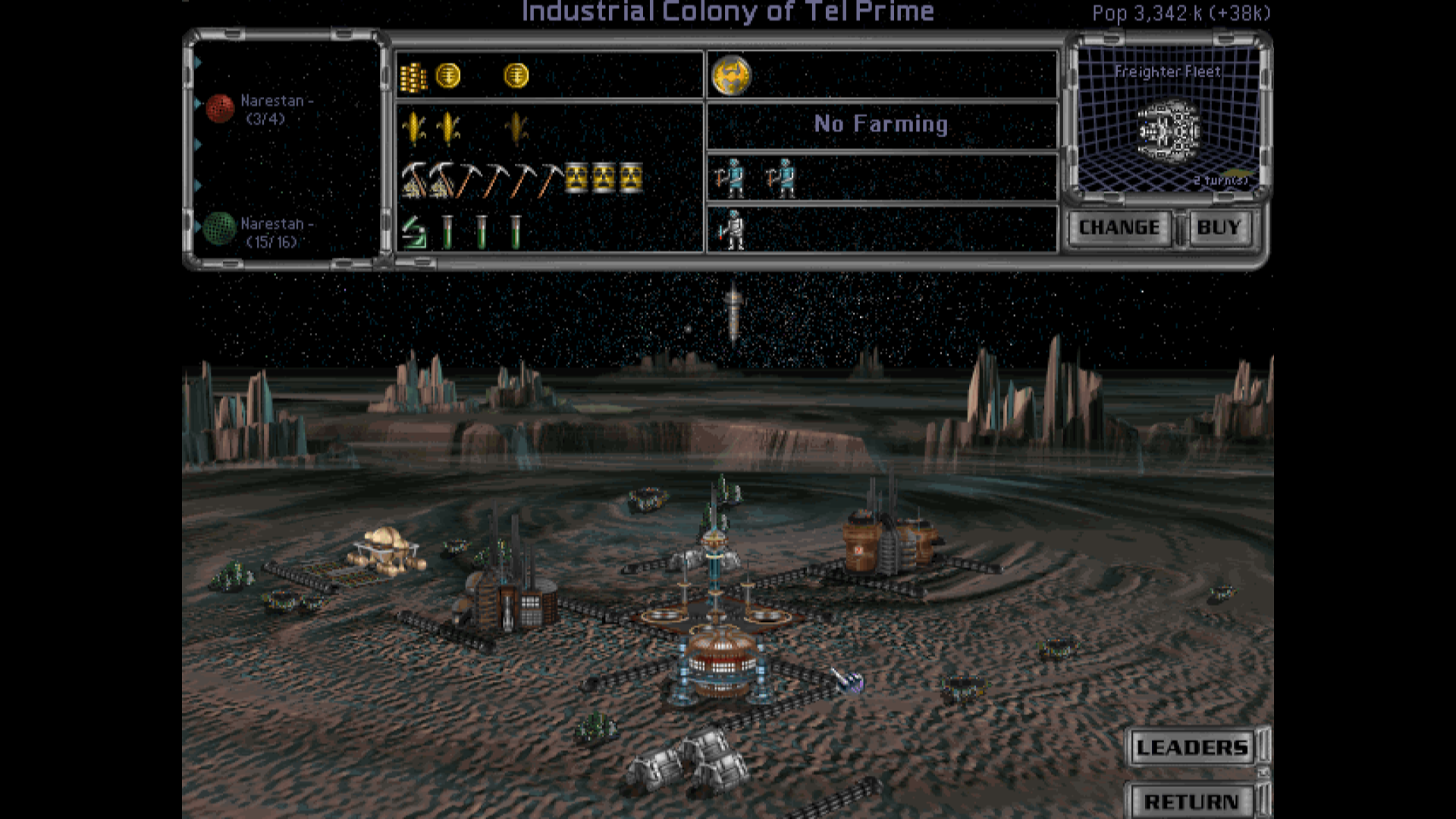 Sedal's population now exceeds three billion, with a growing network of R&D departments administered by local firms. Improvements of robotic technology in mining and industry have bolstered productivity, while a new armed and armored shipyard protects the planet and serves as the manufacturing center for more commercial shipping to expand Narestan civilisation's interplanetary transport capacity. The growing population has demanded food imports from Nares, which the increasingly productive local economy has no difficulty paying for. 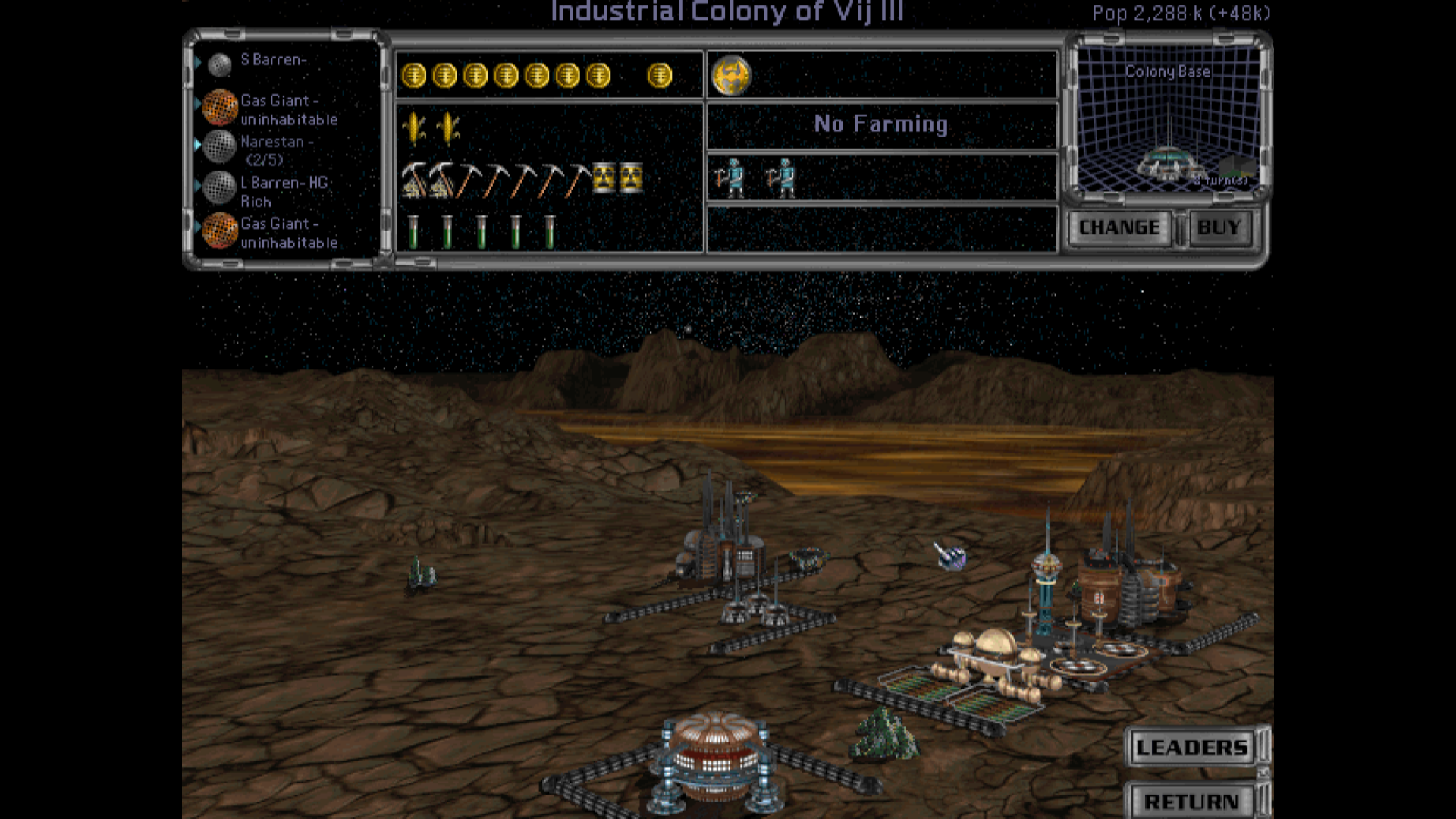 Growing populations and expanded trade have led to a growing sophistication in Sadesal's economy, which, like Nares and Sedal, has implemented new robotic technology throughout its mining and manufacturing sectors. Local specialty industries are able to provide the necessary components for local infrastructure, while trade and specialisation help bring new wealth. Sadesal has become a port of call for colonists beginning to set up a new colony on Vij Prime, eager to seek opportunity on new worlds.  The new colony on Talesen has somewhat over one billion persons, with thriving basic industry, industrial-scale hydroponics, and modest high-tech industry and local scientific data gathering. The local population has difficulty producing necessary specialty components to keep local infrastructure running on its own, making Talesen heavily reliant on imports of precision industrial machinery. As with the colonies on Sedal and Sadesal at similar stages of development, these imports are largely paid for by agricultural exports and the provision of scientific services for large R&D departments back on Nares. 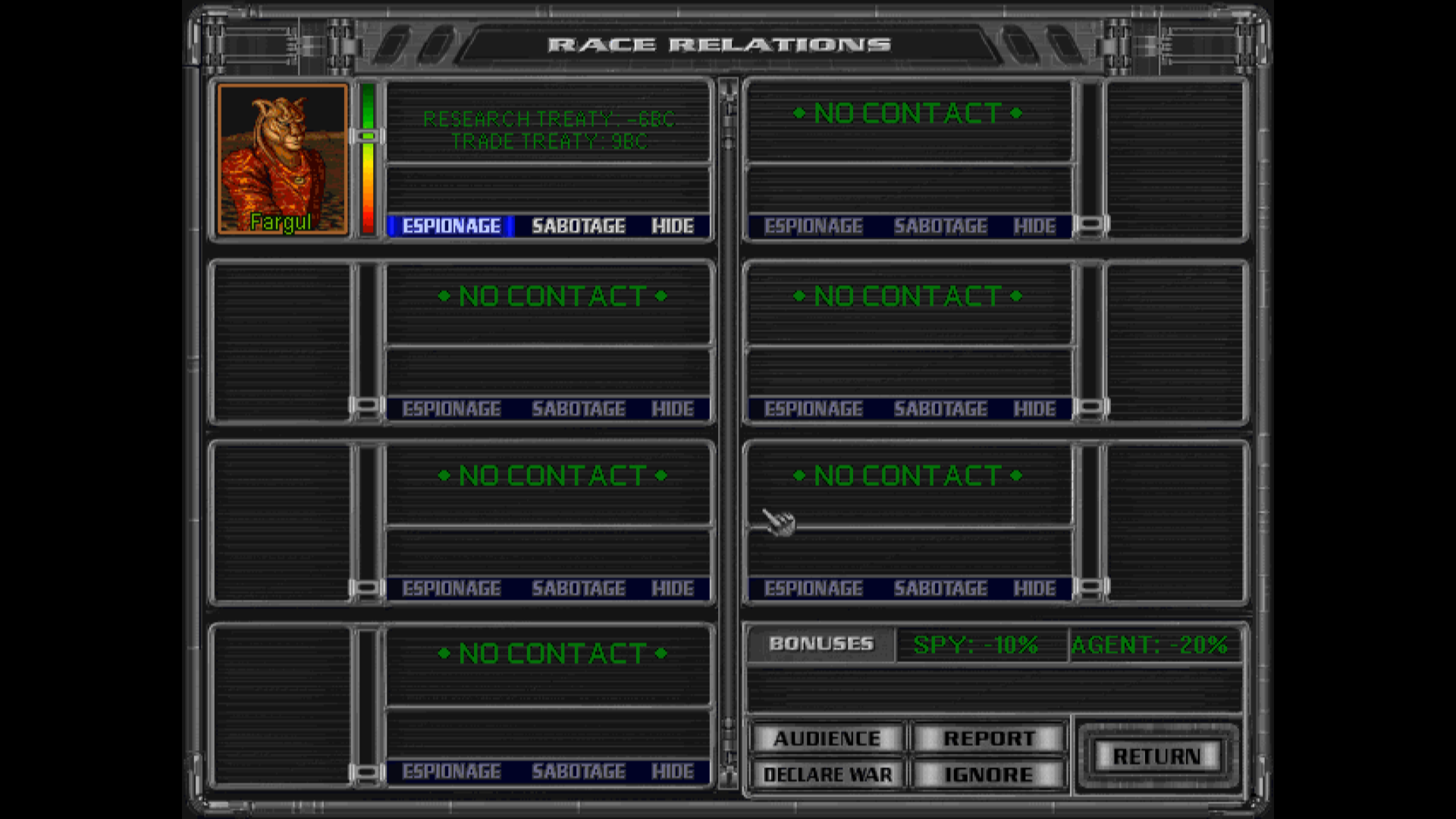 Trade with the Interstellar Union has provided many new goods for Narestan consumers, not least of which are personal weapons manufactured by Mrrshan arms manufacturers. The Mrrshan, for their part, import significant quantities of precision industrial machinery along with other products, providing profits for Narestan manufacturers and profits for shippers hauling goods to and from Union space. The establishment of communications channels between Narestan firms and their Mrrshan counterparts to set up collaborative research arrangements and publishing channels for academic papers has, thus far, produced little real good, while the expense of initial implementation is significant. Still, it is expected that a payoff will materialise within a few years. It costs a certain amount of money annually to initially set up trade or research agreements, but, thereafter, they start providing money or research points every year for both participants indefinitely.  Although much of the new investment capital generated by the growth of the Narestan economy has been dedicated to supporting a massive increase in raw industrial output and to the financing of new research arrangements, nonetheless the capital markets have seen a modest increase in liquid investment capital available each year. Industrial productivity and innovation, for their part, have seen explosive growth over the past twenty years, helping drive continued growth in standards of living. Narestan shipping capacity has increased, helping support the boom in trade enabled by contact with a new established civilisation, while the Intrepid and Venturer continue their voyages of discovery. The three Narestan colony worlds all contribute to Narestan prosperity, while Nares itself remains, by far, the economic center of the known galaxy. Investment Proposals Farming Leader Competition between agribusiness firms on Nares should lead to improvements in productivity at negligible initial cost, although method improvements may have some operating cost thereafter. Vote on whether or not to hire the farming leader. Although the farming leader is aggressively mediocre, they're the only colony leader available to us just now. Research Priorities Multiple different projects are receiving funding in Narestan R&D departments. Continued refinement of economic analysis and improvement in business methods is likely to lead to a boom in entrepreneurship and more efficient operations amongst existing firms, while several different research projects seek to develop new generations of computer technology for scientific or consumer applications. Heavy industrial firms have invested studies into improvements in material science and development of more efficient processing of industrial waste, while the improvement of ship drive systems remains a matter of some interest. Please vote between research goals in Economics, Scientific Computing, Consumer Computing, Materials Science and Chemistry, and FTL Drive Design. The two computing goals lead to mutually-exclusive applications, so choosing one will pass up the other. Colonisation Priorities The planet around Perseo seems an incredible prize, and is the focus of most attention for the next colony mission to depart from Nares. Mrrshan Technical Breakthroughs The diplomatic consortium dealing with the Mrrshan could potentially acquire two different technologies dedicated to thwarting hostile missile attacks- advanced electronic warfare to baffle the relatively limited seekers on shipkiller missiles, or high-manuever kinetic-kill light missiles that can successfully knock out shipkillers in flight. The Interplanetary Union will likely require Narestan technology transfer to approve Narestan firms acquiring these technologies, however, and there is some question of just how much technology Narestan firms are willing to share. Give me an idea of just how much you want ECM Jammer and Anti-Missile Rockets. We'll have to trade away one technology for each- probably one with a higher research cost than the technology to acquire- but I'd like to hear what people would consider acceptable trades for each. The Mrrshan will suggest the trade price, so I can't make specific offers, unfortunately. Contact with a new civilisation, however repressive and unpleasant to Narestan sensibilities, has nonetheless provided vast new wealth in trade to join with continued economic development through Narestan innovation. The future, on balance, seems bright. nweismuller fucked around with this message at 02:47 on Mar 27, 2017 |
|
|
|
Wayne posted:* Not sure which techs you're referring to on the computer options, so when in doubt go Science! The two computer options in question are Planetary Supercomputer and Holo Simulator. I happen to be quite fond of Holo Simulators, actually; they make everything run more smoothly on all levels, and still end up boosting science, even if not as much. Planetary Supercomputers are still awesome, though.
|
|
|
|
Wayne posted:Interesting. I grabbed that for the first time this game because Feudals are garbage at research anyway, so I figured I'd get research labs + autolabs and steal the rest (and then ended up stealing autolab anyway, heh). It was pretty underwhelming, and if you invest in androids later in the tech tree, it doesn't help them anyway. Not true! At least for Android Workers, morale bonuses work perfectly well, despite what is claimed by the game.
|
|
|
|
Sedesen Fine Imports Rifles, Enamel Artworks, Data Records, and Curios of Mrrshan Origin [image: A table spread with several rifles, enamel plates, and various knick-knacks of alien origin.] With the opening of Mrrshan markets, the products of an entirely alien tradition of arts and culture now can be brought to the Narestan consumer, and Sedesen Fine Imports is very pleased to offer a selection of Mrrshan consumer items to its customers. Rifles Mrrshan personal armaments are products of a tradition of deep craftsmanship and dedication to quality. Even the simplest and cheapest models we have imported, if simple in design, sport excellent accuracy at all effective ranges and are fine items for the dedicated marksman. More elaborate examples of the craft exhibit hand-customised components, engraving, and inlay to create weapons that are themselves one-of-a-kind works of art. [image: A rifle with a reddish wooden stock, darkened steel barrel, and brass accent fittings. The stock is carved on either side with elaborate knotwork designs, while engraved lines down the barrel inlaid with gold make a striking contrast to the dark metal.] Enamel Art A long tradition in the dominant Mrrshan culture of decorative art is of decorative enamel plates set into the walls of dwellings. The vivid colors and striking scenes depicted help provide a window into a culture very different from our own. [image: An enamelled ceramic plate, about a foot on a side, done in bold colors with stylised forms, depicting a Mrrshan in metal helmet and metal-reinforced leathers, plunging a spear into the throat of a shaggy beast larger than he is, with long claws and teeth. The claws and teeth are very white, and the blood flowing from the spear wound very red.] Data Records A sampling of the literature, music, and images of famous artworks and architecture of Mrrshan history are available for study and enjoyment. The library of translated literary works is still limited, but self-study courses for Mrrshan languages are also available. [image: A computer screen covered in text in an alphabet unfamiliar on Nares.] Assorted Curios Artifacts of Mrrshan daily life and culture of various sorts are available for the collector. Check our online catalogue for what is available with current shipments. [image: Mrrshan garments, tablewares, vases and pots, and jewellry, spread for display.] Sedesen Fine Imports- bringing the alien into the homes of the public. [data address: Sedesen Fine Imports network site, Nares planetary network] nweismuller fucked around with this message at 06:05 on Oct 19, 2016 |
|
|
|
Looks like we'll grab improved FTL early on, but that takes a short enough time that we need a tiebreaker between Economics and computing for advanced research for our second priority. First vote cast will break the tie, and I'll play through as soon as I notice it.
|
|
|
|
No, let's let somebody who didn't vote on one of those two initially decide.
|
|
|
|
Economics it shall be. OK, going to play through the update.
|
|
|
|
Quick question for the first person to respond- prefer colonisation to the Terran world around Perseo, or a small, barren, ultra-rich world that would serve as an excellent industrial hub despite small populations?
|
|
|
|
my dad posted:Yeah. It should be really easy to use it to leapfrog a colony base to the terran planet as soon as the industrial base is up and running. They're in different systems, I want to clarify- I only discovered the ultra-rich in Yhe this update. But what's done is done, and Yhe is colonised.
|
|
|
|

|
| # ¿ May 19, 2024 17:28 |
|
Life in the Machine  In 501, Sedos Voidcraft Drive Systems reported the development of a new line of FTL drives capable of taking advantage of the massive power output of modern fusion drives. At slower-than-light speeds, the new technology would help improve acceleration and maneuverability, but at faster-than-light speeds, the improved power output of the drives should allow for no less than a 50% improvement in travel speeds. Improved travel speeds cut down the time needed for travel and trade, helping knit Narestan civilisation more tightly together across its sprawling breadth, and helping make the Mrrshan somewhat less inaccessible. Only the following year, the board of the diplomatic consortium worked as go-betweens for negotiations that ended in Mrrshan defense industries transferring plans for advanced electronic warfare suites to Narestan shipbuilders, Narestan agricultural firms sending information and experts to help with training necessary to deploy genetically-engineered fertilisation microorganisms in the Interstellar Union, while Narestan shipbuilding firms arranged to make financial compensation to the agricultural firms involved in the deal. Some analysts expressed hopes that improved agricultural productivity in the Interstellar Union might eventually result in enough economic growth to improve the Union's position as a trade partner.   The systems of Esper and Yhe were explored in that same year of 502. Although Esper was a brown dwarf with no bodies of particular note orbiting it, Yhe possessed a pair of potentially-colonisable planets, one which was notable for immense lodes of heavy metals a short distance under the planetary surface. Yhe II, shortly after dubbed 'Renar', even had bare lodes of metallic tungsten and iron thrusting above the surface in multiple places.  The colony at Sadesal had, for a number of years, served as a port of call for settlers establishing themselves on the first planet of the Vij system, Tanan, and by 506 the population on Tanan had passed a billion, forming a stable, economically-viable population. Investment capital promptly flowed into Tanan's young industries, helping establish the local economy more firmly within its first few years of existence.   Continued contact with the Interstellar Union and study sponsored by the Consortium for Xenogovernmental Negotiations and various companies marketing to Mrrshan clients eventually resulted in the development of a systematic, scientific study of Mrrshan psychology as it differed from Narestan psychology, with expert xenopsychologists on staff in diplomatic and marketing departments. Using the insight provided by these new advisors and the existing history of friendly trade between Narestan civilisation and the Mrrshan, the Consortium for Xenogovernmental Negotiations succeeded in writing up a treaty that was accepted by the Interstellar Union, confirming that the Interstellar Union would not engage in wars against Narestan population centers as long as Narestans refrained from threatening the Interstellar Union.  In 493, the Narestan colonists in the Vij system found themselves contacted through the short hyperspace path between Vij and Ktynga by scouts of another starfaring species, the Meklars, themselves unified under an authoritarian bureaucratic state under an Autarch. The Consortium for Xenogovernmental Negotiations found itself expanding its operations from dealing solely with the Interstellar Union to also handling negotiations with the government of the Autarchy, helping provide some layer of representation comfortable for foreign governments to negotiate with.     Early negotiations with the Meklars resulted in the Autarchy permitting trade and traffic across the borders of the Autarchy, and approving cooperation agreements between researchers and scientists in the two civilisations. Meklar equipment for improved redundancy and reinforcement in ship design and expanded, high-powered scanning arrays that could have application both in long-range information gathering and in tracking movements of nearby targets in realtime were made available to Narestan firms, in exchange for certain Narestan advancements in industrial processes and shipbuilding. Advanced Damage Control, amusingly, doesn't actually do anything for the Meklars- they repair any damage they take after battle anyhow.  The Meklars are an invertebrate species, naturally both weak and possessing fragile constitutions highly vulnerable to life-threatening cancers. As they finally entered their industrial era, their technological advancement began focusing heavily on prosthetic organ implants that could sustain Meklar life even after organ failures and limb replacements, which helped drive the development of viable cybernetic interfaces for Meklar very early in their technological cycle. Armored cybernetic exoskeletons that protected Meklar against external hazards and boosted their strength grew increasingly more widespread, while many Meklars continued on permanent life support, many of their organs scooped out and replaced with mechanical implants. The Autarchy is descended from a quasi-religious ideology that arose holding that cybernetic augmentation was not only a pragmatic adaptation, but a transformative evolution of Meklar nature that should be aggressively spread to the whole species, which eventually overcame other nation-states that either rejected this ideology, or, in the most reactionary cases, rejected cybernetics altogether. The modern Autarchy is a ruthlessly pragmatic state that combines ideological education across the population and unquestioned authority centralised in the Autarch with a deliberate policy of academic freedom for researchers and pragmatic allowances for certain amounts of personal and economic freedoms for the general populace so long as they do not threaten the Autarch's authority or the official ideology. Meklar industrial workers can be surprisingly effective, adapting their exoskeletons to specific industrial tasks, while Meklar agricultural needs are sharply curtained given the deliberate policy of replacing many internal organs with artificial life support. Modern Meklar personal naming deliberately takes a mechanical pattern, reflective of their 'advanced', 'evolved' nature.  Two years after the Meklar contact, a colonisation mission to Renar established a new colony on the barren world. Mining operations promptly started, processing the immense mineral wealth of the planet into equipment needed to establish a thriving colony, even as investment capital from other planets in the civilisation began flowing into Renar. The world began developing rapidly.         The years from 515 to 520 saw the Intrepid and Venturer continuing out to further chart the unknown, with four more systems surveyed and catalogued. Gontzol, surveyed in 520, proved to be home to a bizarre crystalline organism that attempted to fling an artificially-induced microsingularity at the Intrepid. The Intrepid, fortunately, avoided the first attack even as the microsingularity decayed into an enormous burst of Hawking radiation, and charged up its FTL systems for an emergency jump into hyperspace back to Narestan space. It seemed likely that Gontzol would not be accessible to the Narestans for some time, despite the evident riches of the system in lush biosystems and mineral wealth.  Meanwhile, the Consortium for Xenogovernmental Negotiations had finished the needed negotiations to establish a hopefully permanent peace between the Autarchy and Narestan civilisation. Hopes were high that trade would continue to benefit both Narestan and Meklar civilisations into the future. Narestan Civilisation as of 520  The population of Nares has stabilised at approximately sixteen billion, with birth rates dropped to nearly match death rates. What population growth does exist is largely absorbed by emigrants signing on for new colonisation missions to further worlds. A rigorous focus on efficiency in Nares' agricultural sector has seen agricultural employment continue to drop over the past twenty years, now standing at only approximately 200 million. The solid prosperity of the planet makes it the richest in all known space, and an immense center of innovation, invention, and scientific endeavor.  Sedal, like Nares, has a population stabilised, this time at approximately four billion. What population growth it has fuels a slow stream of emigrants that enlist for new colonisation programs. Despite the expenses of survival in the harsh irradiated environment of Sedal, the planet is solidly prosperous, and now serves as the headquarters for several security contracting firms helping provide services to protect the physical and intellectual property of other firms.  Sadesal's population now exceeds three billion, with a notable and active research community and a local shipyard and defensive station nearly completed. Sadesal is a firm linchpin of trade between Narestan worlds, and an important stopover for Mrrshan and Meklar traders to Narestan worlds, the gateway for many exotic goods.  Tanan, although it has completed a major spaceport complex, is as of yet only a minor contributor by value to interplanetary trade, although its agricultural surpluses ensure that Sadesal remains fed. Its industrial base is being steadily built up, while relying heavily on imports from other worlds with sufficiently large economies to maintain the necessary specialty industries to maintain complex modern infrastructure.  Talesen's growing population has helped develop local specialty industries sufficient to maintain its infrastructure, while still trading valuable equipment and goods to other planets. Local hydroponic agriculture can still support the whole population, but agricultural exports have now largely evaporated. Local industry is not up to the first tier of productivity seen in older Narestan worlds, but factory modernisation and increased installation of robotics in its mines is well under way.  Renar maintains a respectable, if basic, infrastructure of local industry, hydroponic agricultural industries, and high-tech industries and basic scientific gathering. The incredibly rich metals deposits here have speeded the productivity of the factories on the surface, helping rapidly assemble spaceport facilities on the planet. Despite its evident bright future, Renar's still-small population demands reliance on the more-established industries of planets further in Narestan territory.  Commerce with the Mrrshan and Meklar species and collaboration with their researchers has provided steadily-growing benefits to Narestan consumers, importers, and exporters, although concerns about the security of corporate property in the presence of their governments has led to the slow growth of a disjointed array of corporate internal security protocols and contractors hoping to safeguard against potential theft. Although this is a significant expense, nonetheless this expense is swamped by the profits of trade beyond Narestan territory.  Growing populations, trade, and development have led to a growing Narestan economy, with a significant flow of investment capital every year and a massive growth in innovation over the past twenty years. Economic studies and refinement of business methods continues year after year, and is likely to have incredibly dramatic effects on the Narestan economy before long. Investment Proposals Research Priorities Breakthroughs in economics are likely help free up capital for other projects in the very near future. Improvements in materials science and industrial waste processing are favored by many heavy industrial concerns, while consumer optronics firms see immense profits in pushing the bounds of consumer hardware even further. Some scientists and research departments, for their part, prefer to focus on developments in optronics focused on massive scientific supercomputers to handle large-data problems of the sort they routinely tackle. Please vote on Materials Science and Chemistry, Consumer Optronics, or Scientific Optronics for investment. Vote also on more immediate developments in optronics, between high-precision exploratory instruments and improved security technologies available through refinements of current optronic technology. Meklar Research Data It is believed that Meklar weapons manufacturers have developed powerful and effective kinetic weapons for space-based use, likely to outperform many other direct-fire weapons that could be developed in the future and likely to be a highly effective weapon system if adapted for attack boats. Improved economic sciences and business methods derived from them may well prove to be sufficient to arrange for this technology to be released to Narestan firms. Please vote on whether to trade our upcoming Planetary Stock Exchanges for Mass Drivers from the Meklars. Colonisation Priorities   The two radiation-blasted but metals-rich worlds of the Dunatis system, the lush and Nares-like planet in the Perseo system, and a planet with relatively small oceans and limited rainfall supporting a stable, if water-poor, biosystem around Tur are the most immediately appealing targets for future colonisation. Funds raised for new settlement slowly shape which way the next colonisation mission shall go. Please vote on the next planet to colonise. Security and Shipbuilding Some security contractors believe that establishing an effective space-based presence to respond to potential threats could enhance their value. Many of these look to Renar as an eventual headquarters, given that it is likely to be able to easily support a powerful shipbuilding industry, but establishing temporary security shipbuilding programs around Sadesal may allow for earlier establishment of response forces. Please vote on whether to start shipbuilding on combat-ready ships soon, or to wait until we get our industrial superworld up and running. The Narestan people steadily spread across the stars, driven by their vigorous economy and eagerness to exploit the stars, enjoying the fruits of growing trade with strange cultures. It seems, on balance, to be a fine time for the Narestan species.
|
|
|



